Evaluation of the implementation of prepacked for direct sale (PPDS) allergen labelling requirements
An evaluation of the implementation and effect of the updated prepacked for direct sale (PPDS) allergen labelling requirements.
Introduction
The Food Standards Agency (FSA) and Food Standards Scotland (FSS) play an important role in ensuring members of the public with food hypersensitivities are protected from potentially life-threatening reactions. They work with the food industry to ensure that food labelling allows consumers with food hypersensitivities to make informed, safe choices.
In December 2014, food labelling and allergen information requirements were updated. Food Business Operators (FBOs) were then required to provide allergen information for non-prepacked foods, including those prepacked for direct sale (PPDS). PPDS foods are those that are packed before being offered for sale by the same food business on the same premises or location (or from moveable or temporary premises). The law at this time allowed for allergen information for these foods to be communicated in writing or verbally.
In 2016, Natasha Ednan-Laperouse died from an allergic reaction to a baguette which was PPDS. Following this, there was a campaign for the expansion of legislation to bring the labelling requirements of PPDS foods more in line with prepacked foods. Under this legislation, often known as ‘Natasha’s Law’, it has been a legal requirement since 1 October 2021 for PPDS food labels to clearly display the name of the food and a full ingredients list with the 14 regulated allergens emphasised within the list.
One year after it became a legal requirement across the United Kingdom (UK), the FSA and FSS wanted to evaluate its implementation and the effect it has had on three key groups: Food Business Operators (FBOs), Local Authorities (LAs) and consumers with food hypersensitivities (FHS).
This evaluation aimed to understand:
- Awareness of the new requirements across FHS consumers, FBOs and LAs
- Uptake and compliance with the new requirements
- The effect of PPDS legislation
- LA experience of supporting compliance
- Success factors and lessons learned from the implementation of PPDS legislation and how this could be applied in future.
IFF Research were commissioned to conduct this evaluation on behalf of the FSA and FSS, taking a mixed-method approach. A quantitative survey was conducted with each of the key audiences followed by qualitative interviews between November 2022 and February 2023: (footnote 1)
- Consumer research: A total of 1,809 consumers who either had a food hypersensitivity themselves (n=1,610) or had a child with a food hypersensitivity (n=199), most of whom (92%) had an allergy to at least one of the 14 regulated allergens, took part in an online survey. This included consumers residing in England (n=1,539), Northern Ireland (n=102) and Wales (n=168), consumers in Scotland were not included in the research as FSS are conducting their own research which will be published separately. A total of 31 consumers also participated in a follow-up qualitative interview.
- FBO research: 900 FBOs across the UK took part in a telephone survey, this included FBOs in England (n=612), Northern Ireland (n=52), Scotland (n=161) and Wales (n=75). A total of 19 completed a follow-up qualitative interview, 5 of whom were market traders.
- LA research: All 398 LAs across the UK were contacted to take part in an online survey, with 126 completes across 124 different LAs, (footnote 2) in England (n=85), Northern Ireland (n=11), Scotland (n=20) and Wales (n=10). A total of 21 LAs also took part in a follow-up qualitative interview.
Awareness and understanding of PPDS labelling requirements
Awareness of the term PPDS was fairly low among consumers with a food hypersensitivity (26%). Once defined to consumers as: ‘Pre-packed for direct sale (PPDS) foods are packed on the same premises as they are being sold to consumers and where the food is packed before being offered for sale to customers’, around half of consumers (52%) reported it would be difficult for them to identify whether food was PPDS or not.
Awareness among consumers of the new PPDS labelling requirements was higher than the term PPDS itself, with the vast majority (87%) stating they had heard of it, though only a smaller proportion had detailed knowledge of it (18% stated that they knew quite a lot about it, 40% said they knew a bit about it and 24% did not know much about it). Awareness being much higher for the labelling requirements, compared to the definition of PPDS foods, could be due to the media coverage of Natasha Ednan-Laperouse’s death, this was cited by most consumers in the qualitative interviews.
With regards to knowledge of specifics of PPDS labelling requirements; around eight in ten (78%) consumers believed that FBOs were legally required to provide a full written ingredients list on PPDS foods. Consumers shared whether, in their view, PPDS foods only needed to be labelled with information about whether they contain any of the 14 specified allergens, rather than with a full ingredients list; only a fifth (21%) agreed with two thirds (67%) disagreeing, indicating a preference for a full ingredients list.
Around two-thirds (66%) of FBOs were aware of the term ‘prepacked for direct sale’ (PPDS) before participating in the research, though once shown the definition most (over 80%) were clear on the various aspects of the PPDS definition. These aspects included:
- What the definition of packaging is (94% clear)
- When food is placed into packaging (92% clear)
- Whether how accessible an item of food is to consumers matters (91% clear)
- Which foods meet the definition of PPDS (91% clear)
- Where packaging needs to take place for an item to count as PPDS (90% clear)
- Which premises constitute part of the same food business (82% clear)
In addition, the vast majority of FBOs (91%) were aware of the PPDS labelling requirements, specifically that on 1 October 2021 it became a legal requirement to label PPDS foods with the name of the food and a full ingredients list, with allergenic ingredients emphasised within the list. High levels of awareness were also demonstrated throughout the qualitative interviews, though some FBOs did explain that they faced a steep learning curve initially, due to having previously not used the term PPDS. From a LA perspective, they also tended to believe that FBOs had good awareness and understanding of requirements.
LAs were also asked, like FBOs, if they were clear on each of the aspects of the PPDS definition mentioned above, with 57% clear on all aspects, and over 80% clear on each individual aspect. Qualitative interviews showed that LAs who took part in the research had a high level of understanding of the labelling requirements, though there were pockets of confusion and uncertainty around specific foods and packaging. A key example of this confusion included specific foods at takeaway premises that are made in bulk then prepacked ahead of an order and bundled later with an order of non-prepacked food, such as prawn crackers and condiments.
Experience of PPDS labelling requirements
Consumer purchasing behaviour, experience, and confidence in PPDS labelling
It was uncommon for FHS consumers to purchase PPDS foods often (7%). Instead, most consumers reported buying PPDS foods sometimes (36%) or rarely (40%). The nature of consumer’s food hypersensitivities tended to contribute to their likelihood to purchase PPDS foods. Those with allergies and intolerances other than Coeliac disease were more likely to do so than those with Coeliac disease (92% vs 89%) and those with a mild (97%) or moderate (96%) allergy or intolerance were more likely to purchase PPDS foods that those with a severe allergy or intolerance (87%). For a number of consumers in the qualitative interviews, concerns over allergen cross-contamination meant they were unlikely to purchase PPDS foods or to only do so as a last resort.
More than nine in ten consumers surveyed purchased PPDS foods (91%). Of these, four fifths (81%) reported checking labels on such products every time a purchase was made and a further 10% reported doing so most of the time. Ease of identifying PPDS foods may contribute to this figure, given half of consumers find it difficult to identify PPDS foods. Consumers who found it difficult were more likely to check the labels more often (95% always or most of the time vs 88% of those who find it easy).
Amongst those that checked the labels of PPDS foods, only one in twenty (5%) reported that they were always able to access the information they needed to be able to identify whether it contains an ingredient that would cause an unpleasant reaction. Of the remainder, a third (34%) said that the information they required was available most of the time, a fifth (21%) said it was available about half of the time, and a quarter (25%) felt it was occasionally available. A further 4% said the information was never available. Again there was an association with ease of identifying PPDS foods, those who found it easy to identify PPDS foods were more likely to find the information they need all or most of the time (59% vs 33% of those who found it difficult).
Linked to the above, since the new labelling requirements were introduced, almost two thirds (63%) of consumers who purchase PPDS had experienced issues accessing information on PPDS labels. The most common issue reported was allergen information not being easy to read (53%). This was caused by a variety of factors, including the font size on labels being too small (78% of those who reported allergen information not being easy to read) and labels being blurred or smudged (41% of those who reported allergen information not being easy to read). Other frequently encountered issues included allergens not emphasised on PPDS foods (32%) and PPDS products missing ingredients or allergen information altogether (29%).
Consumer confidence in the accuracy of PPDS labelling was mixed, with 58% confident and 30% not confident. In the qualitative interviews it was clear that a number of factors influenced consumer confidence, such as the type of FBO, how familiar consumers were with the site and staff, the design of labels (e.g. whether easy to read) and levels of concern regarding allergen cross-contamination.
Compliance with PPDS labelling requirements
Self-reported compliance among FBOs was reasonably high, with around three quarters (76%) of those that sold PPDS foods reporting full compliance with all aspects of the legislation. In other words, they displayed the name of the product, listed all ingredients and emphasised allergens on ingredients lists. Levels of compliance across these three aspects, was highest regarding emphasising allergens (89%), with 85% displaying the name of the product and 83% listing all ingredients. When FBOs did not comply with all three aspects, this was typically attributed to low awareness and understanding of the PPDS labelling requirements.
Retailers were more likely than caterers to self-report compliance (87% vs 66%), with particularly high levels amongst butchers (92%), general retail (86%) and bakers (85%). With regards to size, the likelihood to self-report compliance increased with employee headcount; two thirds (69%) of those with between 1 and 5 employees said they were compliant compared to 80% of those with between 6 and 10 employees and 87% of those with 11 or more employees.
LA perceptions of compliance with the labelling requirements were slightly different to levels of self-reported compliance amongst FBOs, with 62% describing compliance amongst the FBOs where compliance checks had been conducted as ‘good’ or ‘very good’. This figure is lower than the three-quarters (76%) of FBOs who self-reported compliance. This discrepancy may be due to LAs reporting on a larger sample of FBOs, compared to FBOs who are just reporting on themselves.
Amongst those that labelled all ingredients or emphasised allergens on the packaging of PPDS food (84%, n=781), the most common way this information was presented was through labels printed in-house (64%). During qualitative interviews, many of these FBOs said they had invested in labelling software and hardware to assist with compliance. A quarter (25%) of FBOs used labels printed by a third party, while 8% used handwritten labels and 6% used labels supplied by their head office.
Across all size bands and sectors of FBOs, the printing of labels in-house was the most common method of presenting ingredients information on PPDS foods. However, there were some types of FBOs that were more likely than average to use alternative methods. With regards to size, FBOs with between 1 and 5 employees were more likely than average to use labels printed by third parties (28%), and those with 11 employees or more were more likely than average use labels supplied by their head office (10%). In terms of sector, caterers were more likely than average to use handwritten labels (14%), particularly restaurants and cafes (15%).
Almost three quarters (72%) of FBOs reported using Precautionary Allergen Labelling (PAL) on their PPDS foods. The most common reason for using PAL was to flag the risk of cross-contamination during preparation (44%), however it was also used to ‘pass on’ PAL used on ingredients sourced from suppliers and wholesalers (28%).
Experience of compliance
FBOs generally reported that they found compliance with PPDS labelling requirements easy (81%). FBOs in England were more likely than those in Scotland and Wales to have found it easy (82% vs 71% in Scotland and 71% in Wales). So too were retailers compared to caterers (88% vs 76%) and those with 11 employees or more compared to those with fewer (87% vs 78%). In the qualitative interviews, some FBOs who reported that compliance was easy mentioned that they had experienced some challenges initially but had managed to overcome these.
For the one in ten (11%) FBOs who indicated in the survey that they continued to find compliance difficult, the two most frequently cited reasons were the time taken to introduce and update labelling (46%) and the cost of doing so (38%). Other factors included PPDS labelling not being top of mind for the FBO (16%) and lack of staff training and awareness (14%).
In contrast to FBOs self-reported experiences of compliance, close to nine in ten LAs (87%) felt that FBOs had found compliance with PPDS labelling requirements to be difficult. (footnote 3) Reasons given for this difficulty mirrored those given by FBOs, with the time taken to introduce and update labelling (84%) and the cost of doing so (83%) the two most frequently cited. However, LAs also mentioned causes of difficulty that were not mentioned by FBOs, notably technical limitations at the premises (83%), staff turnover (59%) and information not being available in languages others than English (48%).
Amongst the LAs that said FBOs had difficulty with compliance (87%, n=109), when prompted, around half (47%) identified smaller FBOs as those that have the most difficulty. A quarter (26%) highlighted takeaways as having particular difficulty with PPDS labelling requirements.
Support with compliance
There are various sources of support and guidance available to FBOs to learn about the PPDS labelling requirements and how to comply with them, and nearly all FBOs that sold PPDS and were aware of the new requirements (92%, n=838) had used at least one (97%).
The sources most frequently mentioned by FBOs included the FSA and FSS (67%), followed by LAs (47%) and Trading Standards or Environmental Health Officers (45%). FBOs were generally very positive about the guidance accessed from the FSA, FSS and LAs, with FBOs often mentioning they had used online resources such as written guidance and videos. When FBOs received support from their LA, this often occurred at the point of a visit or inspection. In the qualitative interviews, some FBOs did not access support from the FSA, FSS and their LA, most commonly because they did not feel they needed it or sought it elsewhere, such as their head office.
In terms of appetite for support to help make compliance easier, two thirds (68%) of FBOs did not feel they needed any, due to sufficient support already available. A quarter (25%) of FBOs felt they would benefit from additional information. This was more likely amongst delicatessens (52%) and catering businesses (39%) than average, and amongst FBOs with fewer than 10 employees when compared to those with 11 or more (28% vs 19%).
Despite a low appetite for additional support amongst FBOs, nearly all LAs felt that further action could be taken to make it easier for FBOs to comply with new labelling requirements (95%). These actions often related to additional support and guidance, with three quarters (75%) suggesting general training on how to comply with the requirements, and two thirds identifying a need for more guidance from the FSA and FSS on compliant packaging (67%) and best practice in terms of labelling (65%).
In addition, some LAs suggested that the PPDS labelling requirements should be altered. Two thirds (67%) said that suppliers and wholesalers should be mandated to notify businesses about recipe changes, and more than half (55%) said that the requirement to label PPDS foods with full ingredients lists should be removed, with the emphasis of the legislation being placed on allergens instead.
Compliance checks
LAs support FBOs with legislative requirements and generally have responsibility for the enforcement of food information legislation. (footnote 4) Almost all LAs that participated in this research had checked FBO compliance regarding PPDS labelling requirements since they were introduced in October 2021 (98%). The small minority (2%) of LAs that had not conducted compliance checks explained that this was because their team was not responsible for checking food business compliance.
Compliance checks were often conducted as part of routine food safety inspections (95%). 71% of LAs had also conducted reactive PPDS inspections (e.g. in response to complaints from consumers) and half (51%) conducted visits specifically focused on PPDS foods.
LAs reported checking various aspects of the PPDS labelling requirements during visits to FBOs. Nearly all LAs checked that allergens are emphasised in ingredients lists (98%), that the name of the food is displayed on packaging (97%), that there is a system for labelling in place (97%) and checked where food is packed (96%). In addition, 89% checked that all ingredients are accurately listed with the ingredients lists of PPDS packaging.
In the first year since the introduction of these legal requirements, nearly all LAs had encountered at least some cases of non-compliance (95%). Close to nine in ten LAs had observed there being no labels on the packaging of PPDS foods (89%), and more than four fifths had observed no ingredients lists (84%) and incomplete ingredients lists (82%).
Some LAs reported escalating incidents of non-compliance and taking enforcement action; written warnings had been issued by 40% of LAs, improvement notices had been issued by 8% and cautions had been issued by 2%. However it was more common for LAs to respond by signposting FBOs to guidance or support (91%) or by providing written (86%) or verbal (84%) advice. Many LAs explained that their focus for the first year of the PPDS labelling requirements had been to educate FBOs and support them with compliance rather than pursue enforcement.
A quarter (25%) of LAs found compliance checks difficult. The main reasons for this were: not having enough internal resource to visit and inspect all businesses to check for PPDS compliance (n=21/31), uncertainty around the definition of some or all PPDS foods (n=20/31) and difficulty checking the accuracy of PPDS ingredients lists (n=14/31). These sources of difficulty were also highlighted as challenges amongst those that reported finding compliance checks to be easy overall.
Amongst the LAs that had conducted compliance checks and found the process less than ‘very easy’ (87%; n=109), the top three things that they felt would make compliance checks easier were: more resources for LAs (e.g. funding and staff) (29%), greater clarity on what food products are covered by PPDS labelling requirements (22%) and materials for LAs to share with FBOs (e.g. guidance handouts) and issue to FBOs (e.g. improvement notices) (21%).
Nearly all LAs (99%) stated that they had conducted activities to support and increase compliance with PPDS labelling requirements since they were introduced. The most common activity was signposting to FSA and FSS guidance and resources (85%). Other actions included PPDS advice visits (52%), physical letters or newsletters (44%) and emails or digital newsletters (44%). LAs indicated in the qualitative interviews that they had typically undertaken a blanket approach to these activities. However, some took a targeted approach and focused their activities on FBOs where PPDS labelling was thought to be most relevant, such as bakers and butchers. Where LAs had not conducted activities, or conducted them to a lesser extent, this was generally due to a lack of resources.
Effect of PPDS labelling requirements
Effects on consumers
Findings from this research suggest that some consumers have seen positive impacts from the implementation of PPDS labelling requirements, but there is still a way to go. Where there have been positive effects of PPDS labelling requirements, these were more pronounced amongst younger consumers.
Just over two fifths (42%) of consumers felt that the availability of information needed to identify a food that may cause an unpleasant reaction had improved since October 2021. Younger consumers and more frequent purchasers of PPDS foods were more likely than average to report an improvement in the availability of information. Over half of those aged between 18 and 34 (52% vs 40% of those 35-64 and 65 and over) and those that purchased PPDS foods at least sometimes (51%vs 36% who purchase PPDS rarely or never) reported an improvement.
In addition, two-fifths (40%) of consumers agreed that their confidence in buying PPDS foods had increased since the PPDS labelling requirements were introduced. Consumers aged between 18 and 34 were more likely than older to have increased confidence (51% vs 40% of 35-64 years old and 36% of over 65 year olds). Furthermore, those who considered there to have been an improvement in the availability of information were more likely than average to purchase more PPDS foods since October 2021 (31%).
Two-fifths (40%) of consumers reported an improvement in their quality of life since the introduction of the PPDS labelling requirements. Consumers aged between 18 and 34 (43%) and those who purchased PPDS foods sometimes or often (48%) were more likely than average to report an improvement in their quality of life, alongside consumers with a child or children with a food hypersensitivity (50%) and those with an allergy or intolerance other than Coeliac disease (43%).
However, despite some changes in the perceived availability of ingredients information and confidence in buying PPDS foods which increased for around two-fifths of consumers, this did not often translate to behaviour change. Only a minority (17%) of consumers reported purchasing PPDS foods more often since the introduction of PPDS labelling requirements. Further exploration in the qualitative interviews showed that this was often due to concerns about the risk of cross-contamination.
Perceived changes in the availability of ingredients information on PPDS foods appears to be associated with the purchasing frequency of consumers, with those who felt there had been an improvement in this availability more likely than those who felt availability had stayed the same or got worse to purchase more PPDS foods (31% v 8% and 6% respectively).
The nature and severity of food hypersensitivities was also associated with the likelihood to buy PPDS foods more often since the introduction of labelling requirements. Specifically, consumers with severe allergies or intolerances (19%), consumers whose child had a food hypersensitivity (24%) and those with an allergy or intolerance other than Coeliac disease (20%) were more likely than average to purchase PPDS foods more often than before October 2021.
Effects on FBOs
For FBOs, the implementation of PPDS labelling requirements led to some changes and increased costs, though for others impacts were more minimal. There was evidence that the implementation of PPDS labelling requirements had affected the types of food some FBOs sold and their approach to serving FHS consumers. In addition, half of FBOs reported increased operating costs and administrative burden following the implementation of PPDS labelling requirements.
Half of FBOs (50%) stated that the new labelling requirements had increased their costs, mostly due to investment in equipment or materials and time spent preparing and applying labels. During qualitative interviews, most FBOs that had experienced an increase in costs explained that the most significant cost was the initial outlay on hardware and software. Many continued to face higher costs (e.g. the cost of materials and staff time to prepare and check labels of packaging) following this initial investment, but these were less significant that the set-up costs and did not pose an issue to the survival of the business.
A larger impact on FBOs related to their business practices, with eight in ten (81%) FBOs that sold PPDS foods reporting that they had made some changes to their business practices since the introduction of the labelling requirements. Most commonly, this was applying Precautionary Allergen Labelling (PAL) to their PPDS foods (59%) and starting to ask customers if they had food allergies or intolerances at the point of sale (41%). These changes had also been widely observed by LAs, with 61% reporting FBOs starting to apply PAL to their PPDS foods and 57% starting to ask customers if they had food allergies or intolerances at the point of sale.
Over a quarter (26%) of businesses changed the foods they sell, with 17% selling food that was previously PPDS as non-prepacked food, and 16% starting to sell more food packaged by other businesses. LAs were much more likely to have observed FBOs starting to sell food that was previously PPDS as non-prepacked food (79%) and FBOs starting to sell more food packaged by other businesses instead of PPDS foods (51%).
FBOs that had started to sell more prepacked and non-prepacked foods since the introduction of PPDS labelling requirements explained that the reason for this was to remove certain products from falling within the PPDS labelling requirements. The justification behind this was that the business would be unable to take on the additional administration and costs of packaging and labelling all PPDS products.
Most consumers (60%) had not noticed any changes in FBO behaviour since the PPDS labelling requirements were introduced. Where changes had been observed, the most common were an increase in the availability of food made to order (20%) and a reduction in the availability of PPDS foods (18%). Some consumers had observed food that was previously sold as PPDS being packaged differently, 16% noting an increase in prepacked food and 14% noting an increase in non-prepacked food.
A small proportion (9%) of FBOs that participated in the research did not sell PPDS foods at the time of the survey but had done in the past 12 months. A fifth (20%) attributed this to the introduction of PPDS labelling requirements, though change in customer preference (32%) and resource pressures (25%) were more common reasons.
Impact of new labelling requirements on LAs
Most LAs (92%) reported an increase in at least one aspect of their work following the introduction of the new PPDS labelling requirements. This was most often in time spent providing advice and supporting businesses (86%), time taken to conduct inspections when including PPDS (82%), time spent conducting administrative work associated with inspections (73%) and more time on resolving non-compliance and taking enforcement action (67%).
Amongst those that reported an increase in time spent conducting inspections, conducting administrative work associated with inspections and conducting enforcement/follow up action. This was typically estimated to take a maximum of 30 minutes longer per inspection.
-
Full sample breakdowns are included in Chapter 3: Methodology and sample profile, and further explored in the separate technical report.
-
In two LAs, two staff members took part in the survey. The methodology involved the survey being sent out to LAs as an open link, meaning it could be accessed by multiple staff at the local authority, leading to these multiple completions.
-
It should be noted that LA views on the extent to which FBOs have found compliance to be easy or difficult are not directly comparable to the self-reported experience of FBOs. The perceptions of LAs were based on observations made across multiple PPDS inspections, and there is a potential for them to be skewed by instances of non-compliance. Conversely, there is a possibility that the accounts of FBOs are influence by a self-report bias.
-
The only exception to this are District Councils in England, who do not have food standards enforcement powers.
| Technical term | Definition |
|---|---|
| Coeliac disease | An autoimmune disease where eating gluten causes the immune system to begin attacking the sufferer’s own bodily tissues in the gut. This can cause diarrhoea, weight loss, fatigue, bloating, and anaemia. |
| Food Business Operator (FBO) | The natural or legal persons responsible for ensuring that the requirements of food law are met within the food business under their control. FBOs were surveyed and interviewed for this study. |
| Food hypersensitivity | Eating certain foods or additives can lead to a bad physical reaction in some people. This food hypersensitivity can involve the immune system, in which case it is called a food allergy. Food hypersensitivity is the term used to encompass a food allergy, intolerance or coeliac disease. |
| Local Authority (LA) | The local organisation that is responsible for providing public services and facilities for a geographical area; a local council. |
| Non-prepacked food | These are foods that do not fall into the definition of pre-packed foods – they are sold unpackaged to customers or packaged on the sale premises only at the customer’s request. They are also referred to as loose foods. For example, loose fruits at a greengrocer’s or a meal in a restaurant. |
| Precautionary Allergen Labelling (PAL) | Food labelling that provides information about the potential presence of allergens that may unintentionally appear in food as a result of cross-contamination. This kind of labelling is currently not legislated but is done voluntarily by food producers. |
| Pre-packed foods | These are foods that are manufactured and packaged before being transported to outlets to be sold. For example, a packet of dried pasta on a supermarket shelf. |
| Pre-Packed for Direct Sale (PPDS) | Foods made and packed on the same premises as they are being sold before being offered for sale to customers. This could include, for example, cakes, pies and sandwiches which are made and packaged at the same premises from which they sold. Since 1 October 2021, it is a legal requirement for PPDS foods to clearly display the name of the food and a full ingredients list with allergens emphasised on packaging/labelling. |
Background to the PPDS labelling requirements
The Food Standards Agency (FSA) plays an important role in ensuring safeguarding of public health, namely protecting consumers in relation to food. Similarly, Food Standards Scotland (FSS) is the public sector body for food and related safety for Scotland. Part of these organisations’ work encompasses protecting members of the public with food hypersensitivities. This includes those with food allergies, intolerances, and Coeliac disease.
The FSA and FSS work with the food industry to ensure that consumers can identify what food they can safely eat through labelling on food items. In terms of packaging, there are three key types of food that is sold to consumers:
- Prepacked foods: foods put into packaging at a different location to where it is sold. For example, bags of crisps, breakfast cereals and ready meals.
- Foods prepacked for direct sale (PPDS): foods that are packed before being offered for sale by the same food business on the same premises or location (or from moveable or temporary premises). For example, sandwiches placed into packaging by the food business on site before being offered for sale to customers, cakes a baker puts in a box on their premises, and burgers or sausages prepacked by a butcher and sold on the same premises or market stall.
- Non-prepacked (loose) foods: foods that are sold ‘loose’ without any packaging, or are packed at the request of the consumer. For example, foods sold from a delicatessen (e.g., cold meats and cheeses), bread or pastries sold in bakery shops or a meal in a restaurant.
In December 2014, the EU Food Information to Consumers (FIC) Regulation and Food Information Regulations (FIR) made it a legal requirement for UK Food Business Operators (FBOs) to provide information on the 14 regulated allergens for non-prepacked (loose) foods including those sold as PPDS. This legislation states that FBOs can provide this information in written or verbal form, whereas for prepacked food, allergens have to be provided in written format.
In 2016, Natasha Ednan-Laperouse died after suffering an allergic reaction to sesame whilst eating a baguette. This was a PPDS food and triggered a major campaign for the legal requirements on PPDS to be tightened, given previous legislation did not specify that PPDS food required labelling. This new legislation was laid in England 2019, with Northern Ireland, Wales following suit in 2020 and Scotland in 2021, with the law across all countries coming into force on 1 October 2021. This new legislation is often referred to as ‘Natasha’s Law’ and requires PPDS foods to be labelled with the name of the food and a full ingredients list with allergens emphasised within the list (e.g. in bold).
In terms of responsibility, FBOs have an obligation to ensure that they are abiding by laws relating to the provision of allergen information across all food types, with Local Authorities (LAs) supporting and enforcing compliance with the legislation.
Research objectives
The FSA and FSS commissioned research to evaluate the implementation of the new PPDS legislation and the effect it has had on the three key audiences: consumers who have a food hypersensitivity (FHS consumers) across England, Northern Ireland and Wales and FBOs and Local Authorities (LA) across all four nations (footnote 1).
In particular, the research aimed to understand:
- Awareness of new requirements across FHS consumers, FBOs and LAs
- Uptake and compliance with the new requirements, including changes in business behaviour with regards to the types of foods they sell
- The effect of PPDS legislation on FHS consumers
- LA experience of resources to support compliance provided by the FSA and FSS and those offered and developed by LAs, and to understand whether additional support and resources are required
- What critical success factors and lessons learned can be gained from the implementation of PPDS which could be applied in future
Throughout this report, findings from previous research related to allergen labelling will be referenced where appropriate to further understand any potential changes due to the introduction of the new legislation. These previous research projects include a 2020 baseline telephone survey with FBOs (footnote 2), Food Sensitivities Survey with FHS consumers in 2021 (footnote 3) and research with LAs conducted internally by the FSA between April and May 2022.
Methodology
A mixed-method approach was undertaken for all audiences included in the research, with quantitative surveys followed by in-depth qualitative interviews. An overview of the methodology and completed interviews is shown in Figure 2.1. The specific details of the methodology are covered in Chapter 3.3.
Figure 1 - overview of methodology
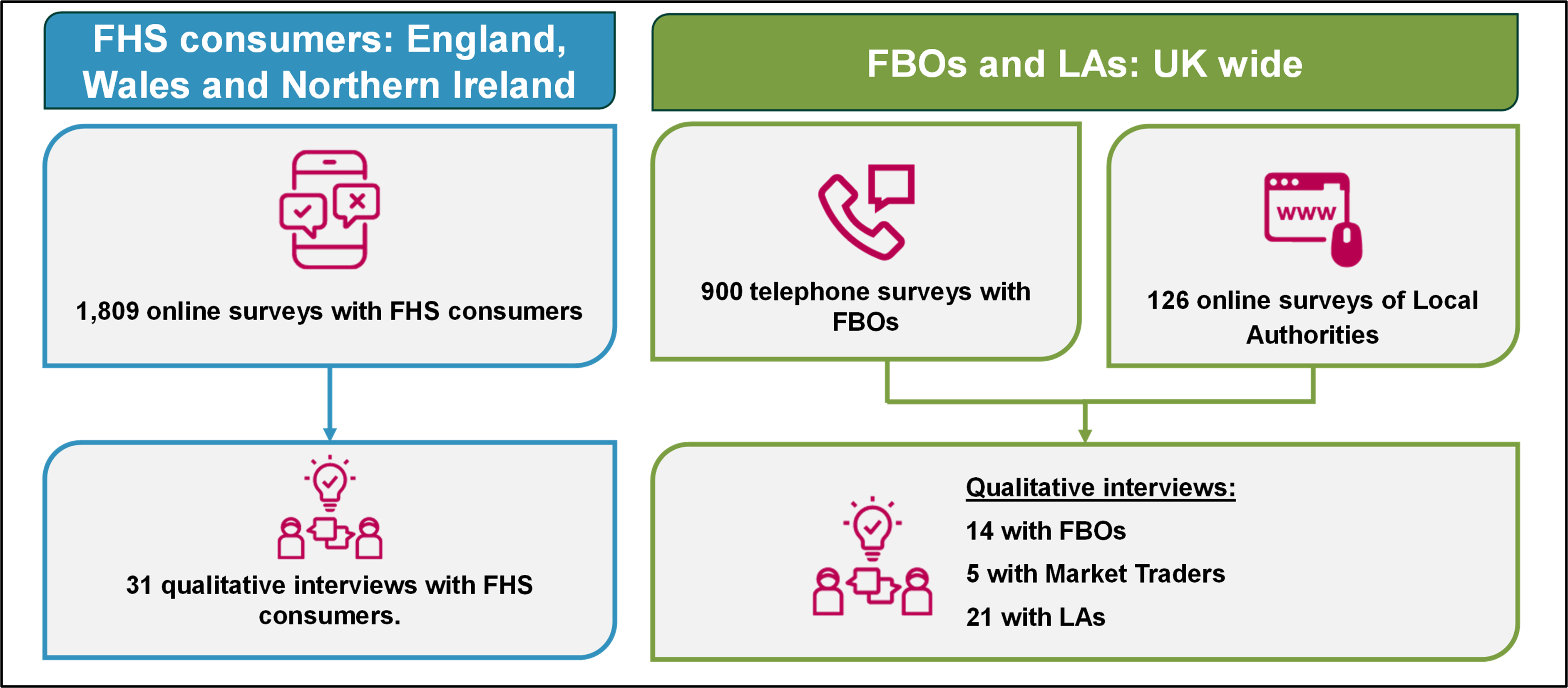
Analysis and reporting
Quantitative analysis
Once fieldwork was complete, a set of data tables was produced for each of the audiences which encompassed all questions and contained breaks for key subgroups to allow for analysis of potential significant differences by these groups.
All differences noted between sub-groups are statistically significant to a 95% confidence level: by convention, this is the statistical ‘cut off point’ used to mean a difference is large enough to be treated as genuine. This means the significant differences noted throughout this report have a 95% chance of being ‘true’ (i.e. due to a genuine difference in the groups being compared, and only a 5% chance that the results are due to chance). In some cases, the report refers to a subgroup being ‘more’ or ‘less’ likely than average, this means that this subgroup is significantly different to the average, excluding the subgroup in question.
Where possible, comparisons have been made to surveys conducted prior to this research. Where comparisons are made and a difference is highlighted, this is also significant to a 95% confidence level.
The majority of the quantitative findings are reported as percentages, however, where the overall base size is lower than 50, these findings are reported using numbers.
Qualitative analysis
Findings from qualitative interviews businesses are integrated throughout. All interviews were written up into an analysis framework, which were structured under headings relating to the objectives, allowing discussions to be compared and judgements made about the commonality of experiences. The framework also allowed identification of any trends by different subgroups. An analysis session was then conducted to discuss initial interpretation of the findings and compare the emerging narratives to understand the key messages from the interviews.
It should be noted that findings from qualitative fieldwork provide insight into perceptions, feelings, and behaviours rather than quantifiable findings from a statistically representative sample. Because qualitative samples are small and purposively designed, the findings cannot be considered representative of the views of all stakeholders.
-
Food Standard Scotland did not partake in the consumer research because they are conducting their own research with FHS consumers in Scotland which will be reported separately.
-
The Food Industry’s Provision of Allergen Information to Consumers
Methodology overview
In order to develop a full picture of the awareness, understanding and impact of new PPDS labelling requirements, the research focused on three groups of stakeholders:
- Consumers in England, Northern Ireland and Wales who have at least one existing food hypersensitivity or a child with a food hypersensitivity
- FBOs with up to 249 employees across the UK
- LAs responsible for enforcing food safety regulations across the UK
A mixed-method approach to the research was adopted:
- Firstly, individuals from the three target groups were invited to complete surveys. Each group received a different survey that was specific to their engagement with PPDS labelling requirements.
- Secondly, some of those who took part in the surveys were then invited to take part in an in-depth interview to expand upon the information they gave in the survey. Again, there were three different topic guides used to structure interviews, which were designed to capture the nuances of each group’s experience.
The details of engagement with each group are shown in Table 3.1.
Table 3.1 Summary of methodology and completed interviews
| Method | Overview |
|---|---|
| Online survey with consumers |
|
| Qualitative interviews with consumers |
|
| Telephone survey of Food Business Operators (FBOs) |
|
| Online survey with LAs |
|
| Qualitative interviews with FBOs, Market Traders and LAs |
|
Consumers
Methodology
A total of 1,809 consumers with food hypersensitivities, or with a child with a food hypersensitivity, residing in England, Wales and Northern Ireland completed the online survey between 29 November 2022 and 13 January 2023. Consumers were approached through a range of sources:
- An external panel provider, which recruited 400 consumers who completed the survey.
- Three food hypersensitivity charities (Coeliac UK, Allergy UK and The Natasha Allergy Research Foundation), who shared an open link to the survey on social media and their newsletters.
- The FSA, who shared an open link to the survey on their social media towards the end of fieldwork with a specific aim to boost response rates in Wales and Northern Ireland.
The survey was approximately 15 minutes long and encompassed a number of topic areas: the nature of consumers’ food hypersensitivity; their use and confidence in food labels (both generally and specifically regarding PPDS foods); their awareness of new labelling requirements; their experience of buying PPDS foods since the introduction of the legislation; and the impact it has had for them. In the cases where the consumer had a child with a food hypersensitivity, the same topic areas were covered but framed in regards to their experience of purchasing PPDS foods for their child.
Consumers who completed the survey via an open link from a charity and the FSA indicated at the end of the survey whether they would be happy to be recontacted for a follow-up interview. A total of 659 consumers agreed to be recontacted, representing 53% of those asked.
A total of 31 consumers took part in a follow-up in-depth telephone interview, which explored their experiences in more detail. Broad targets were set to ensure the perspectives of a variety of consumers were captured; by country, severity of allergy, whether or not they had coeliac disease and whether they had a food hypersensitivity or their child did. In addition, a spread of awareness of legislation, PPDS purchasing behaviour and potential impact of the legislation were targeted. These interviews took place between 19 December 2022 and 11 January 2023, and lasted 45-60 minutes.
Sample profile
The FSA were keen to understand the perspective of consumers with their own hypersensitivity, and the experiences of those who have a child with a food hypersensitivity. Almost three quarters (74%) of consumers who completed the survey indicated they had a food hypersensitivity and around one in ten (11%) of all respondents stated that their child had a food hypersensitivity. A further 15% indicated that both they and their child had food hypersensitivities; this latter group responded to the survey regarding their own experience, rather than that of their child.
The severity of food hypersensitivity varied; over half of consumers (56%) stated that their food hypersensitivity was severe. Around a third (34%) indicated theirs was moderate and 8% felt theirs was mild. This rating related to the allergy or intolerance they felt to be the most severe if they had multiple allergies. Two in five (42%) consumers in the survey reported having multiple allergies.
Overall, three-quarters (73%) of consumers had an allergy or intolerance to a regulated allergen only, with a further 19% having an allergy or intolerance to both a regulated and non-regulated allergen. The food which consumers had an allergy or intolerance to varied, with the most common being cereals containing gluten (65%). Almost half (46%) of surveys completed were obtained from Coeliac UK, which is likely to contribute to this prevalence. Of consumers who stated they had a food hypersensitivity to cereals containing gluten, 83% had Coeliac disease. 78% of those who had Coeliac disease said this was medically diagnosed. Taking this as a proportion of all consumers who took part, around half (53%) had Coeliac disease. Only around 1% of the population in the UK have Coeliac disease. (footnote 1) To help understand the impact of this on the findings, we have highlighted differences between those with and without Coeliac disease throughout the report.
Those who had a food hypersensitivity to cereals containing gluten, but were not diagnosed with Coeliac disease, more often referred to this as a food intolerance (72%) rather than an allergy (22%). Other food types with prevalent allergies and intolerances included milk and dairy (24%), peanuts (14%), other nuts (13%) and vegetables (11%). This is further detailed in Figure 3.2, which also shows whether this was classified by consumers as an allergy or intolerance. Food marked with an ‘*’ indicates a regulated allergen.
Figure 3.2 Food hypersensitivity and whether it is categorised as an allergy or intolerance (footnote 2)
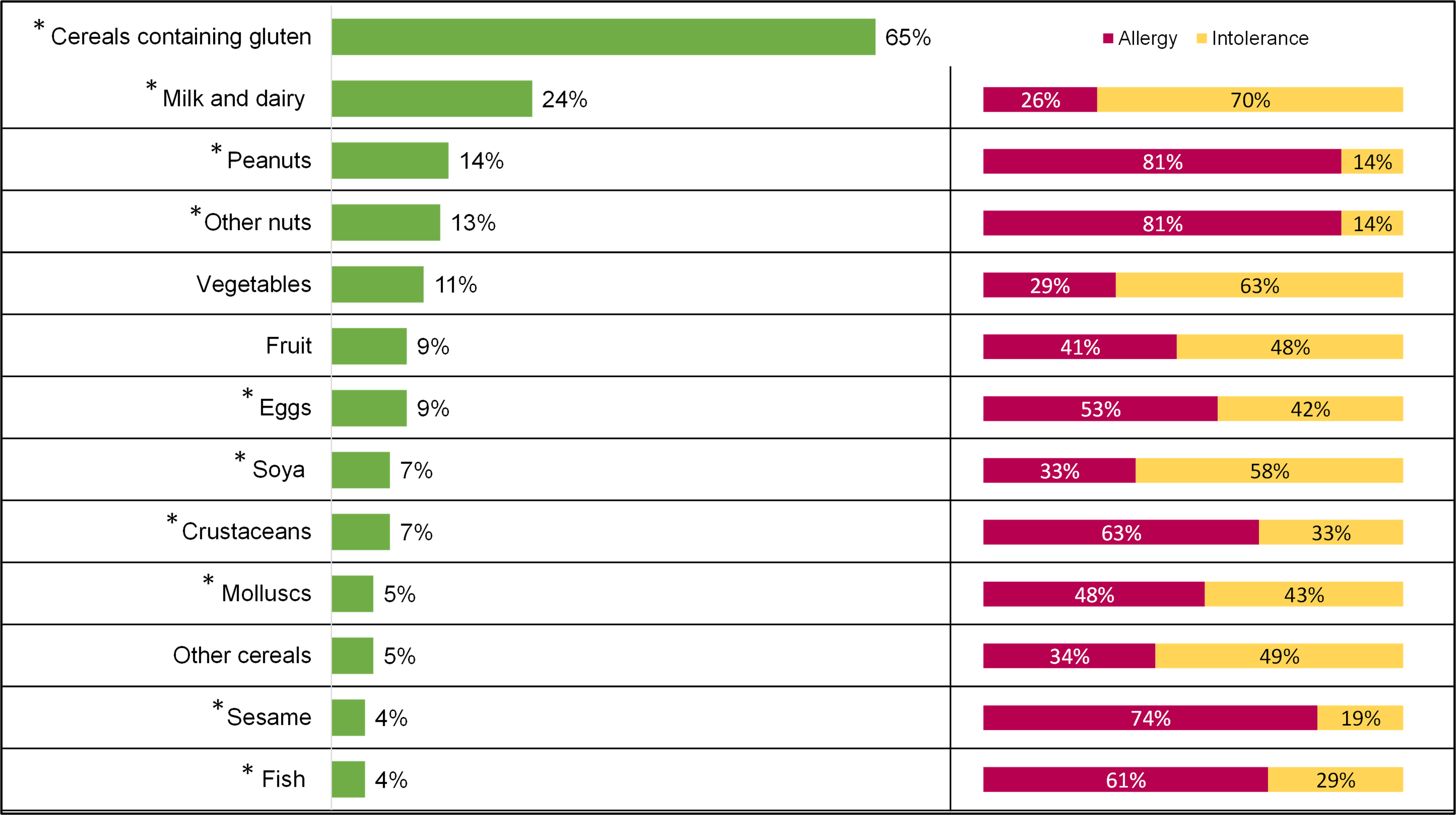
A2. Do you / your child experience a bad or unpleasant reaction to any of the following foods? Base: All consumers (1,809). A4. How would you best describe your problem with this food? Base: All consumers who have a food sensitivity to each of the food types (milk and dairy (424), peanuts (253), other nuts (227), vegetables (104), fruit (144), eggs (163), soya (122), crustaceans (120), molluscs (99), other cereals (94), sesame (74), fish (66)).
Consumers were more likely to be intolerant, rather than allergic, to certain food types - particularly to milk and dairy (70% intolerance vs 26% allergy), vegetables (63% intolerance vs 29% allergy) and soya (58% intolerance vs 33% allergy). Conversely, consumers were more likely to report having an allergy, rather than an intolerance, to peanuts (81% allergy vs 14% intolerance), other nuts (81% allergy vs 14% intolerance) and sesame (74% allergy vs 19% intolerance).
In terms of demographics, the majority of consumers identified as female (79% vs 20% male) and White (95%). (footnote 3) The age of consumers varied; 14% were aged between 18 and 34 years old, 60% between 35 and 64 and 23% were 65 or older. The majority of consumers (85%) were in England, 9% in Wales and 6% Northern Ireland. (footnote 4)
When responding on behalf of their child with a food hypersensitivity, around half (47%) stated that their child was female, and a similar proportion (52%) had a male child with a food hypersensitivity . The age of the child varied, with 29% between 0 and 6 years old, 26% between 7 and 10 years old and 43% between 11 and 17 years old.
Qualitative interviews
A total of 31 in-depth interviews were achieved with a subset of the consumers who completed the survey. Interviews were conducted with a variety of consumers, targeted to ensure a range of people by country, whether they or their child had a food hypersensitivity, the nature and type of food hypersensitivity and experiences since the new legislation. Tables 3.2 to 3.10 show the number of consumers who took part in the qualitative interviews by subgroup.
Table 3.2 Qualitative interviews by country
| Country | Number of achieved qualitative interviews |
|---|---|
| England | 25 |
| Northern Ireland | 3 |
| Wales | 3 |
| Total | 31 |
Table 3.3 Qualitative interviews by respondent or child's food hypersensitivity
| Respondent or child’s food hypersensitivity | Number of achieved qualitative interviews |
|---|---|
| Respondent has food hypersensitivity | 24 |
| Child has food hypersensitivity | 7 |
| Total | 31 |
Table 3.4 Qualitative interviews by severity of food hypersensitivity
| Severity of food hypersensitivity | Number of achieved qualitative interviews |
|---|---|
| Mild | 3 |
| Moderate | 5 |
| Severe | 21 |
| Don't know | 2 |
| Total | 31 |
Table 3.5 Qualitative interviews by coeliac disease status
| Coeliac disease status | Number of achieved qualitative interviews |
|---|---|
| Coeliac disease | 16 |
| Not Coeliac disease | 15 |
| Total | 31 |
Table 3.6 Qualitative interviews by awareness of PPDS labelling requirements
| Awareness of PPDS labelling requirements | Number of achieved qualitative interviews |
|---|---|
| Aware of PPDS labelling requirements before survey | 28 |
| Unaware of PPDS labelling requirements before survey | 3 |
| Total | 31 |
Table 3.7 Qualitative interviews by change in experience of buying PPDS foods since October 2021
| Change in experience of buying PPDS foods since October 2021 | Number of achieved qualitative interviews |
|---|---|
| Experience of buying PPDS has improved since Oct 21 | 12 |
| Experience of buying PPDS has worsened since Oct 21 | 2 |
| Total | 14 |
Table 3.8 Qualitative interviews by change in quality of life since October 2021
| Change in quality of life since October 2021 | Number of achieved qualitative interviews |
|---|---|
| Quality of life has improved since Oct 21 | 11 |
| Quality of life has worsened since Oct 21 | 4 |
| Total | 15 |
Table 3.9 Qualitative interviews by change in amount of PPDS food purchases since October 2021
| Change in amount of PPDS food purchases since October 2021 | Number of achieved qualitative interviews |
|---|---|
| Buys PPDS foods more since Oct 21 | 9 |
| Buys PPDS foods less since Oct 21 | 9 |
| Total | 18 |
Table 3.10 Qualitative interviews by change in confidence in buying PPDS foods since October 2021
| Change in confidence in buying PPDS foods since October 2021 | Number of achieved qualitative interviews |
|---|---|
| Confidence in PPDS labelling increased since Oct 21 | 12 |
| Confidence in PPDS labelling not increased since Oct 21 | 7 |
| Total | 19 |
Food Business Operators
Methodology
A total of 900 food business operators (FBOs) in the UK completed the telephone survey between 25 November 2022 and 12 January 2023. The sample was obtained through an external provider (Market Location) and during fieldwork, interviews were monitored by business size, sector and country to ensure the sample size for each group was sufficient and a representative sample was achieved. (footnote 5)
The survey took an average of 19 minutes to complete and were conducted with the person with responsibility for food safety at the FBO. The survey covered awareness and understanding of PPDS, current PPDS practices, support with and effects of PPDS legislation, as well as key firmographics about the business.
During analysis, the data was weighted to match the profile of the population by sector, size and country. (footnote 6)
At the end of the survey, 449 FBOs agreed that they were happy to take part in a follow-up qualitative interview, representing 50% of the sample. As with the consumer interviews, targets were set in order to achieve a broad range of perspectives, in this case, these were centred around country, size and sector, as well as awareness of, compliance with PPDS legislation and perceived ease of this. A total of 19 FBOs took part in in-depth interviews between 17 December 2022 and 3 February 2023. These were completed over the phone or via Zoom or Microsoft Teams. Interviews took between 45 and 60 minutes.
In order to account for those who sell PPDS foods from a market stall, five businesses that sold PPDS food from a moveable or temporary premises (e.g. a market stall or mobile sales vehicle) also took part in a qualitative interview. Once they had agreed to participate, market traders took part in an interview over the phone or via Zoom or Microsoft Teams. These interviews took place between 16 January and 1 February 2023 and took between 45 and 60 minutes.
Profile of FBOs
FBOs that are restaurants or cafes makes up the largest proportion (49%) of businesses that took part in the survey, followed by general retail (28%) and catering (15%). Half (50%) were the smallest business size with between 1 and 5 employees, and the majority (84%) were situated in England. A full breakdown of interviews achieved by country, size and sector is shown in Tables 3.11 to 3.14.
The proportion of surveyed businesses in each size and sector also represent the relevant proportions within each of the nations.
The majority (91%) of businesses sold PPDS foods at the time they participated in the survey. The remaining 9% had sold PPDS foods in the previous 12 months but had stopped doing so at the time of the survey. (footnote 7)
Table 3.11 Breakdown of businesses by country
| Country | Number of achieved mainstage surveys |
|---|---|
| England | 612 |
| Northern Ireland | 52 |
| Scotland | 161 |
| Wales | 75 |
| Total | 900 |
Table 3.12 Breakdown of businesses by number of employees
| Number of employees | Number of achieved mainstage surveys |
|---|---|
| Between 1 and 5 employees | 347 |
| Between 6 and 10 employees | 266 |
| 11 or more employees | 287 |
| Total | 900 |
Table 3.13 Breakdown of businesses by sector group
| Sector group | Number of achieved mainstage surveys |
|---|---|
| Catering | 355 |
| Retail | 545 |
| Total | 900 |
Table 3.14 Breakdown of businesses by sector (detailed)
| Sector detailed | Number of achieved mainstage surveys |
|---|---|
| Caterers | 107 |
| Restaurants and cafes | 248 |
| Bakers | 136 |
| Butchers | 133 |
| Delicatessens | 79 |
| General retail | 197 |
| Total | 900 |
Qualitative interviews
In terms of the qualitative interviews, 19 FBOs including five businesses that sold PPDS food from a moveable or temporary premises (e.g. a market stall or mobile sales vehicle) who completed a qualitative interview. The profile is shown in Tables 3.15 to 3.18.
Table 3.15 Breakdown of FBO qualitative interviews by country
| Country | Number of achieved mainstage surveys |
|---|---|
| England | 12 |
| Northern Ireland | 2 |
| Scotland | 4 |
| Wales | 1 |
| Total | 19 |
Table 3.16 Breakdown of FBO qualitative interviews by number of employees
| Number of employees | Number of achieved mainstage surveys |
|---|---|
| Between 1 and 5 employees | 8 |
| Between 6 and 10 employees | 5 |
| 11 or more employees | 6 |
| Total | 19 |
Table 3.17 Breakdown of FBO qualitative interviews by sector group
| Sector group | Number of achieved mainstage surveys |
|---|---|
| Catering | 9 |
| Retail | 10 |
| Total | 19 |
Table 3.18 Breakdown of FBO qualitative interviews by sector (detailed)
| Sector detailed | Number of achieved mainstage surveys |
|---|---|
| Caterers | 5 |
| Restaurants and cafes | 4 |
| Bakers | 5 |
| Butchers | 2 |
| Delicatessen | 2 |
| General retail | 1 |
| Total | 19 |
Local Authorities
Methodology
A total of 126 staff members, covering 124, of the 398 Local Authorities (LAs) across the UK, completed the online survey between 1 December 2022 and 13 January 2023. (footnote 8) The FSA and FSS distributed the link to the online survey by email and followed up to encourage LAs to complete the survey if they had not done so already. Upon invitation to take part in the survey, the email asked that the person best placed within the local authority to provide feedback on the experience of the PPDS labelling requirements takes part. This may be their lead food officer or someone they nominate to take part. (footnote 9) The survey covered their understanding of PPDS, how PPDS checks are carried out, experience of these checks and enforcement and impact on LAs and FBOs in their area.
A total of 39 LAs agreed to be recontacted in the survey, of these, 21 took part in an interview over the phone or via Zoom or Microsoft Teams between 14 December 2022 and 26 January 2023. These interviews lasted between 45 and 60 minutes on average.
Profile of LAs
In line with the UK profile of LAs, the majority of who completed the survey were in England. A full breakdown by country is shown in Table 3.19.
Table 3.19 Profile of LAs who took part in survey by country
| Country | Number of achieved mainstage surveys | Total number of LAs in each country |
|---|---|---|
| England | 82 | 333 |
| Northern Ireland | 11 | 11 |
| Scotland | 19 | 32 |
| Wales | 12 | 22 |
| Total | 124 | 398 |
Staff members who completed the survey indicated the area of the LA that they worked in, most worked in food standards or safety (80%), others worked in environmental health (28%) and trading standards (16%). (footnote 10)
Qualitative interviews
The profile of LAs who took part in the qualitative interviews by country, ease of checking compliance and overall description of the level of compliance of FBOs in their area with PPDS labelling requirements is shown in Tables 3.20 to 3.23.
Table 3.20 Profile of LAs who took part in qualitative interviews by country
| Country | Number of achieved qualitative interviews |
|---|---|
| England | 12 |
| Northern Ireland | 1 |
| Scotland | 7 |
| Wales | 1 |
| Total | 21 |
Table 3.21 Profile of LAs who took part in qualitative interviews by experience of compliance checks
| Experience of compliance checks | Number of achieved qualitative interviews |
|---|---|
| Found compliance checks easy | 11 |
| Found compliance checks difficult | 10 |
| Total | 21 |
Table 3.22 Profile of LAs who took part in qualitative interviews by perceived level of compliance in area
| Perceived level of compliance in area | Number of achieved qualitative interviews |
|---|---|
| Overall level of compliance good | 9 |
| Overall level of compliance poor | 10 |
| Total | 21 |
Table 3.23 Profile of LAs who took part in qualitative interviews by perceived experience of Food Business Operators
| Perceived experience of FBOs | Number of achieved qualitative interviews |
|---|---|
| FBO experience of compliance considered easy | 1 |
| FBO experience of compliance considered difficult | 20 |
| Total | 21 |
-
Cereals containing gluten is excluded from classification of allergy and intolerance due to the majority having Coeliac disease specifically.
-
This is broadly in line with the demographic make-up of those who took part in the Food Sensitivity Study: Wave Two (76% were female and 23% male). The majority (86%) were from a White background in this survey as well, and the age range also followed a similar pattern.
-
Consumers in Scotland were out of scope of the research.
-
FBOs with over 250 employees were excluded from the research as the FSA and FSS wished to engage micro and small businesses as they made up the largest part of the market.
-
This was based on figures published on ‘Nomis’, a service provided by the Office of National Statistics (ONS), of the official census and labour market statistics.
-
The latter were included in the survey to understand how or if the new labelling requirements impacted their behaviour regarding PPDS.
-
In two LAs, two staff members took part in the survey. The methodology involved the survey being sent out to LAs as an open link, meaning it could be accessed by multiple staff at the local authority, leading to these multiple completions.
-
In a small minority of cases, the person confirmed they had the knowledge or oversight of PPDS labelling requirements but were not directly involved in compliance checks.
-
Some LA staff members worked across more than one of these areas.
Consumers
Awareness and understanding of PPDS foods
Around a quarter (26%) of consumers were aware of the term PPDS before they took part in the survey. There were no statistically significant differences by country in the proportion aware (England: 26%; Northern Ireland: 29%; Wales: 30%). However, there were differences by age and the nature of food hypersensitivity.
Awareness levels were generally higher among younger consumers: those aged between 18 and 34 were more likely than those aged 65 or older to be aware of the term PPDS (35% vs 17%). With regards to food hypersensitivities, those with an allergy other than Coeliac disease were more likely to be aware of the term PPDS, prior to taking part in the survey, than those with Coeliac disease (31% vs 22%). Those who reported both themselves and their child having a food hypersensitivity and those reporting just their child having a food hypersensitivity were both more likely to have heard of the term before compared with those reporting just themselves with a food hypersensitivity (38% and 32% respectively vs 23%).
Interviews with consumers highlighted that they typically became aware of the term PPDS through a food hypersensitivity charity or from media coverage of Natasha Ednan-Laperouse’s death. Some stated they became aware after they or someone close to them was diagnosed with a food hypersensitivity.
“I followed Natasha's Law. Her parents have an Instagram page that they run and I follow that and it was on there [the term PPDS].”
Consumer, Northern Ireland, Severe hypersensitivity
"[I became aware of PPDS] Quite quickly after [my child] was diagnosed [with coeliac disease] a year ago."
Consumer, Wales, Severe hypersensitivity
After the survey captured awareness levels, the term was defined and explained to consumers as follows: 'Pre-packed for direct sale (PPDS) foods are packed on the same premises as they are being sold to consumers and where the food is packed before being offered for sale to customers’. Following this, consumers were asked to what extent it would be easy or difficult to identify such food. As shown in Figure 4.1, around half (52%) of consumers said that it would be difficult for them to identify if food was packaged on site and therefore whether it would classify as PPDS (with 22% reporting that it would be very difficult).
Figure 4.1 Extent to which consumers found identifying whether food was packaged on site easy or difficult

C2. If you entered a food business, how easy or difficult would it be to identify whether food was packaged on site? Base: All consumers (1809)
There were again no statistically significant differences by country in the proportion who found it difficult to identify whether food was packaged on site (England: 53%; Northern Ireland: 50%; Wales: 51%). However, those in Northern Ireland were more likely to find it easy than average (26% vs 19% overall).
The likelihood of reporting difficulty with identifying PPDS foods increased with age and food hypersensitivity severity. Those aged 18 to 34 perceived it to be easier than both those aged 35 to 64 and those aged 65 or older (32% vs 19% and 10% respectively).Those with a mild allergy or intolerance were more likely than those with either a moderate and severe allergy to find it easy (31% vs 21% and 16% respectively), while those with a moderate or severe allergy or intolerance were more likely to find it difficult (49% and 57% vs 52%). Those also reporting both themselves and their child having a food hypersensitivity were more likely than those reporting just themselves or just their child having a food hypersensitivity to perceive it to be easier (28% vs 17% and 19% respectively).
During qualitative interviews, some said it would be difficult for them to identify if food was packaged on site, because PPDS foods were often placed alongside other prepacked food. Others said it could be harder to determine when printed labels and branded packaging is used, cited as more common in larger outlets, as this packaging can mirror the appearance of non PPDS foods.
“[Supermarkets] have cold meat in the deli in packaging, and I am unsure whether they package it centrally or in-store.”
Consumer, Wales, Moderate hypersensitivity
“In larger stores [identifying PPDS] it is quite difficult; in local outlets it would be quite easy.”
Consumer, England, Severe hypersensitivity
Awareness and understanding of PPDS labelling requirements
The PPDS labelling requirements were defined and explained within the survey ahead of questions around awareness of them. Once defined, the vast majority (87%) reported having heard of PPDS labelling requirements, although only a small proportion (18%) knew a lot about it, as shown in Figure 4.2.
Figure 4.2 Consumer awareness of new PPDS labelling requirements

D1. Before today, to what extent were you aware of the new PPDS food labelling requirements, or Natasha’s Law? Base: All consumers (1809)
Awareness of PPDS labelling requirements was broadly similar across the three countries (England: 88%; Northern Ireland: 84%; Wales: 88%). However, those with Coeliac disease were more likely than those with another food hypersensitivity (91% vs 83%) and those with an allergy to a regulated allergen were more likely those with only an allergy to a non-regulated allergen (89% vs 76%) to have heard of the new requirements, regardless of understanding.
Parents who reported having a child with a food hypersensitivity and those reporting both themselves and their child having a food hypersensitivity were both more likely than those reporting just themselves having a food hypersensitivity to have heard of the new labelling requirements and knowing quite a lot about it (23% and 25% respectively vs 15%). Similarly, those with a severe allergy were more likely to report having heard of the new labelling requirements and knowing quite a lot about it than those with a mild or moderate allergy (21% vs 10% and 15% respectively).
Consumers typically first heard of the new PPDS labelling requirements from traditional media sources. As shown in Figure 4.3, half (50%) of consumers became aware via local or national newspapers or TV, followed by 30% who learned of the requirements from a registered charity, and 19% via social media.
Figure 4.3 How consumers became aware of the new labelling requirements
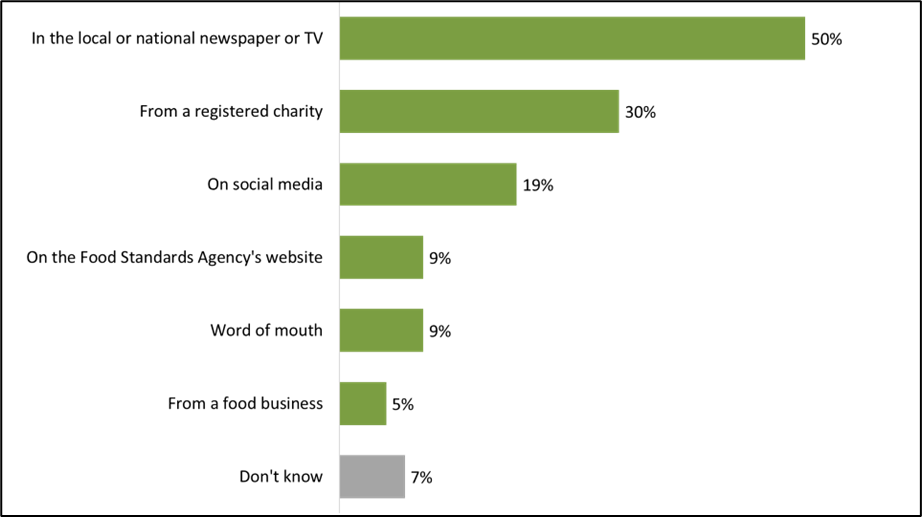
D2. How did you hear about the new PPDS food labelling requirements? Base: All consumers who were aware of the new labelling requirements (1582).
Across the three countries, traditional media, local or national newspaper or TV, was the top source of awareness (England: 51%; Northern Ireland: 42%; Wales: 37%). In England this was followed by registered charities (30%) and in Northern Ireland and Wales social media (41% and 30% respectively).
There were some differences by age with those aged 65 or older were more likely to have become aware of the new labelling requirements through local or national newspaper or TV than those aged 18 to 34 and those aged 35 to 64 (60% vs 34% and 49% respectively). Additionally, those aged 18 to 34 and those aged 35 to 64 were both more likely to have become aware through social media or the FSA’s website than both those aged 65 or older (social media: 33% and 21% vs 8%; FSA website: 17% and 9% vs 5%).
In addition to being asked about their awareness of PPDS labelling requirements, consumers were also asked which types of food they thought FBOs were legally required to provide written full ingredient lists for. The majority correctly identified that there is a legal requirement for written full ingredients lists to be provided on prepacked food (89%) and PPDS foods (78%) as shown in Figure 4.4. However a quarter (25%) incorrectly thought this was also a legal requirement for non-prepacked food, with less than half (45%) correctly identifying it was not.
Figure 4.4 Awareness of FBOs legal requirements for providing food information
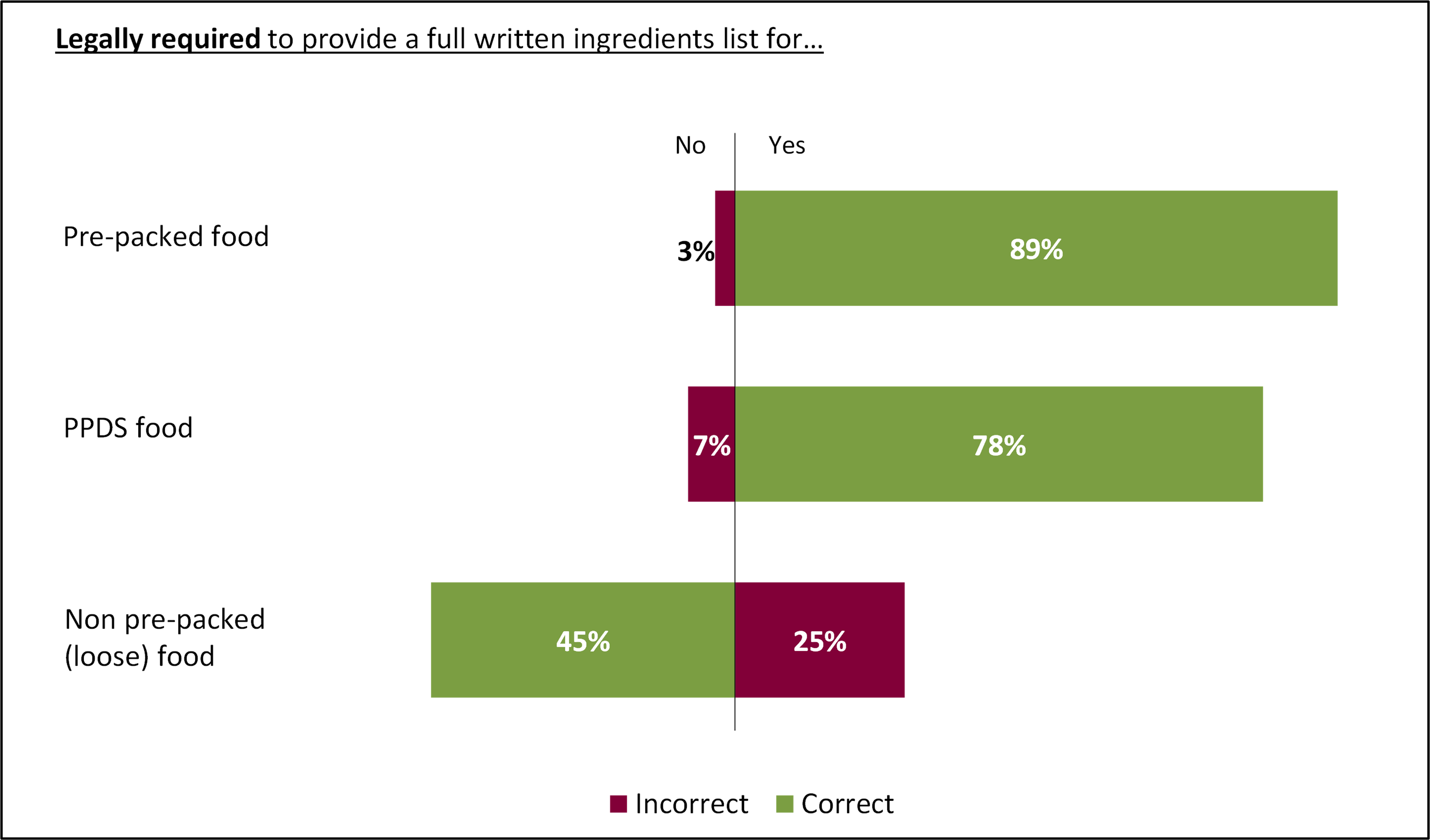
B4. As far as you are aware, which of the following types of food are businesses legally required to provide written full ingredient lists for? Base: All consumers (1809).
Across these three food types, a third (32%) of consumers were aware of the legal requirements for providing food information for all three categories (prepacked food, PPDS food and non-prepacked (loose) food), 52% for any two categories, and only 5% were unaware for all 3 foods. Consumers in Northern Ireland and those aged 18 to 34 were both more likely than average to have selected all three statements correctly (44% and 39% vs 32%).
Consumers shared whether, in their view, PPDS foods only needed to be labelled with information about whether they contain any of the 14 specified allergens, rather than with a full ingredients list. As illustrated in Figure 4.5, two-thirds (67%) disagreed with this, in line with new PPDS requirements, and only around a fifth agreed (21%).
Figure 4.5 Consumers view on if PPDS only needed labelling if they contain an allergen

C8. 'In my view, foods prepacked for direct sale (PPDS) only need to be labelled with information about whether they contain any of the 14 specified allergens, rather than with a full ingredients list' Base: All consumers (1809).
By age, those aged between 35 to 64 were more likely to disagree than those aged 65 or older (69% vs 58%). Those with a regulated allergen were more likely than those with only a non-regulated allergen and those with both a regulated and non-regulated allergen to agree that PPDS foods only needed labelling if they contain any of the 14 specified allergens (22% vs 15% and 17%).
During qualitative interviews, many were aware of the new labelling requirements, their purpose, and its aim being to better protect and inform those with a food hypersensitivity when purchasing PPDS foods. Despite this, many struggled to define specifically what was required under the new labelling requirements.
This high-level awareness allowed many to provide a broad definition and those who had noticed changes in PPDS foods labelling were able to presume what the new legislation required from these changes.
"They've [FBOs] probably got legal requirements although I'm not quite sure what they are. You just assume and hope that companies are doing the legal requirement.”
Consumer, England, Severe hypersensitivity
“I've noticed the changes because packaging is very clear now, it's obvious you don't have to think, ‘Does it contain [allergens]?’ If you weren't sure, it is there written on the packaging for you.”
Consumer, England, Moderate hypersensitivity
Many agreed with the new legislation and believed all PPDS foods should have labels. There was also surprise amongst some that this has not always been a requirement for FBOs on PPDS foods.
"As there are less common allergies, it is important to have all ingredients on the packaging."
Consumer, England, Severe hypersensitivity
“I know they were trying to push for a law but the scary thing is that law only came into place because somebody died.”
Consumer, England, Severe hypersensitivity
Food Business Operators
Awareness and understanding of PPDS foods
Two-thirds (66%) of FBOs reported being aware of the term PPDS before participating in this research; with around a third (33%) having not heard of the term.
There were no statistically significant differences by country in terms of awareness of the term PPDS (England: 66%; Northern Ireland: 65%; Scotland: 69%; Wales: 63%). However, amongst those who currently sell PPDS foods there were differences by sector. Both butchers and delicatessens were more likely to be aware of the term PPDS, prior to this survey (79% and 80% vs 66% overall).
After the survey captured awareness levels of the term PPDS, the term was defined and explained to FBOs as: Pre-packed for direct sale (PPDS) foods that is packed before being offered for sale by the same food business to the final consumer, where this takes place on the same premises or location; or from moveable or temporary premises such as a market stall or mobile sales vehicle, before asking to what extent six particular aspects of the PPDS definition were clear to them. As shown in Figure 4.6, FBOs reported that they felt the PPDS definition – across all aspects – was clear, with four fifths clear about each aspect (80%), ranging from 94% of FBOs who felt the definition of packaging was clear, to 82% of FBOs who felt it was clear which of their premises constitute part of the same food business. However, a fifth (20%) were unclear on at least one aspect.
Figure 4.6 FBOs: aspects of the PPDS definition considered clear
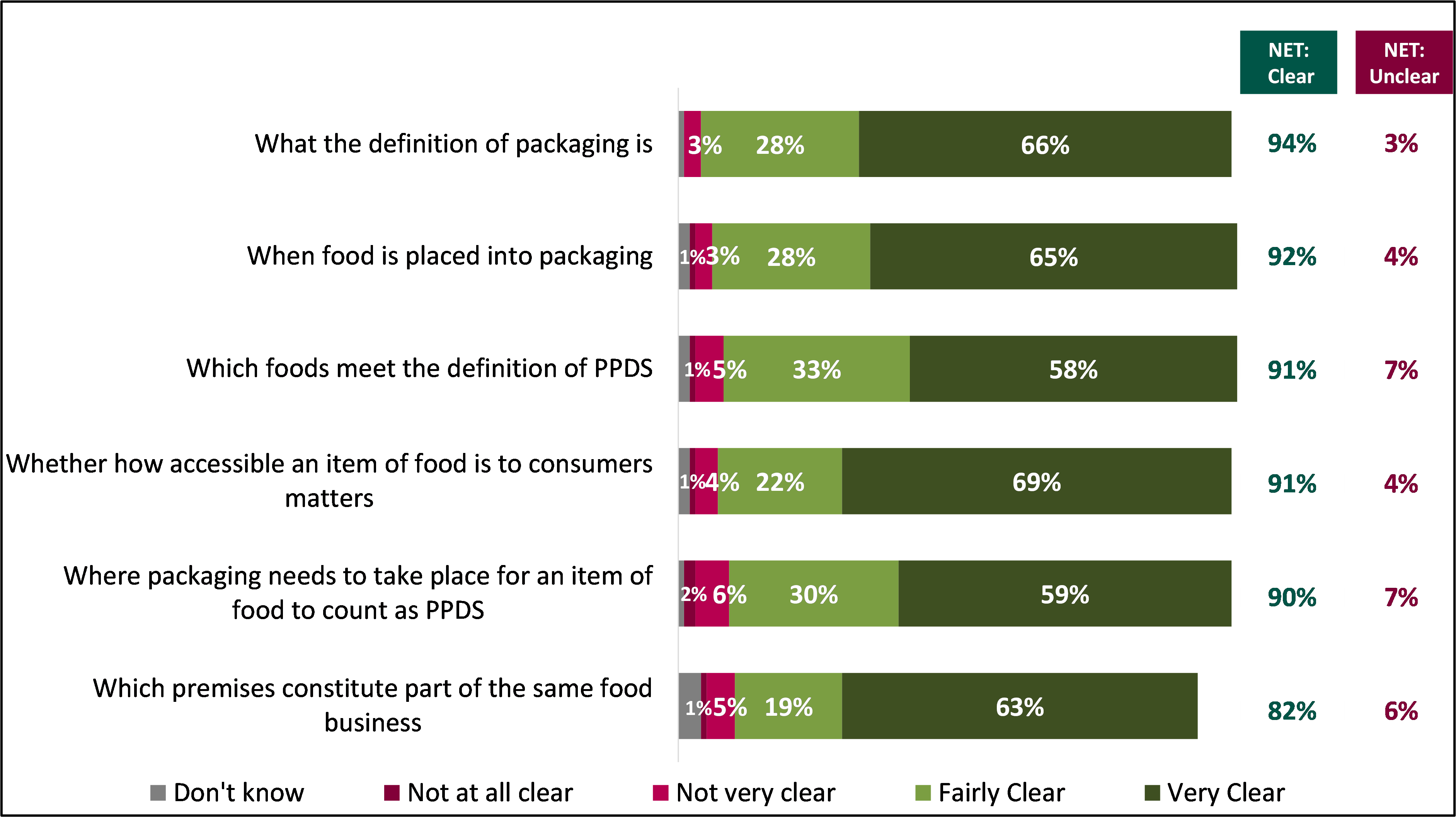
A4. To what extent, if at all, are the following aspects of the definition of PPDS clear to you? Base: All FBOs (900). *NB FBO’s were only asked this statement if they had multi-site establishments (394).
Amongst those who sold PPDS foods at the time of the survey, butchers and general retail were more likely than average to be clear on all aspects of the definition (88% and 86% respectively). (footnote 1) In contrast, catering venues who sold PPDS foods were less likely to be clear on all aspects of the definition than those who sell PPDS foods (72%).
Awareness also varied by size; FBOs with 11 or more employees who sold PPDS were more likely to say they were clear on all aspects of the definition (88%) than smaller FBOs with between 1 and 5 employees (76%) and or between 6 and 10 employees (82%).
Reflecting the results of the survey, during qualitative interviews most FBOs said they had a good understanding of what constitutes PPDS food. However, some explained that they initially faced a steep learning curve as it was not a term that they had used internally prior to the PPDS labelling requirements being announced.
“I initially thought they're not pre-packaged. You have to look at it from the customer not from you as the supplier. From a customer's perspective yes, it's a PPDS product.”
FBO, England, Catering, 11 or more employees
Some FBOs explained that they occasionally encountered confusion about the definition of PPDS. For example, the owner of a mobile food business said that they were unclear whether pre-ordered meals for collection counted as PPDS while a butcher was uncertain whether products packaged at an offsite kitchen met the definition of PPDS.
“The confusing thing for us is sometimes there will be people that ring up and say, ‘right we want four vegetarian meals and four meat dinners, we’re coming at four to pick it up’. We feel like we're in a bit of a limbo with that.”
FBO, England, Catering, 11 or more employees
“Butchery products are prepared onsite but everything else is prepared offsite and I’m not sure if they actually count as PPDS.”
FBO, England, Delicatessen, 11 or more employees
Awareness and understanding of PPDS labelling requirements
Most FBOs (91%) were aware of the PPDS labelling requirements before taking part in the research, with few (8%) reporting they were unaware.
There were no statistically significant differences by country in terms of awareness of the PPDS labelling requirements before taking part in the research (England: 90%; Northern Ireland: 94%; Scotland: 91%; Wales: 88%).
Amongst those who sold PPDS foods currently there were differences in awareness by sector and size. Catering and general retail FBOs were more likely than average to report being aware of the legal requirements to label PPDS foods (96% and 95% respectively). Conversely restaurants and cafes were less likely than average to state they were aware (83% vs 91%). With regards to size, FBOs with 11 or more employees, who currently sold PPDS, were almost wholly aware of the labelling requirements and as a result more likely be aware than average (97% vs 91%). Those with between 1 and 5 employees and those with between 6 and 10 employees were less aware than those with 11 or more employees (87% and 90% vs 97%).
During qualitative interviews, most FBOs demonstrated good awareness and understanding of PPDS labelling requirements. As with the definition of PPDS, many had experienced points of uncertainty and confusion to begin with, but these generally passed following the receipt of guidance or training. A few reported changing their practices around where confusion persisted.; for example, selling foods that were formally PPDS as loose foods. Further detail on such changes to practices is presented in Chapter 6.
“The biggest challenge was simply figuring out what had to go on the labels … It took a while to sort out, but it’s fine now.”
FBO, Scotland, Restaurant/café, 1 to 5 employees
“There was a grey area where we had sandwiches we had prepared, and we would wrap them in a wax wrap just to keep the sandwich together. Our consultant said that was too on the line, so we now sell it loose without any packaging to skirt around that.”
FBO, England, Retail, 11 or more employees
Most LAs that took part in qualitative interviews believed FBOs generally had good awareness and understanding of PPDS labelling requirements. However, some identified small independent FBOs and takeaways as an exception to this. These FBOs were said to have lower awareness and understanding of PPDS labelling requirements owing to them not having the time or dedicated staff to engage with food information regulations and, where English is not the first language of owners and staff, because guidance was difficult to understand.
“You might have a one-man band that doesn’t have the technical expertise or resource to help with it and he will probably do nothing until we come along and give advice.”
Local Authority, Scotland
“Sometimes, with a language barrier, explaining the PPDS labelling requirements can be even more difficult. They don’t understand it.”
Local Authority, England
Local Authorities
Awareness and understanding of PPDS foods
Close to three-fifths (57%) of LAs reported being clear on all aspects of the definition of PPDS presented to them. The lowest level of understanding was whether the accessibility of the food (to consumers) matters (75% said this was clear to them), as shown in Figure 4.7. This was followed by: what the definition of packaging is (83%); and which foods met the definition of PPDS (83%).
Figure 4.7 LAs: Aspects of the PPDS definition considered clear
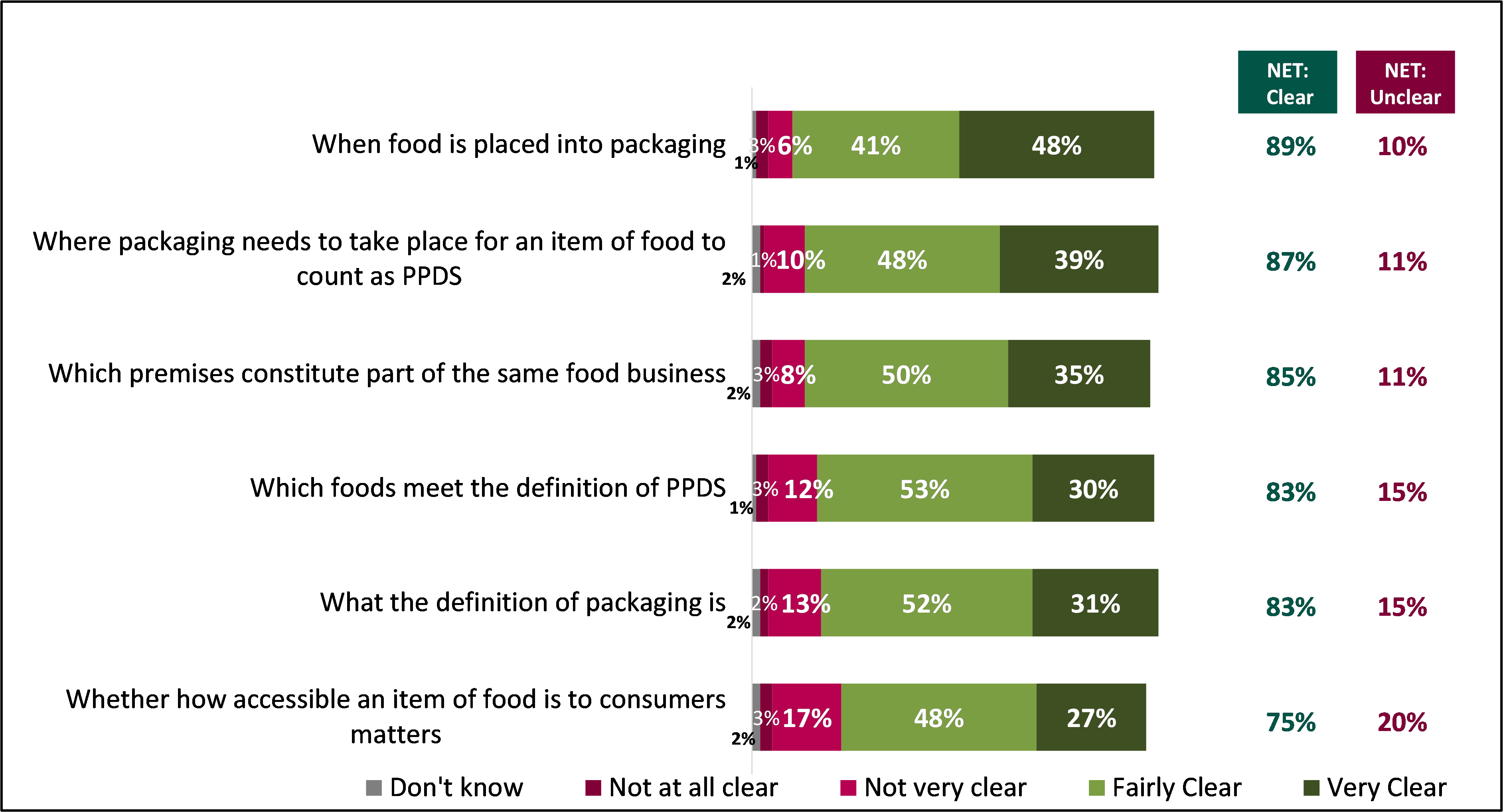
B2. To what extent, if at all, are the following aspects of the definition of PPDS clear to you? Base: All LAs (126).
In the qualitative interviews, many LAs reported receiving guidance from the FSA or FSS but felt that this guidance was not always clear on which foods meet the definition of PPDS, mostly around the definition of prepacked in relation to direct sale. Specifically, some LAs were unclear on the impact accessibility of food and when packaging takes place has on the requirements.
One example an LA gave of this confusion was between two examples provided by the FSA, specifically scenarios 4 and 5b. (footnote 2) They felt the guidance left this scenario unclear: If an FBO made sandwiches in bulk, wrapped these individually in cling film, then placed them in a fridge, away from consumers reach or sight. A consumer then later orders the item, staff retrieve the sandwich remove all the cling film and place the sandwich into a takeaway container before presenting it to the consumer. The LA thought, against their initial interpretation, using both examples that this would not be PPDS and not require labelling.
“Before the second set of [FSA] guidance came out I thought I was fairly clear on what was prepacked for direct sale and what wasn't. The second set of guidance I thought over complicated things. They gave a lot of examples and some of them are contradictory.”
Local Authority, Wales
“There is guidance on the FSS website and a flow diagram which answers questions. I think it would help to know where all the LAs are in relation to these issues. FSS were looking for us to report to them with any anomalies we had identified, should a prawn cracker be on a report and should we be enforcing it.”
Local Authority, Scotland
“Our frustrations are born out of the guidance itself, which has made it far more complicated and onerous than it needed to be.”
Local Authority, England
Awareness and understanding of PPDS labelling requirements
LAs understanding of the labelling requirements was generally high across the qualitative interviews. Most were aware that the PPDS labelling requirements consisted primarily of making ingredients of foods that are readily available to consumers more accessible and visible; and were able to translate what this meant in practice for FBOs and in terms of compliance checks.
“Once [FBOs] are aware of what needs to be on it, they get it right even if it takes a few goes.”
Local Authority, Scotland
Most LAs explained that they had developed their understanding of PPDS and the associated labelling requirements primarily from guidance produced by the FSA and FSS. Many felt that this guidance had provided them with clarity.
“Knowledge hub, specific for standards officers, is a very useful source.”
Local Authority, England
“The [FSS] were proactive and sent out a letter to Local Authorities and enforcement letters and gave us quite a bit of resource to pass on which is still on the website.”
Local Authority, Scotland
Where instances of confusion were found, it was typically amongst specific foods or areas of the legislation rather than general understanding. Many LAs were aware of the purpose and need behind the requirements, and were supportive of them, but felt finer details were absent or not clear to them.
"Some of it is obvious but some things there is no concrete guidance on - we've had bakers where some bread is enclosed in a package, some not. Some bakeries selling pieces of cake, and the last piece is wrapped in clingfilm, should that fall within it?"
Local Authority, England
Confusion also extended to some specific foods at takeaway premises that are made in bulk, then prepacked ahead of an order and bundled later with an order of non-prepacked food. Some felt these items should not be classed as PPDS and not require full labelling as they form part of an order on non-prepacked food.
“Takeaways with prawn crackers in bags, tartar sauce for fish and chips [are all covered]. It should be more directed to grab and go, grab a sandwich and you are away. I don’t think things behind the counter or in a kitchen should be included. Some Local Authorities with fast food and takeaways are saying just label everything.”
Local Authority, Scotland
Some LAs felt they had a very clear understanding of the new PPDS labelling requirements and spoke about the resources they used to assist colleagues involved in compliance checks. An example of third-party resources used can be seen in the case study presented in Figure 4.8, which covers the experience of an English LA and an FBO under their jurisdiction.
Figure 4.8 Case study: awareness and understanding (accessible version)
A Local Authority in England that reported feeling “totally clear” on the definition of PPDS foods and the labelling requirements.
The Local Authority was aware of resources being available from the FSA to assist Local Authorities but had not engaged with them. Instead the Local Authority had used guidance available on the BusinessCompanion website. This guidance was printed off and shared with all employees involved in compliance checks.
“I think much more can be done to encourage both businesses and Environmental Health Officers to be aware of Business Companion because it is a really good resource.”
It was felt that most businesses within the Local Authority’s jurisdiction were aware of the PPDS labelling requirements, but understanding was variable. Smaller independent businesses were highlighted as the most likely to have issues with understanding. This was attributed to a range of factors, namely: time and resources constraints, shifting supply chains and language barriers. By contrast, it was commented that larger businesses that formed part of a chain typically has an in-depth understanding of PPDS labelling requirements.
“[Small businesses] have so many other things to do that they don't have time. I think these businesses have also been clobbered quite hard by COVID, so I think the timing of the legislation has been an issue too.”
A petrol station, located in the same Local Authority, with more than 11 employees. The manager and staff of this FBO had a good understanding of PPDS labelling requirements following the delivery of regular training and written guidance delivered by the business’s head office.
“Everybody in the business had to re-do their allergen training, and it was updated with the most recent legislation. It was made clear to me as a manager as well as my team members why those changes were coming and the part we needed to play.”
The manager had not engaged with any support and guidance available from their Local Authority. They had not felt a requirement to do so as they feel well equipped from the support provided by their head office.
The FBO had received visits from Environmental Health Officers since October 2021, but these visits had not involved guidance on PPDS labelling requirements. The manager assumed this is because the site is operating compliantly.
-
92% of all FBOs sold PPDS foods at the time of the survey (n=828).
-
FSA LA Guidance: Annex B - Examples of prepacked for direct sale food.
Consumers
PPDS purchasing behaviour
Most FHS consumers purchased PPDS foods (91%). However, as illustrated by Figure 5.1, it was uncommon for them to purchase PPDS foods often (7%). Instead consumers most frequently reported buying them sometimes (36%) or rarely (40%). Nine percent of consumers said that they never purchased PPDs foods.
Figure 5.1 How often consumers purchase PPDS foods

C3. How often do you buy PPDS foods? Base: All FHS consumers (1809).
Geography and age were associated with likelihood to purchase PPDS foods. Consumers in Northern Ireland (83%) were less likely than those in England (91%) and Wales (92%) to purchase PPDS foods. Meanwhile, younger consumers aged between 18 and 34 were more likely than average to purchase them (95%).
In addition, the nature of consumer’s food hypersensitivities had a bearing over their likelihood to purchase PPDS foods. Those with allergies and intolerances other than Coeliac disease were more likely to do so than those with Coeliac disease (92% vs 89%) and those with a mild (97%) or moderate (96%) allergy or intolerance were more likely to purchase PPDS foods that those with a severe allergy or intolerance (87%).
During qualitative interviews, many consumers that purchased PPDS foods, particularly those with severe food hypersensitivities, explained that they tended to do so as a ‘last resort’ due to concerns over cross-contamination and the accuracy of labelling. They tried to avoid eating food that was not prepared by themselves or someone they knew, and if they did buy food to take away they generally opted for prepacked food from a large chain (e.g. supermarket bought sandwiches). Consumers that purchased PPDS foods frequently explained that they felt comfortable doing so because they had a mild allergy or intolerance, and so the risk posed by cross-contamination and inaccurate labels was less significant.
"I'm if going to buy pre-packaged food I'll mostly get it from a supermarket… I'd definitely steer clear of bakeries… independents might have all the good intentions in the world and put all these processes in place but it's just one person in the kitchen who didn't wash the knife or whatever. That's all it takes."
Consumer, England, Severe hypersensitivity
“I have always avoided stuff packaged on the day. I have just got into the routine of not buying this. I get my food shop done weekly and that comes through the door, and I just buy the same foods.”
Consumer, Wales, Severe hypersensitivity
Consumers who reported never buying PPDS foods typically attributed this to a lack of trust and confidence. (footnote 1) Around two fifths (38%) said they do not trust that PPDS food is totally allergen free, over a quarter (27%) said they do not trust that preparation areas are free from cross-contamination and a fifth (22%) said they lack trust in the accuracy of PPDS labelling.
Experience of accessing PPDS ingredients information
As presented in Figure 5.2, four fifths (81%) of FHS consumers that buy PPDS foods said they check labels on PPDS packaging at every point of purchase. Of the remainder, 10% said they check labels most of the time, 3% said they check labels about half the time, a further 3% said they check labels occasionally and 1% said they never check PPDS labels.
Figure 5.2 How often consumers check labels on PPDS foods

C6. How often do you look at PPDS food labels? Base: FHS consumers that buy PPDS foods (1639).
The frequency to which consumers checked labels on PPDS packaging increased with the severity of food hypersensitivity. Half (50%) of those with a mild allergy or intolerance checked labels on PPDS packaging at every point of purchase, compared to three quarters (73%) of those with a moderate allergy or intolerance and more than nine in ten (92%) of those with a severe allergy or intolerance. Furthermore, those with Coeliac disease were more likely than those with other allergies or intolerances to check labels on PPDS every time (93% vs 68%). (footnote 2)
When considering understanding and awareness, consumers who found it difficult to identify PPDS foods were more likely to check the labels more often (95% always or most of the time vs 88% of those who find it easy).
Linked to the type and severity of food hypersensitivity, consumers that reported rarely purchasing PPDS foods were more likely than those that reported purchasing PPDS foods sometimes or often to say they check labels on PPDS packaging at every point of purchase (88% vs 77%).
Amongst those that checked labels on PPDS foods, only one in twenty (5%) reported being able to always access the information they needed to be able to identify whether it contains an ingredient that would cause an unpleasant reaction. (footnote 3) As shown in Figure 5.3, a third (34%) said that this information was available most of time, a fifth (21%) said it was available about half the time and a quarter (25%) said it was only occasionally available. A further 4% said the information was never available.
Figure 5.3 How often allergen information is available on PPDS foods

C5. How often is the information you need to identify a food that might cause an unpleasant reaction readily available? Base: FHS consumers that buy PPDS foods and check labels (1606).
Those with a mild allergy or intolerance were more likely than those with a moderate or severe allergy or intolerance to report being able to always access the information needed to identify whether PPDS foods contain an ingredient that would cause an unpleasant reaction (10% vs 5%).
There were few differences between those with a hypersensitivity to regulated allergens and those with a hypersensitivity to non-regulated allergens in the reported availability of such information, with the exception of those stating that the information is never available. Consumers who only had an allergy to a non-regulated allergen were more likely to say the information is never available (8% vs 4% of those with an allergy to a regulated allergen). Again there was a correlation with ease of identifying PPDS foods, those who found it easy to identify PPDS foods were more likely to find the information they need all or most of the time (59% vs 33% of those who found it difficult).
Consumers who reported purchasing PPDS foods sometimes or often were more likely than those that rarely made a purchase to state that they were able to access the information they needed every time (8% vs 3%) or most of the time (44% vs 26%). So too were those that reported it being easy to identify PPDS foods compared to those that reported it being difficult (every time: 12% vs 4%; most of the time: 47% vs 30%).
During qualitative interviews, some consumers gave accounts of food products they considered to be PPDS foods without full ingredients lists and the allergen information they required to make an informed decision. This was said to be more common when buying PPDS food from small independent FBOs. In such circumstances consumers were required to ask staff to provide allergen information verbally or abandon the purchase and visit another establishment.
"The likes of the big supermarkets you can find it in there it is not a problem, but the smaller independent shops are still not doing it…it's more than a year on and there is still no label on it."
Consumer, Northern Ireland, Severe hypersensitivity
Reflecting on their experience of buying PPDS foods since the associated labelling requirements were introduced in October 2021, almost two thirds (63%) of consumers reported experiencing issues with accessing ingredients information on PPDS packaging. The most common issue experienced was allergen information not being easy to read (53%). Other prominent issues with PPDS food experienced since October 2021 are listed in Figure 5.4.
Figure 5.4 Issues with labelling on PPDS food experienced since October 2021
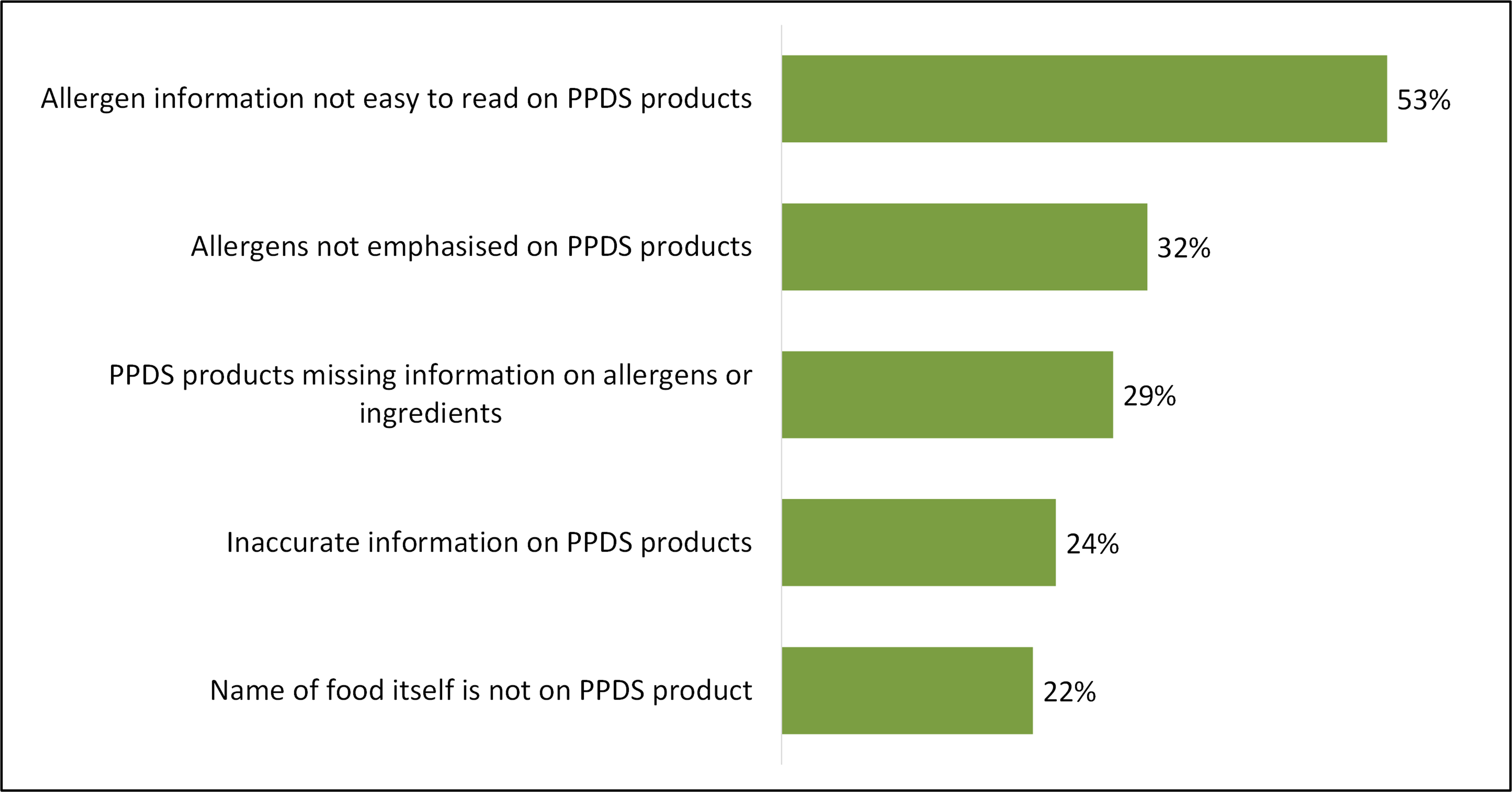
E4. Since October 2021, have you experienced any of the following issues with foods prepacked for direct sale (PPDS)…? Base: FHS consumers that buy PPDS foods (1639).
During qualitative interviews, many consumers reported that when information is present on PPDS food it is quite often unclear due to long lists, small fonts or varying label formats. A few also commented that the use of Precautionary Allergen Labelling (PAL) on PPDS packaging introduced doubt about the accuracy of ingredients lists.
"They generally all have [ingredients lists] on them now, but the quality of the labelling and the size, the ease of analysing varies massively. And there is always that caveat of ‘may contain’ as well, so it varies."
Consumer, England, Severe hypersensitivity
“When you have to start scouring the label, which is in small print and blurred I just don't bother with it.”
Consumer, England, Severe hypersensitivity
More than half (58%) of FHS consumers that buy PPDS foods were confident that the information provided on labels is accurate. Specifically, as presented in Figure 5.5, 51% of consumers were fairly confident and 7% were very confident. Around a third (30%) were not confident, with 8% not at all.
Figure 5.5 Confidence in PPDS food labels

C7. How confident are you that information provided on PPDS labels is accurate? Base: FHS consumers that buy PPDS foods (1639).
Those with a mild allergy or intolerance were more likely than those with a severe allergy or intolerance to feel confident that the information presented on PPDS labels was accurate (70% vs 54%). Furthermore, consumers that reported purchasing PPDS foods sometimes or often were more likely than those that rarely made such a purchase to feel confident (70% vs 48%).
During qualitative interviews it transpired that confidence in the accuracy of ingredients information on PPDS packaging was influenced by a variety of factors. Many said their confidence varied between different FBOs and was influenced by the design of labels. For example, some said they felt more confident about the accuracy of labels used by large chains of FBOs they had visited before, while others said they felt more confident when labels were clear and easy to read.
“It depends where you’re getting the food from. I’m concerned about cross-contamination in places such as market stalls. In bigger stores I feel more confident.”
Consumer, England, Severe hypersensitivity
Some consumers attributed their confidence in the accuracy of information to having ‘faith’ and ‘trust’ in the ability and willingness of FBOs to comply with PPDS labelling requirements. From their perspective, now that it was a legal requirement to provide full ingredients lists and emphasise allergens, they felt more confident in the information provided on labels.
“You put your trust in the fact that it’s a legal requirement for an establishment to list everything. You have to have a little bit of trust that it’s being followed… [full ingredients list] give a little bit more confidence that there’s been a bit of thought put into it.”
Consumer, England, Severe hypersensitivity
Consumers who lacked confidence in the accuracy of ingredients information typically attributed this to the risk of cross-contamination. For these consumers, while lists of intended ingredients and allergens were seen to be a positive step, they did not provide them reassurance as they felt there was still the possibility of traces of other ingredients and allergens being present.
“I'm not at all confident and I don't think Natasha's Law has changed that at all. Natasha's Law has changed the way that ingredients are listed, but it doesn't talk about cross-contamination or the things that matter to me.”
Consumer, England, Severe hypersensitivity
Food Business Operators
Practices and processes
Labelling ingredients
As presented in Figure 5.6, around three quarters (76%) of FBOs that sold PPDS food reported being compliant with PPDS labelling requirements. In other words, they displayed the name of the product, listed all ingredients and emphasised allergens on ingredients lists. The number of FBOs that did some of the components of the requirements was higher; 89% emphasised all allergens, 85% displayed the name of the product and 83% labelled all ingredients.
Figure 5.6 Reported labelling practices of FBOs
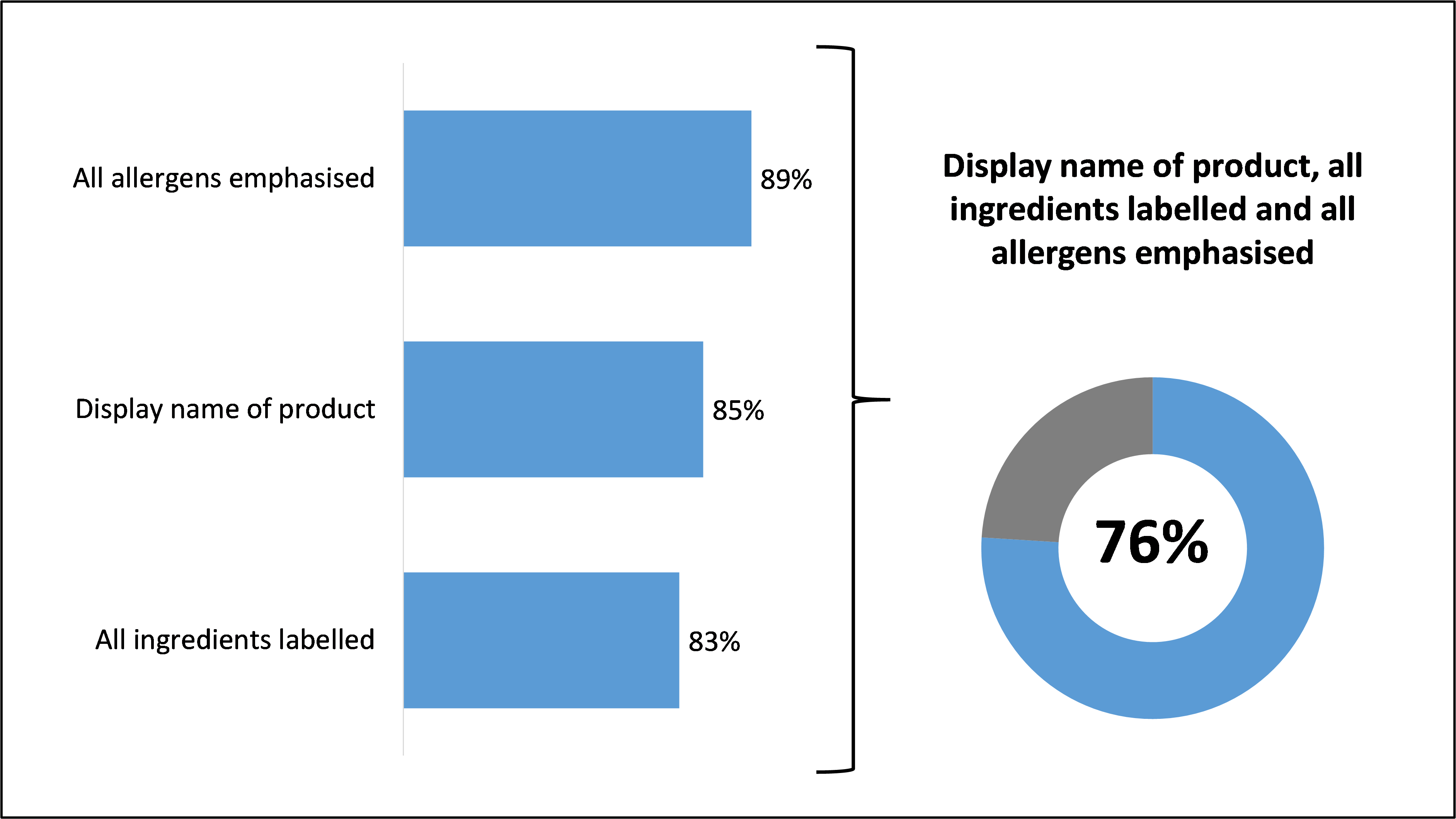
B1a. Thinking about the PPDS foods you sell, do you put the name of the food on the packaging? B1. Thinking about the PPDS foods you sell, do you display all ingredients on the packaging? B4. Are the allergens in your PPDS foods emphasised on the packaging? Base: FBOs that sell PPDS (838).
There were no statistically significant differences by country in the proportion of FBOs that were compliant with PPDS labelling requirements (England: 76%; Northern Ireland: 78%; Scotland: 79%; Wales: 74%).
However, there were notable differences in self-reported compliance by sector and size. With regards to sector, retailers were more likely than caterers to self-report compliance (87% vs 66%), with particularly high levels amongst butchers (92%), general retail (86%) and bakers (85%). Two thirds (66%) of catering businesses self-reported compliance, with particularly low levels amongst restaurants and cafés (62%).
With regards to size, the likelihood to self-report compliance increased with employee headcount. Around seven in ten (69%) of those with between 1 and 5 employees were compliant, rising to 80% of those with between 6 and 10 employees and 86% of those with 11 or more employees.
During qualitative interviews, a few FBOs that did not do all three components of the PPDS labelling requirements attributed this to low awareness and understanding. For example, a chocolatier said that they did not emphasise all allergens on PPDS foods at the time of the survey because they were unaware it was a requirement. This FBO said they had started to label in a compliant manner since participating in the survey. One FBO that operated a temporary canteen at events said that they tried their best to operate compliantly, but struggled to list all ingredients on their PPDS foods because of last minute changes to ingredients used in recipes. They did however stress that they take care in ensuring all allergens are labelled.
“In an ideal world everything would have full ingredients list with allergens emphasised. But it’s not possible to keep on top of it because of so many variables… we serve a lot of options of food and the chef might add something in last minute, like something to season a sauce, which would then have to be added.”
FBO, England, Catering, 11 or more employees
Amongst those that labelled all ingredients or emphasised allergens on the packaging of PPDS food, the most common way this information was presented was through labels printed in-house (64%). (footnote 4) A quarter (25%) used labels printed by a third party, while 8% used handwritten labels and 6% used labels supplied by their head office.
Across all sectors and sizes of FBOs, the printing of labels in-house was the most common method of presenting ingredients information on PPDS foods. However, there were some differences in the likelihood to use alternative methods. General retail businesses were more likely than average to use labels printed by a third party (33% vs 25%) and labels supplied by their head office (11% vs 6%), while restaurants and cafes were more likely than average to handwrite labels (15% vs 8%).
There were also clear differences between different sized FBOs in how ingredients information was presented on PPDS food packaging. Those with 11 or more employees were more likely than those with between 1 and 5 employees to print labels in-house (70% vs 61%). Conversely, those with between 1 and 5 employees were more likely than those with 11 or more employees to use labels printed by a third-party (18% vs 20%).
During qualitative interviews, many of those that printed labels for PPDS food in-house said they had invested in labelling software and hardware to assist them with compliance. These new systems were introduced because they were felt to be more accurate than alternatives and because they would reduce administrative burden on staff in the long run. However, a few commented that the initial financial outlay for new systems and the time required to set-up software (i.e. input ingredients information) had been significant.
“A new printer and tablet were introduced for ease of use… that's the easiest way to present the information to the customer without causing the staff headaches.”
FBO, Northern Ireland, General Retail, 1 to 5 employees
“We have a hand-held tablet so if I'm making a cheese and tomato roll, I'll put in 'large granary roll' … the label will then be generated [by the software] and put on after it’s made."
FBO, England, Catering, 6 to 10 employees
“[Ingredient information] is loaded into our labelling programme…that is the point where it puts allergens in bold and sorts the formatting … the labels we use just run off templates that have been approved by our [food safety] consultant.”
FBO, England, Delicatessen, 11 or more employees
Almost three quarters (72%) of FBOs reported using Precautionary Allergen Labelling (PAL) on their PPDS foods. Retailers were more likely than caterers to use PAL (76% vs 67%), especially general retail businesses (82%). With regards to size, those with 11 or more employees were more likely to use PAL (85%) than those with between 1 and 5 employees (64%) and those with between 6 and 10 (73%).
The most common reason for using PAL were to flag the risk of cross-contamination during preparation (44%), however it was also used to ‘pass on’ PAL used on ingredients sourced from suppliers and wholesalers (28%).
“Our deli is quite small and we do handle nut products, and unfortunately due to the size of the deli cross-contamination is probably a bit of a higher risk.”
FBO, Northern Ireland, General Retail, 1 to 5 employees
“We use ‘May Contain' when the manufacturer includes it on their packaging, but won't if it is not specified on their packaging… it means the manufacturer has been too lazy to say yes or no. That's one area that needs to be changed. It does or it doesn't, not maybe. If someone's got an allergy, they deserve better than that may contain.”
FBO, England, Catering, 11 or more employees
Checking labels
Three fifths (63%) of FBOs said they checked for changes in the ingredients of PPDS foods sourced from suppliers or wholesalers at every delivery (36%) or often (27%) (see Figure 5.7). A fifth (18%) said they conducted checks on an ad-hoc basis (e.g. when product lines or suppliers change), while 7% reported conducting checked ‘sometimes’ and 5% reported never conducting such checks.
Figure 5.7 How often the ingredients of PPDS foods sourced from suppliers or wholesalers are checked
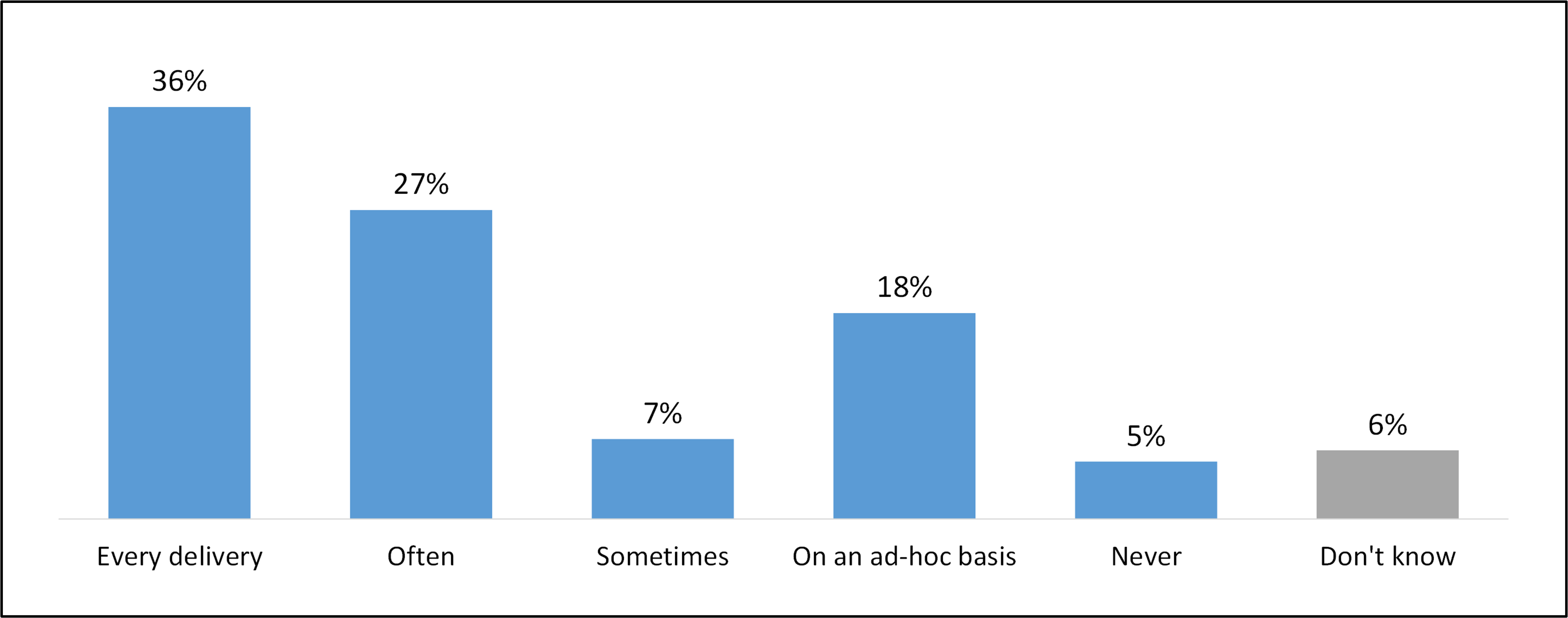
B6. How often do you check or audit the ingredients of products sourced from your suppliers or wholesalers that are used in your PPDS foods for changes? Base: FBOs that sell PPDS (838).
Of those who reported that they labelled all ingredients or emphasised allergens on the packaging of PPDS food, close to nine in ten (87%) reported checking that the ingredients and allergens listed are accurate and more than nine in ten (91%) reported updating ingredients listed on packaging when suppliers change ingredients or are unable to provide ingredients. (footnote 5)
With regards to checking the accuracy of labels, the most common circumstances in which checks were conducted were on a fixed schedule (e.g. once a day or once a week) (20%) and every time labels are printed (18%). Other circumstances mentioned by at least one in ten FBOs included when suppliers change a recipe (15%), each time a new batch of PPDS food is made (11%) and when a new PPDS product is introduced (10%).
More than three quarters (78%) of FBOs that reported updating ingredients listed on packaging when suppliers change or are unable to provide ingredients said they did this every time this situation arises. A further 8% said they did this most of the time, 3% some of the time, 2% hardly ever and 5% never. The remainder were unable to comment on the frequency of updating labels. FBOs that checked the accuracy of ingredients listed on the packaging of PPDS food every time labels were printed were more likely than other FBOs to update ingredients lists on PPDS packaging every time suppliers change or are unable to provide ingredients (90% vs 76%), indicating a correlation between the two practices.
As presented in Figure 5.8, two thirds (62%) of LAs described FBO compliance with PPDS labelling requirements in their area as ‘good’ or ‘very good’, with 3% of the opinion that compliance was ‘very good’. A third (33%) of LAs described compliance as ‘poor’ or ‘very poor’. It should be noted that LA perceptions of compliance are not directly comparable to self-reported levels of compliance amongst FBOs. The perceptions of LAs were based on observations made across multiple PPDS inspections, while FBOs were only considering compliance at their establishment.
Figure 5.8 LA views on overall levels of compliance with PPDS labelling requirements

D4. How would you describe overall levels of compliance with PPDS labelling requirements among the food businesses your local authority has checked? Base: LAs that have conducted compliance checks (123).
Experience of compliance
Overall, four fifths (79%) of FBOs that sold PPDS foods and were aware of the associated labelling requirements reported that they found it easy complying with the new rules, with 41% reporting that they found it very easy (see Figure 5.9). Around one in ten FBOs (11%) said that compliance had been difficult, while a similar proportion (9%) said that compliance had been neither easy nor difficult.
Figure 5.9 Extent to which FBOs have found compliance easy or difficult

C1. To what extent have you found it easy or difficult to comply with the PPDS labelling requirements? Base: FBOs that sell PPDS and aware of PPDS labelling requirements (766).
In line with this evaluation, 79% of FBOs that participated in baseline research conducted in 2019 predicted that compliance with the PPDS labelling requirements would be easy. (footnote 6) However, compared to expectations held in 2019, significantly fewer FBOs in this evaluation reported experiencing difficulty with compliance (11% vs 15%) and significantly more FBOs reported that compliance was neither easy nor difficult (9% vs 4%).
Across each of the four nations, the majority of FBOs reported finding it easy to comply with PPDS labelling requirements (England: 81%; Northern Ireland: 73%; Scotland: 72%; Wales: 65%). However, FBOs in England were more likely than those in Scotland and Wales to report finding it easy (81% vs 72% in Scotland and 65% in Wales).
With regards to sector, retailers were more likely than caterers to report finding it easy to comply with PPDS labelling requirements (85% vs 74%). Amongst retailers, general retail businesses stood out as being significantly more likely than average to have found compliance easy (91% vs 79%). Within the catering sector, FBOs which delivered events catering were significantly less likely than average to have found compliance easy (60% vs 81%).
With regards to size, larger FBOs were more likely to report finding compliance easy; 86% of those with 11 employees or more said it was easy compared to 77% of those with between 1 and 5 employees and 78% of those with between 6 and 10 employees.
Reflecting the results of the survey, during qualitative discussions many FBOs explained that they found compliance with PPDS labelling requirements to be easy. Most had experienced challenges to begin with but had typically overcome these with time following receipt of guidance or training and once new systems and processes had bedded in. A few FBOs said that the introduction of PPDS labelling requirements posed them little or no difficulty because they were meeting the PPDS labelling requirements before they became mandatory or because their head office had guided them through the transition.
"It was a bit of a shock ... it affected so much of the stuff that we sold ... but we do have all of the ingredient information … When we found out about it, we did an allergen course through the FSA."
FBO, Wales, Baker, 6 to 10 employees
“It's not difficult at all. With our till, we basically put it in and weigh it and it prints out the label for us with the allergens on it … we had always done it that way because it just makes sense.”
FBO, England, Delicatessen, 1 to 5 employees
As presented in Figure 5.10, amongst the minority (11%) of FBOs that found compliance with PPDS labelling requirements difficult, the top two causes were the time taken (46%) and the cost (31%) of introducing and updating labelling. Some FBOs attributed difficulty with compliance to awareness and understanding of the requirements, with 14% highlighting staff training and awareness as a source of difficulty and 11% reporting uncertainty around the definition of PPDS foods as a source of difficulty. Others said difficulties with compliance were associated with accessing (6%) and auditing (5%) ingredients from suppliers. The majority (75%) of FBOs reported one (40%) or two (35%) causes of difficulty, while around quarter (24%) reported experiencing three or more. (footnote 7)
Figure 5.10 Reasons why compliance was difficult
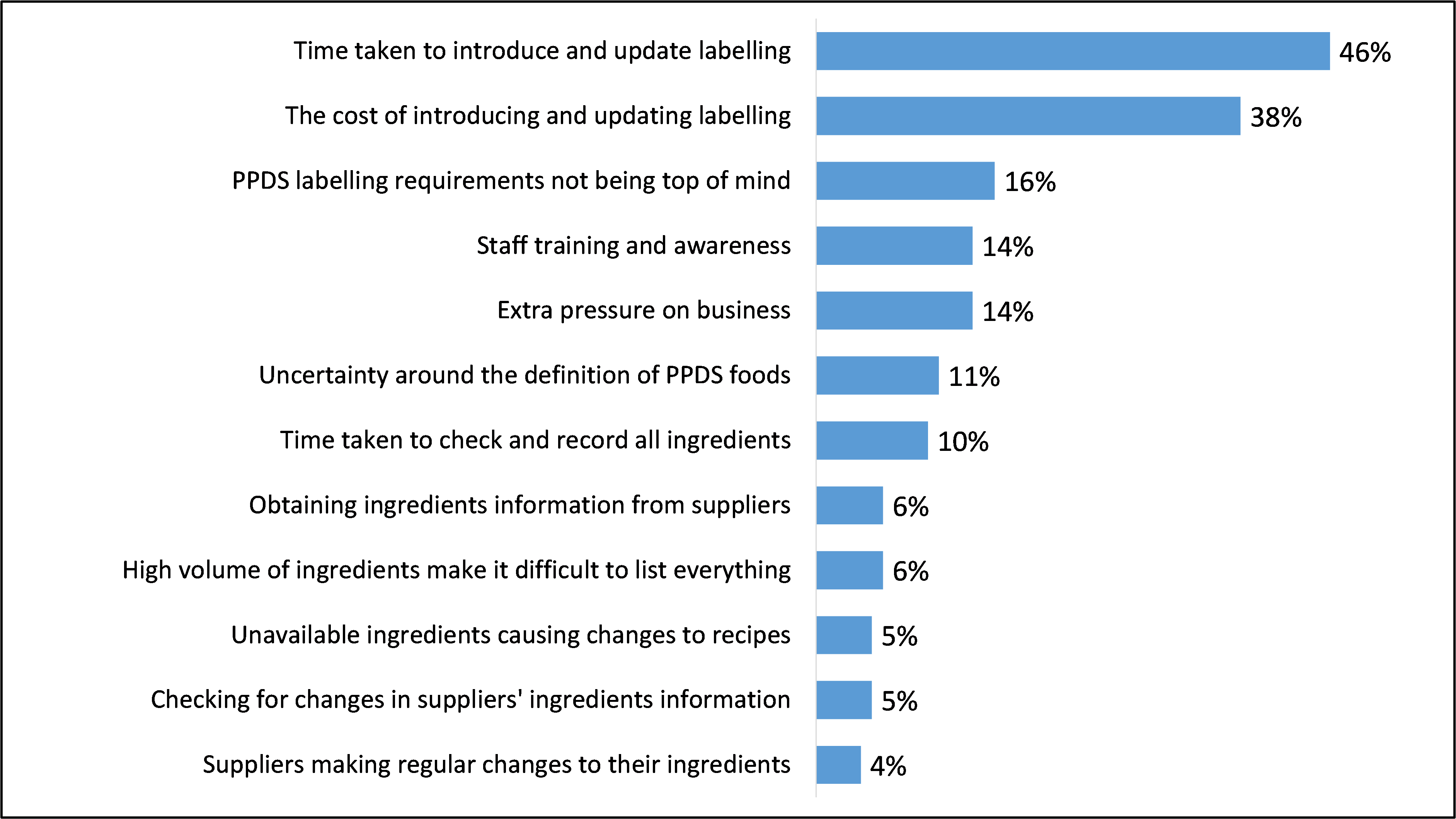
C2. What has made compliance with PPDS labelling requirements difficult? Base: FBOs that found compliance difficult (93). Responses under 5% have not been presented.
The causes of difficulty listed above were echoed during qualitative interviews, often by FBOs that had found compliance to be challenging, but also by some FBOs that reported finding compliance to be easy overall. Although this latter group had generally found meeting PPDS labelling requirements to be straightforward, there were also negative aspects to their experience.
Like the survey findings, the most prominent challenge mentioned during qualitative interview was the time required to introduce and update labelling. For some, this challenge had eased over time as investments in labelling software and printers took effect, but considerable time had been required up-front to programme software and an ongoing time commitment was needed to check ingredients and labels. For others, particularly those that had not invested in labelling software and printers and those with extensive PPDS product lines, the time required to introduce and update labelling had been an ongoing challenge. A few commented that they were considering investment in labelling software and printers to reduce administrative burden.
"I purchased a new labelling system 10 years ago that was unable to meet the requirements, so I had to buy a new one that was quite expensive. It was very time consuming initially for me, to formulate ingredients and allergens onto that system. Now, it's relatively easy but I must have spent 50 hours of my time programming it.”
FBO, England, Catering, 6 to 10 employees
“I'd say [our overall experience] is fairly positive, but it's too long winded now … the challenge is having to check if the allergens have changed on delivery, and the time it takes to change this and print off an extra label.”
FBO, England, Catering, 1 to 5 employees
Where the time required to introduce and update labelling for PPDS foods were highlighted as a challenge, often so too were costs. This was typically because of the cost of staff time to prepare and check labels of packaging. Some FBOs identified the need to purchase labels and ink for printers as overheads brought about by PPDS labelling requirements. Further detail on the impact of PPDS labelling requirements on business costs is presented in Chapter 6.
Furthermore, as covered in Chapter 4, some FBOs explained during qualitative interviews that they occasionally encountered confusion about the definition of PPDS. This was a source of difficulty in terms of compliance as it meant that some businesses were unclear whether they had applied labelling to all relevant food products.
In contrast to FBOs self-reported experiences of compliance, close to nine in ten LAs (87%) felt that FBOs had found compliance with PPDS labelling requirements to be difficult, with a third (33%) of the opinion that they had found it very difficult (see Figure 5.11). One in ten LAs said that FBOs had found compliance easy (10%), with only 1% of the view that they had found it very easy. It should be noted that LA views on the extent to which FBOs have found compliance to be easy or difficult are not directly comparable to the self-reported experience of FBOs. The perceptions of LAs were based on observations made across multiple PPDS inspections, and there is a potential for them to be skewed by instances of non-compliance. Conversely, there is a possibility that the accounts of FBOs are influence by a self-report bias.
Figure 5.11 LA views on the extent to which FBOs have found compliance easy or difficult

F3. Overall, how easy or difficult do you think food businesses have found complying with PPDS labelling requirements? Base: All LAs (126).
Despite LAs having a different perspective on the prevalence of difficulty, the reasons why they felt FBOs found compliance difficult were closely aligned with those identified by FBOs themselves. Indeed, the top four causes of difficulty were the same across both audiences. These were centred on the time and cost of labelling, the knowledge of staff and labelling requirements not being top of mind. Outside of these top four, there were some causes of difficulty that were not mentioned by FBOs, notably technical limitations at the premises (83%), staff turnover (59%) and information not being available in languages others than English (48%). These are shown in Figure 5.12.
Figure 5.12 LA views on why FBOs have found compliance difficult
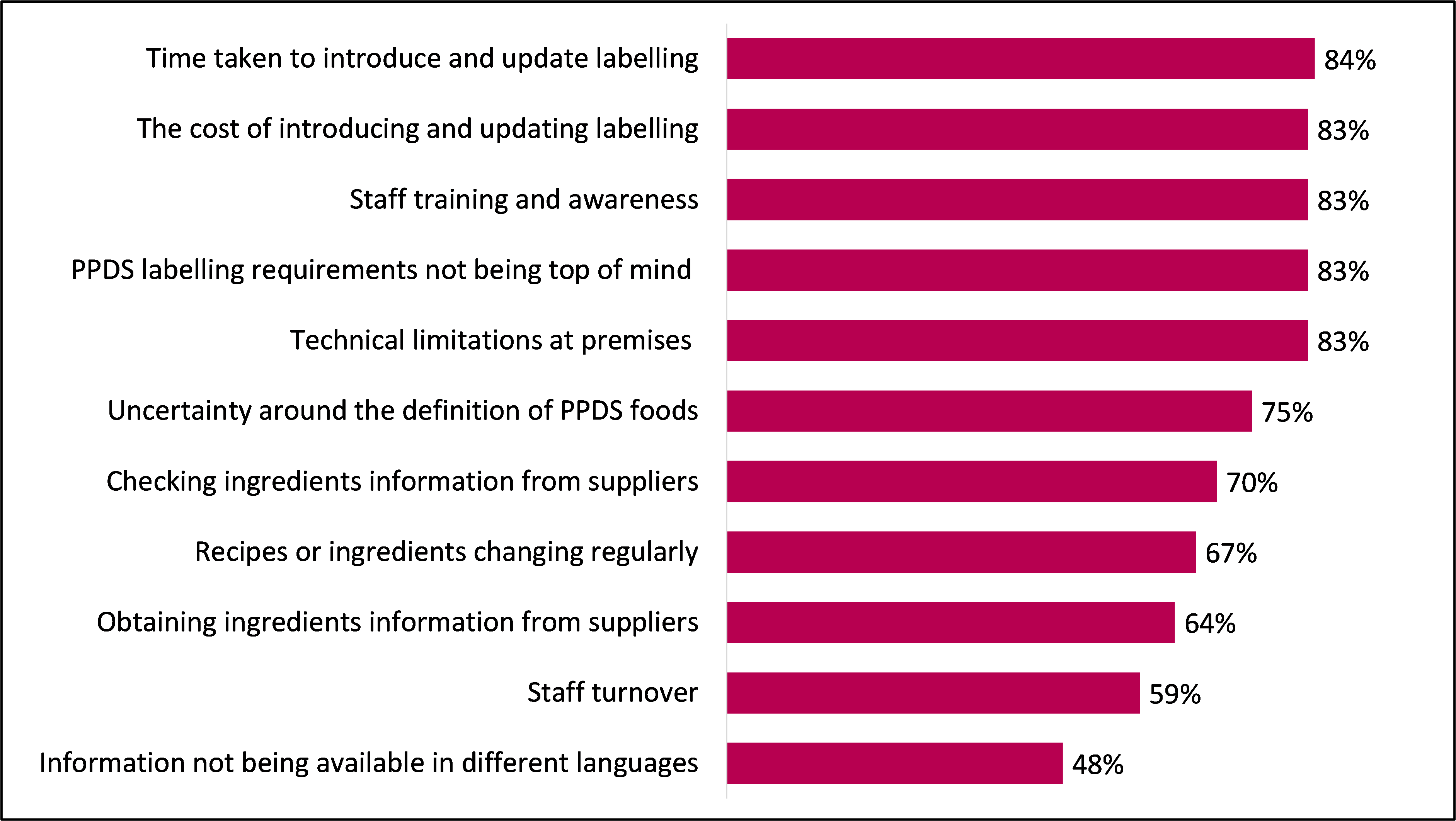
F4. What has made it difficult for food businesses to comply with PPDS labelling requirements? Base: LAs that thought FBOs have found compliance difficult (109).
Amongst the LAs that said FBOs had difficulty with compliance, around half (47%) identified smaller FBOs as those that have the most difficulty. (footnote 8) A quarter (26%) highlighted takeaways as having particular difficulty with PPDS labelling requirements, followed by convenience stores (22%), sandwich bars and delicatessens (17%), bakers (16%) and butchers (15%).
The suggestion that smaller businesses have the most difficulty with compliance chimes with the findings of previous research the FSA conducted with LAs in April 2022, in which 72% said they had concerns about the level of compliance amongst micro FBOs and 58% said they were concerned about compliance amongst small FBOs. (footnote 9) By comparison, only 4% said they were concerned about compliance amongst large FBOs.
During qualitative interviews, some LAs said that smaller FBOs have difficulty with compliance because of lower awareness and understanding of PPDS labelling requirements. (footnote 10) This was often attributed to smaller FBOs not having the time or dedicated staff to oversee food allergen labelling. Some attributed it to smaller FBOs being more likely to have informal and shifting supply chains which make managing ingredients information challenging, while others said smaller FBOs have limited financial capability to be able to invest in training and systems, which has been compounded by the recent economic climate.
“Some understand what they need to do, but we do see non-compliance. The main reason is a lack of time, especially amongst the smaller businesses. Some do not have PPDS on their radar at all, have no idea what they need to do."
Local Authority, England
"If one week a business uses one supplier and the next week, they use a different one, they might have completely different ingredients. And small businesses are having to change their labelling very often to comply with that ...They are small businesses, they aren't a big food manufacturer with quality assurers, it's usually just one business owner who has a million other things to do."
Local Authority, England
Larger FBOs, particularly those that formed part of a chain, were considered by LAs to be less likely to experience difficulties with compliance. These FBOs were said to possess the resources and financial capabilities to be able to deliver training on PPDS labelling requirements, employ staff to oversee implementation and invest in new systems. Some LAs also highlighted the centralised supply chains of larger FBOs as a factor which makes compliance easier.
“Where you've got larger businesses like the national chains… they can get people in to work out the legislation and they've got fairly good controls over the ingredients and the suppliers and the products that are coming in.”
Local Authority, Wales
“Bigger businesses have quality assurers, and may have a primary authority partnership, so they are generally going to get it right.”
Local Authority, England
Takeaways were highlighted by LAs as a group of smaller FBOs that face distinct challenges in terms of meeting PPDS labelling requirements. It was explained that the common mixture of direct and distance sales amongst these FBOs created additional administrative burden and confusion, with different labelling requirements applying to the same food products depending on whether they are collected by the consumer (where PPDS labelling requirements apply) or delivered to the consumer (where they do not). Some said that the frequent sale of prepacked condiments and sauces was a cause of difficulty as it meant there was a considerable amount of labelling required, while others said that, where English is not the first language of staff, takeaways had difficulty following guidance and writing compliant labels.
“If you go into a takeaway and ask for a pot of mayonnaise and they squeeze it out in front of you, it doesn't have to have a label and allergen information can be provided verbally. But if businesses fill those pots in advance to save time, they have to label those same mayonnaise pots."
Local Authority, England
“Sometimes there are language barriers where English is not their first language so they have a difficulty understanding what is required and then need to get the labels right where the wording may not be easy for them.”
Local Authority, Scotland
Support and guidance
Of FBOs that sold PPDS and were aware of the PPDS labelling requirements, nearly all (97%) had accessed support or guidance to learn about the requirements and how to comply with them. (footnote 11) As presented in Figure 5.13, the most common source used by FBOs was the FSA and FSS (68%), followed by LAs (49%) and Trading Standards or Environmental Health Officers (47%).
Figure 5.13 Sources of support and guidance used by FBOs
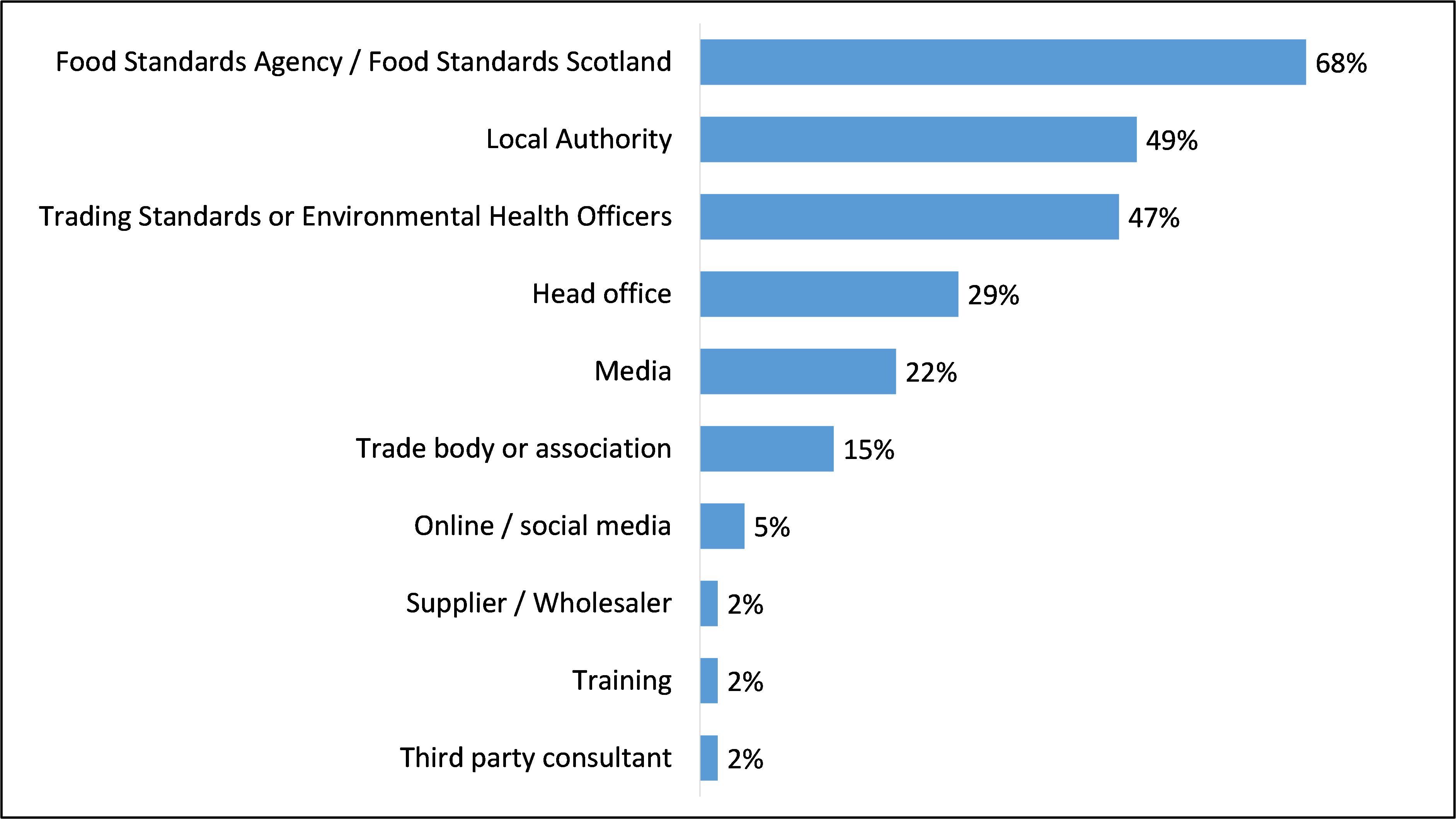
C8. Which, if any, of the following sources of support and guidance have you used to learn about the PPDS labelling requirements and how to comply with them? Base: FBOs that sell PPDS and aware of PPDS labelling requirements (766).
Support and guidance accessed from the FSA, FSS and LAs was highly regarded, with nearly all FBOs that had used these sources considering them to be useful.
- 96% of those that used support and guidance from the FSA or FSS considered it useful, with more than three fifths (62%) considering it to be very useful (n=502)
- 92% of those that used support and guidance from LAs considered it useful, with half (51%) considering it to be very useful (n=371)
During qualitative interviews, FBOs that had accessed support and guidance from the FSA or FSS explained that this typically involved accessing online resources (e.g. written guidance and videos). Most had a positive experience of using these resources, commenting that they came away equipped with a good understanding of what counts as PPDS and what needs to be included on the label.
“Guidance on FSA website is good… it tells you what constitutes PPDS and what you have to have on the labels, fairly self-explanatory if you take the time to look at it and read it, it's a very simple job to understand.”
FBO, England, Catering, 1 to 5 employees
A couple of FBOs that took part in qualitative interviews reported that they did not find FSA and FSS content helpful. This was typically down to difficulty understanding the definition of PPDS and applying it to their business setting. These FBOs therefore opted to access support and guidance from alternative sources (e.g. suppliers and consultants). Some FBOs had support and guidance from the FSA or FSS by participating in training on food labelling.
“I felt that [our supplier] had much better and simplified information than the Food Standards Agency. They had more information and they had streamlined the information, so you knew exactly what you needed to do.”
FBO, England, Catering, 11 or more employees
During qualitative interviews, many FBOs that had received support and guidance from their LA explained that this occurred at the point of an inspection or visit. This was often described as a positive experience as it gave FBOs the opportunity to get a professional opinion on whether their practices were compliant and clear up any areas of uncertainty. A few FBOs had proactively reached out to their LA for assistance via email or telephone, and a couple had received communication from their LA signposting them to support and guidance without request.
“We had a visit from [Local Authority] before Christmas…to have someone from the Authority come in and say, ‘you're doing it in the right way, whatever processes you're using is working’, that gave us a bit of confidence.”
FBO, Wales, Butcher, 1 to 5 employees
“We got sent a letter from [Local Authority] informing us when the law would be implemented about 6 weeks in advance. It contained various links to FSS web pages which were useful. Particularly the video and examples given about some common products.”
FBO, Scotland, Baker, 1 to 5 employees
Amongst those that did not access support and guidance from the FSA, FSS or LAs, the most common reasons were that they did not require support and guidance (FSA or FSS: 29%; LAs: 37%), that they received the help they needed from their head office (FSA or FSS: 21%; LAs: 15%) and that they thought other sources would be more useful (FSA or FSS: 16%; LAs: 15%). (footnote 12)
More than two thirds (68%) of FBOs said they did not require any additional information to help make compliance easier, suggesting that they were content with the support and guidance already available. A quarter (26%) of FBOs felt they would benefit from additional information. This was more likely amongst FBOs in the catering sector than those in the retail sector (31% vs 21%).
However, it was delicatessens, who sit within the retail sector, that displayed the strongest appetite for additional information (51%). With regards to size, FBOs with between 1 and 5 employees were more likely than those with 11 or more employees to identify a type of additional information that would be beneficial (29% vs 19%).
The most common topics of interest were information on the legal requirements for providing food information in general (6%), the allergens that need to be emphasised on PPDS labels (4%) and how to identify PPDS food (4%). These FBOs typically wanted this additional information to be made available in written form, either as online resources (41%) or hard copy resources (39%).
Although there was a low appetite amongst FBOs for additional support and guidance, nearly all (95%) LAs felt that further action could be taken to make it easier for FBOs to comply with PPDS labelling requirements. As presented in Figure 5.14, these actions often related to additional support and guidance, with three quarters (75%) suggesting that FBOs would benefit from general training on how to comply with the requirements, and two thirds identifying an opportunity for more guidance from the FSA and FSS on compliant packaging (67%) and best practice in terms of labelling (65%).
In addition to actions related to support and guidance, some LAs felt that that it would be easier for FBOs to comply if the scope of the PPDS labelling requirements were altered. Two thirds (67%) said that suppliers and wholesalers should be mandated to notify businesses about recipe changes, and more than half (55%) said that the requirement to label PPDS foods with full ingredients lists should be removed, with the emphasis of the legislation being placed on allergens instead.
“Previously there were labels available that had the fourteen allergens on them and businesses could tick these labels and put it on the lid of the container saying contains egg or wheat and that was quite successful. Most don’t do that now because this other requirement has come in for PPDS so in some ways it has taken us backwards.”
Local Authority, Scotland
Figure 5.14 LA views on how FBO compliance with PPDS labelling requirements could be made easier
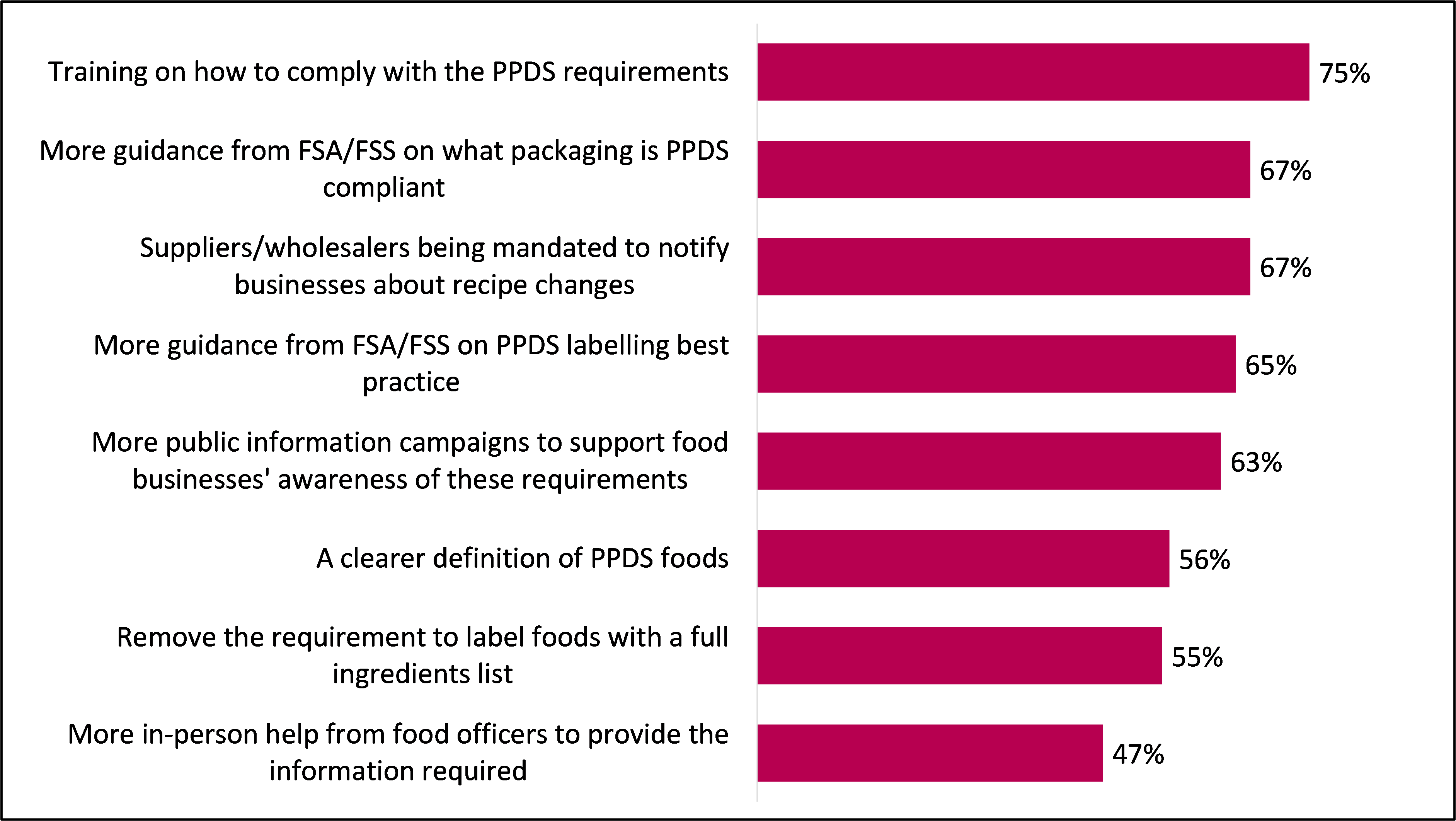
F6. What, if anything, do you think would help make it easier for food businesses to comply with PPDS labelling requirements? Base: LAs that thought FBOs find compliance less than very easy (121).
Local Authorities
Practices and processes
Nearly all LAs had checked FBO compliance with PPDS labelling requirements since they were introduced in October 2021 (98%). The small minority (2%) of LAs that had not conducted compliance checks explained that this was because their team was not responsible for checking food business compliance.
Where checks on FBO compliance with PPDS labelling requirements had been conducted, most LAs (95%) had done so by performing checks specific to PPDS foods at the same time as routine food safety inspections. However, this was seldom the only circumstance in which compliance checks were undertaken; around three quarters (73%) had also conducted reactive PPDS inspections (e.g. in response to complaints from consumers) and half (51%) had conducted visits to FBOs that were specifically focused on PPDS foods.
"It's been incorporated into routine inspections … if we're in a business for another reason like a complaint, we'll also check PPDS then if applicable. It's an additional task, not a separate activity."
Local Authority, Scotland
“There is a food standard inspection done as well as food hygiene because it is now under food law [in Scotland] so every premise will be checked for PPDS, and advice will be given if needed or if found to be deficient then it would be raised as a contravention and followed up.”
Local Authority, Scotland
“We prioritise serious allergen incidents because we get quite a number of those. And we want to deal with that rather than going around and checking every food business ... We are reactive rather than proactive with this legislation.”
Local Authority, England
LAs reported checking various aspects of the PPDS labelling requirements during visits to FBOs. As presented in Figure 5.15, nearly all (98%) checked that allergens are emphasised in ingredients lists, that the name of the food is displayed on packaging (97%), that there is a system for labelling in place (97%) and checked where food is packed (96%).
Figure 5.15 Aspects checked during PPDS compliance checks
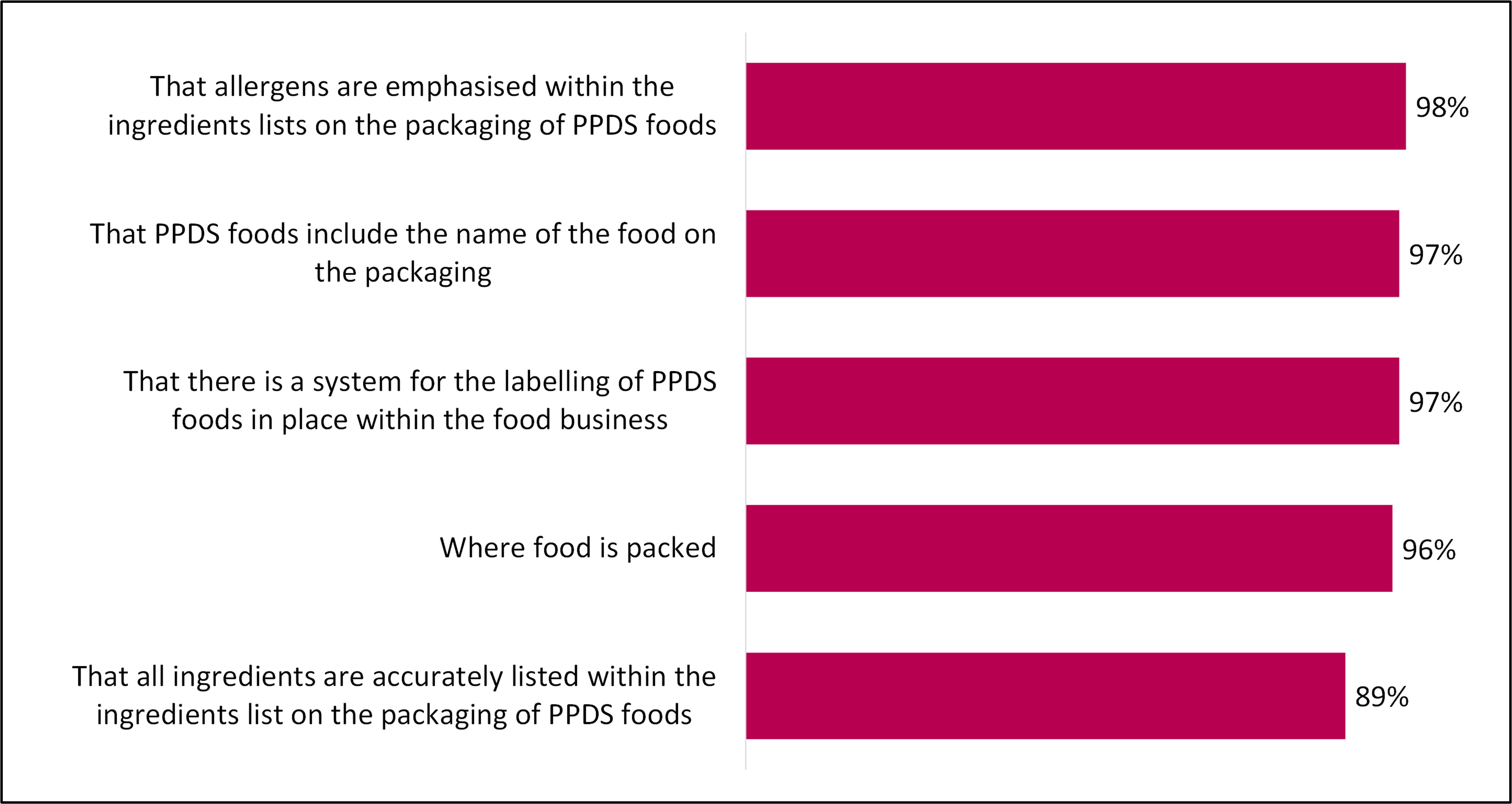
C2. When checking food business compliance with PPDS labelling requirements, do you check any of the following? Base: All LAs that have conducted compliance checks (123).
Nearly all (95%) LAs had encountered at least some cases of non-compliance during visits to FBOs since PPDS labelling requirements were introduced. Close to nine in ten LAs (89%) had observed there being no labels on the packaging of PPDS foods, and more than four fifths (84%) had observed no ingredients lists with a similar percentage (82%) observing incomplete ingredients lists. Other forms of non-compliance encountered by LAs are presented in Figure 5.16.
Figure 5.16 Types of non-compliance observed by LAs
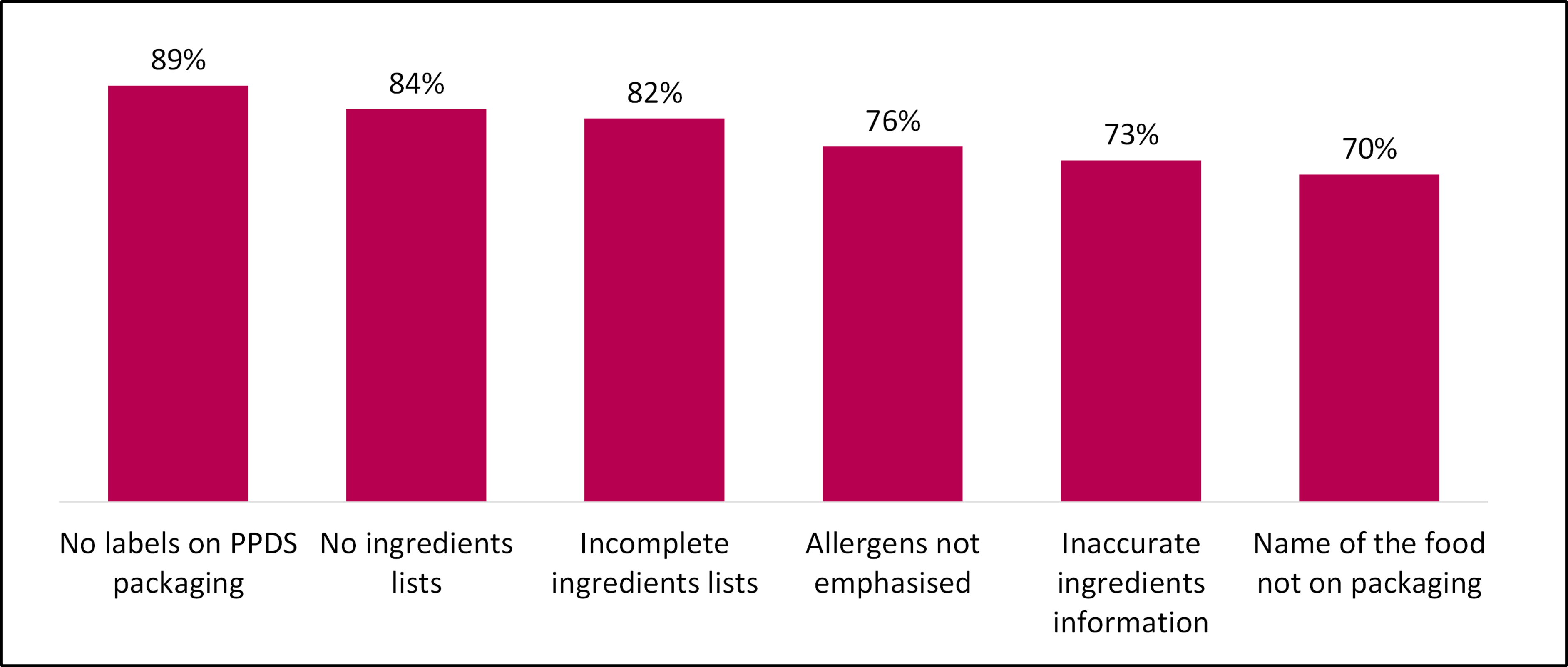
D5. Have you found any of the following examples of non-compliance in relation to PPDS foods in the businesses you've checked? Base: LAs that have conducted compliance checks (123).
When non-compliant practices were encountered, most LAs (91%) had responded by signposting FBOs to guidance and support , or by providing them with written (86%) or verbal (84%) advice. Some LAs reported escalating incidents of non-compliance and taking enforcement action. For example, written warnings had been issued by 40%, improvement notices had been issued by 8% and cautions had been issued by 2%.
During qualitative interviews, many LAs explained that their focus for the first year of the PPDS labelling requirements had been to educate FBOs and support them with compliance rather than pursuing enforcement. Where FBOs were found to be non-compliant, LAs had typically explained the contravention to FBOs, advised them to stop selling the PPDS food in question and arranged a re-visit. When LAs did report taking enforcement action, this was typically in instances where FBOs did not heed their advice or were found to still be non-compliant at the point of re-inspection. It was widely expected by LAs that enforcement action would become more commonplace over time as FBOs become more familiar with PPDS labelling requirements and repeat visits are conducted.
“We have made businesses aware of a contravention if they haven’t complied but no further action like notices of court. We have taken a softer approach to make sure people are aware first and if they don’t follow through, we issue a contravention and follow up to make sure that is remedied.”
Local Authority, Scotland
“We would always follow a graduated approach anyway with a new requirement and at this stage it is still about education, advice, and guidance … two businesses had no labelling so we told them ‘until you have the correct labelling you cannot sell it’. They acted on it straight away.”
Local Authority, England
Experience of compliance checks
As presented in Figure 5.17, most LAs said that checking compliance with PPDS labelling requirements was easy (71%), with 7% of the view that it was very easy. However, a quarter (25%) of LAs said that compliance checks were difficult.
Figure 5.17 LA experience of compliance checks

D1. How easy or difficult have you found it to check compliance with the PPDS labelling requirements? Base: LAs that have conducted compliance checks (123).
Of the small number of LAs that reported having difficulty with compliance checks (25%, n=31), the main reasons were: not having enough internal resource to visit and inspect all businesses to check for PPDS compliance (n=21), uncertainty around the definition of some or all PPDS foods (n=20) and difficulty checking the accuracy of PPDS ingredients lists (n=14).
During qualitative interviews, these same challenges were commonly mentioned by LAs that reported finding compliance checks to be easy overall. Many of these LAs said that compliance checks had been complicated by a lack of awareness and understanding amongst FBOs under their jurisdiction and, in some cases, amongst their own staff. Particularly in the early stages of the PPDS labelling requirements being introduced.
“It was difficult for officers to get their heads around what things were PPDS and what were not. So, trying to explain it to FBOs was difficult.”
Local Authority, England
“SMEs [small medium enterprises] struggle with these things, because they don't have the technical guidance and they quite often rely on us to be almost their consultants and help them. This is not supposed to be our job, but sometimes it's easier just to try explaining everything and this requires our officers sitting there and trying to help them. And that means spending a lot of time with businesses.”
Local Authority, Scotland
Many LAs said that constraints on internal resource and time had made it more difficult for them to check FBO compliance with PPDS labelling requirements. This was sometimes attributed to LAs having a backlog of FBO inspections to conduct following the COVID-19 pandemic.
“Time constraints are a big issue because we are limited to the time we can spend on an inspection and there are other inspections we have to carry out with a lot of admin we have to do.”
Local Authority, Scotland
“When PPDS came in, we were already facing a massive backlog of the ordinary work, without having something else to work on.”
Local Authority, Wales
Amongst the LAs that had conducted compliance checks and found the process less than ‘very easy’, the top three things that they felt would make compliance checks easier were: more resources for LAs (e.g. funding and staff) (29%), greater clarity on what food products are covered by PPDS labelling requirements (22%) and materials for LAs to share with FBOs (e.g. guidance handouts) and issue to FBOs (e.g. improvement notices) (21%).
Support and guidance
Virtually all (99%) LAs had undertaken activities to support and increase compliance with PPDS labelling requirements since they came into effect. As illustrated by Figure 5.18, the most common activity was signposting to FSA or FSS guidance and resources (85%). This was followed by visits to establishments to offer guidance in person (52%) and sending information with FBOs via physical letters and newsletters (44%) or email and digital newsletters (44%).
Figure 5.18 LA activities to support and increase compliance
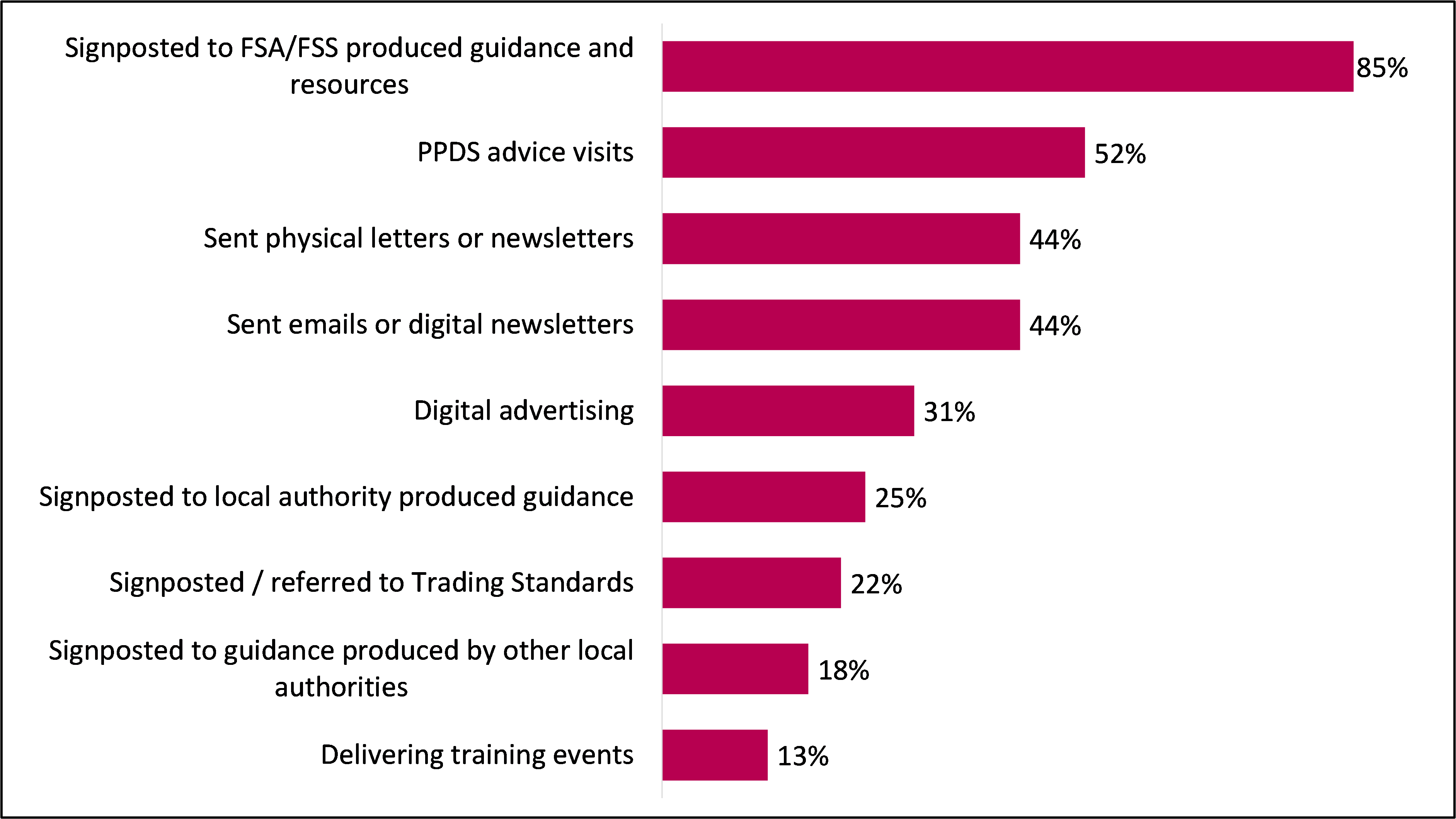
C6. What activities, if any, have you used to support and increase compliance with PPDS labelling requirements since October 2021? Base: All LAs (126).
During qualitative interviews, many LAs explained that they had undertaken a blanket approach to activities designed to support and increase compliance with PPDS labelling requirements, encompassing all businesses in the LA. For example, many reported distributing links to FSA and FSS resources or to resources they had developed themselves via email ‘mailshots’, postal campaigns, and social media campaigns ahead of 1 October 2021. A few said they held webinars on PPDS labelling requirements which were open to any businesses that were interested in attending.
“We have provided free online webinars for businesses on allergens and PPDS. It was successful, with hundreds of businesses attending and positive feedback. The drawback is that these businesses are the ones that are keen to comply, and generally these are not the businesses that are failing [on compliance checks].”
Local Authority, England
“We used email to get in touch with all the businesses we had on our database to say this is coming in and what it will mean for your business; ‘here is the guidance and links so have a look online’ and we encouraged them to use the online allergen training again, which is on the FSS website.”
Local Authority, Scotland
Some LAs that took part in qualitative interviews said they had decided to take a targeted approach and only conducted activities with FBOs where the PPDS labelling requirements were thought to be most relevant. For example, a few LAs had focused their efforts on bakers and butchers while one LA said they had sent communications to FBOs where there was a greater risk of non-compliance.
“I drafted an email using an FSS template and information that they had provided to do promotional work, and basically took a list of food businesses within [Local Authority] that we thought would potentially have this type of product, and we sent out emails.”
Local Authority, Scotland
Some LAs did a combination of general and targeted activities. An example of this can be seen in the case study presented in Figure 5.19, which covers the experience of a Scottish LA and an FBO under their jurisdiction.
A few LAs had not carried out any activities beyond the delivery of advice and guidance during routine inspections. Some of these LAs said that they lacked the time and resources to be able to undertake a communications campaign or host training events, while a few were of the opinion that it was not their responsibility to carry out such activities.
“It's something we'd expect the FSA to publicise rather than us, we certainly don't have the resources for it… there aren't enough Food Officers out there, so we have to be reactive rather than proactive.”
Local Authority, England
Figure 5.19 Case study: support and guidance (accessible version)
A Scottish Local Authority that had undertaken multiple activities to support and increase compliance with the PPDS labelling requirements. This included:
- Sending physical letters
- Digital advertising
- Signposting to FSS produced guidance and resources
- In-person visits by Environmental Health Officers
- Creating a dedicated PPDS mailbox
The Local Authority began delivering these activities in the lead up to the PPDS labelling requirements being introduced. Most activities were aimed at all businesses within the Local Authority. However, they also targeted catering facilities within institutions (e.g. schools and hospitals) with physical letters as they were considered to be high-risk.
"There was some proactive stuff we shared with businesses in late 2021 through visits and we had information on social media.”
A bakery, located in the same Local Authority, with between 1 and 5 employees. The owner recalled receiving a visit from an Environmental Health Officer ahead of the PPDS labelling requirements being introduced, and being advised to change their labelling practices from October 2021.
“An Environmental Health Officer visited our market stall as part of a drive to inform all local businesses…. we had a chat about the requirements and he also gave an example of something we'd need to change… he pointed at a cake that was wrapped in plastic and told us that from October 1st we’d have to label it.”
They had not received any further support and guidance from the Local Authority. With hindsight, while the conversation with the Environmental Health Officer was useful, they would have liked to have been given a physical document to reference. The FBO has used FSA and FSS resources to develop an understanding of the PPDS labelling requirements and how best to comply with them. Video clips were identified as particularly useful.
-
9% of all consumers with food hypersensitivities reported never buying PPDS foods (n=170).
-
89% of all consumers with food hypersensitivities purchased PPDS foods and checked labels on PPDS foods (n=1,606).
-
90% of FBOs that sold PPDS food reported labelling all ingredients or emphasising allergens on the packaging (n=781).
-
90% of FBOs that sold PPDS food reported labelling all ingredients or emphasising allergens on the packaging (n=781).
-
The food industry’s provision of allergen information to consumers | Food Standards Agency.
-
[1] 1% of FBOs that found compliance difficult were unable to comment on the source of difficulty.
-
87% of all LAs reported that FBOs found compliance difficult (n=109).
-
Unpublished internal research conducted by the FSA.
-
This aligns with the findings presented Chapter 4, where it was reported that those with between 1 and 5 employees were less likely than those with 11 or more employees to be aware of the PPDS labelling requirements (87% vs 97%).
-
83% of all FBOs that sold PPDS foods and were aware of the PPDS labelling requirements (n=766).
-
33% of FBOs that sold PPDS foods and were aware of the PPDS labelling requirements did not use FSS or FSA support and guidance (n=264). 52% of FBOs that sold PPDS foods and were aware of the PPDS labelling requirements did not use LA support and guidance (n=395).
Consumers
Most commonly, consumers with FHS reported no change to their perceptions and behaviour. Some of the findings from this research suggest that the implementation of PPDS labelling requirements has had a positive effect on the perceptions of some consumers and the behaviours of a minority, however, these were not experienced by the majority.
Where there were some positive changes, this was in relation to the perceived availability of ingredients information and confidence in buying PPDS foods, and more commonly seen in younger consumers. Only a minority of consumers reported purchasing PPDS foods more often since the introduction of PPDS labelling requirements. Qualitative research suggests this is likely to be due to concerns about the risk of cross-contamination.
Perception of availability of allergen information
Consumers with FHS were roughly evenly split in their perception of whether the availability of information (needed to identify a food that may cause an unpleasant reaction) had improved since the introduction of PPDS labelling requirements. Whilst 42% said that in their opinion it had improved, 37% said they felt it was the same. Moreover nearly a fifth (18%) said that they didn’t know, indicating that these consumers have not noticed the availability of information changing suggesting a potential lack of impact. Only a very small proportion (3%) felt the availability of information had worsened.
Figure 6.1 Change in the availability of information needed to identify a food that may cause an unpleasant reaction
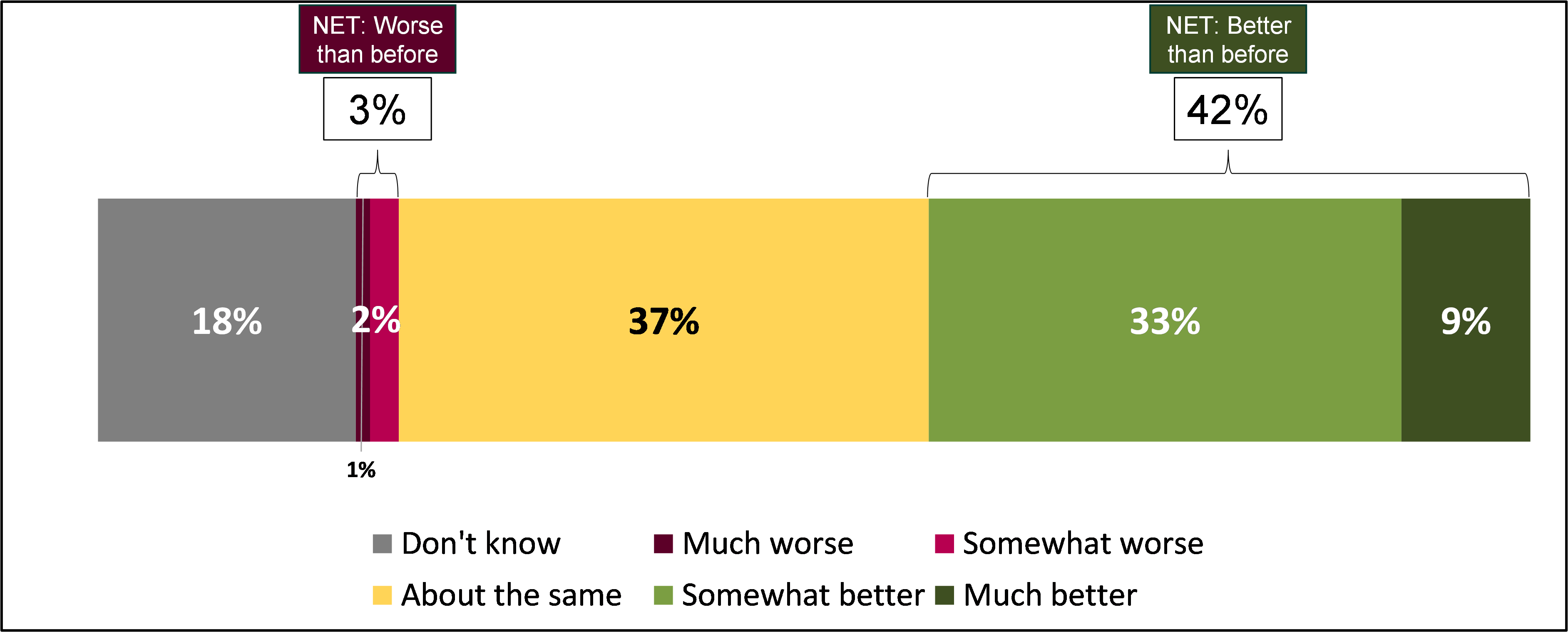
E1. Since the introduction of PPDS labelling requirements in October 2021, has the availability of the information you need to help you identify if a PPDS food might cause you or your child a bad or unpleasant physical reaction gotten better, worse, or remained the same? Base: Consumers that buy PPDS foods (1639).
There was no difference by country in the proportion of consumers that reported an improvement in the availability of ingredient information since the PPDS labelling requirements were introduced (England: 42%, Northern Ireland: 38%, Wales: 39%). However, younger consumers aged between 18 and 34 were more likely than those aged between 34 and 64 and those aged 65 and over (52% vs 40% and 40% respectively) to report an improvement in the availability of information, as well as those that purchased PPDS foods sometimes or often who were more likely than those that purchased PPDS foods rarely or never (51% vs 36%). Consumers who only had an allergy/ intolerance to a regulated allergen rather than only a non-regulated allergen were also more likely to report an improvement (43% vs 27%).
When discussing the impact of improved information availability on PPDS labelling during the qualitative interviews, many consumers spoke about how they felt better equipped to make informed purchasing decisions. Consumers often attributed this to the emphasis of allergens on PPDS labels, as this made it quicker and easier for them to identify ingredients that could cause them an unpleasant or life threatening reaction.
“They allow you to make a choice with a bit more confidence … The use of the bold print and italic letters is useful in helping you to make an informed choice.”
Consumer, England, Severe hypersensitivity
“Now it’s quite obvious I can pick it up and if there’s nothing in bold, I know it’s got nothing in that’s wheat; so I’m more open to looking at purchasing PPDS.”
Consumer, England, Severe hypersensitivity
“When it is on the labelling, and right there in front of you it definitely gives you more confidence to go and purchase it.”
Consumer, Northern Ireland, Severe hypersensitivity
However, some consumers did not feel as though they were better equipped to make informed purchasing decisions concerning PPDS food. This was typically because of concerns about the ability of FBOs to control for cross-contamination in food preparation area and the fact that cross-contamination risks were generally not covered on PPDS labels.
“I'm not at all confident and I don't think Natasha's Law has changed that at all. Natasha's Law has changed the way that ingredients are listed, it doesn't talk about cross-contamination or the things that matter to me.”
Consumer, England, Severe hypersensitivity
“The added issue for me is that they could make a sandwich with gluten free bread and with all the right ingredients but could make it on the same chopping board and with the same knife as with a normal sandwich ... The risk of cross-contamination is a very real issue for me. And in my understanding, Natasha's law doesn't cover that.”
Consumer, England, Severe hypersensitivity
Improvement in the ability of consumers to make informed decisions was also mentioned by FBOs and LAs. It was felt that the PPDS labelling requirements had benefitted consumers with food hypersensitivities by providing them with the information they need to decide whether a PPDS food product is safe to eat, without having to ask for assistance.
“I feel that we’ve covered all bases … they can make an informed decision themselves.”
FBO, Scotland, Restaurant/café, 11 or more employees
“I think it is really good for the younger consumer - they may have an embarrassment or concern about asking in front of others - the label can tell them what they need to know.”
Local authority, Northern Ireland
However, PPDS labelling requirements were rarely seen as a perfect solution for those with food hypersensitivities due to the chance of errors being made on labels (particularly amongst smaller businesses with shifting supply chains) and labels not covering the risk of cross contamination. A couple of LAs commented that PPDS labelling requirements may give consumers a false sense of security.
“There might be some aspects in grab and go where it has made a difference to people and (with Natasha) it was a grab and go issue which arose through lack of accurate information rather than lack of any information. If you are an allergen sufferer with potentially very serious reactions, you do not trust anybody to handle food for you.”
Local authority, Scotland
Confidence when purchasing PPDS foods
As with improvements in availability of information, consumers were split as to whether their confidence had increased in buying PPDS foods since the PPDS labelling requirements were introduced. Two-fifths (41%) of consumers reported that they neither agreed nor disagreed, while another two-fifths agreed that their confidence in buying PPDS foods had increased since the PPDS labelling requirements were introduced, with one in twenty (5%) strongly agreeing. Around one in seven (14%) disagreed.
Figure 6.2 Consumer confidence increase in purchasing PPDS foods since the introduction of PPDS labelling requirements
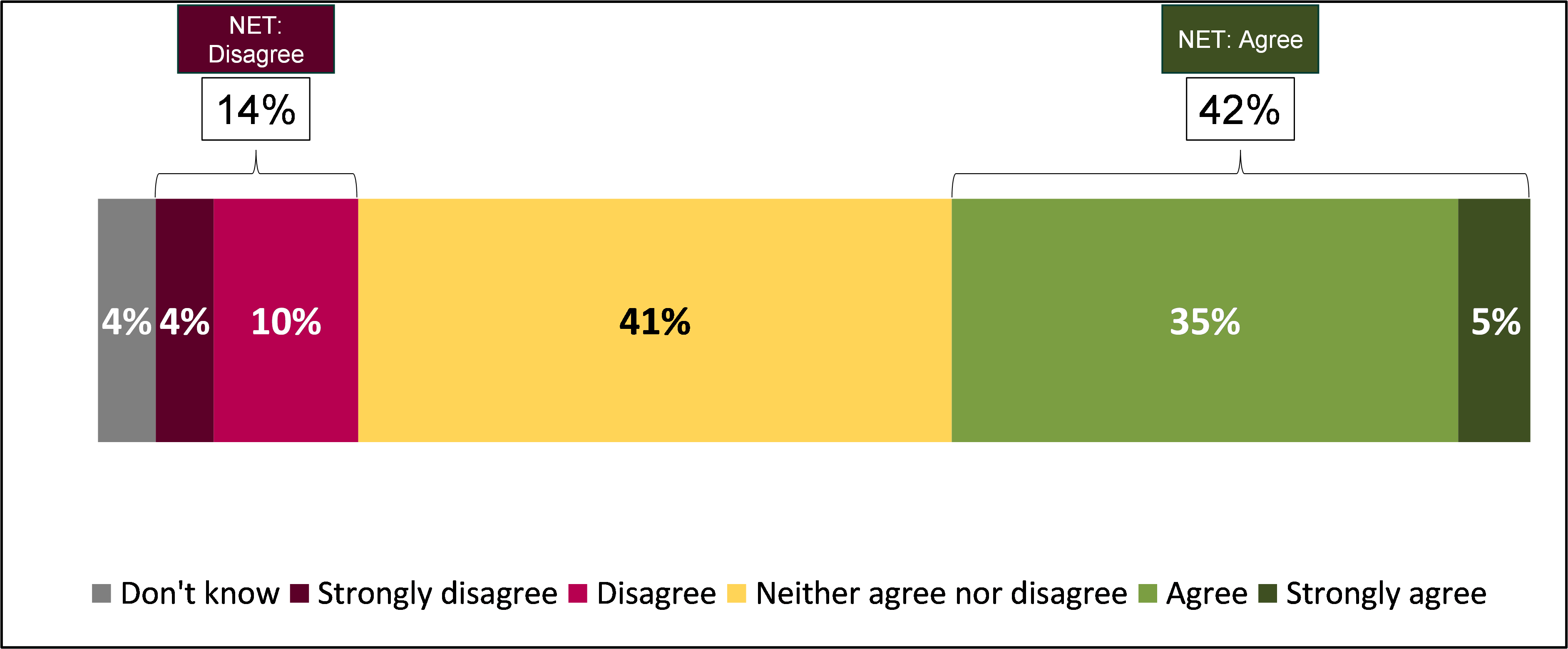
F4. And taking your experience over the last 12 months or so into consideration, to what extent do you agree or disagree that your confidence in buying foods for yourself or your child that are PPDS has increased since October 2021 when the new labelling requirements were brought in? Base: All consumers that buy PPDS foods (1639).
Similar to perceived improvements in the availability of allergen information, there was no difference by country in the proportion of consumers that reported improved confidence (England: 40%, Northern Ireland: 45%, Wales: 37%), but there was in terms of age and frequency of PPDS purchases. Consumers aged between 18 and 34 were more likely than those aged between 35 and 64 and those aged 65 and over to have increased confidence (51% vs 40% and 36% respectively) and so too were those who purchased PPDS foods sometimes or often compared to those who purchased PPDS foods rarely or never (48% vs 36%). Consumers with a regulated allergen were also more likely to report improved confidence compared with those who had a non-regulated allergen only (41% vs 31%).
Changes in purchasing behaviour
As presented in Figure 6.3, most consumers (65%) reported that their purchasing behaviour had not changed since the introduction of PPDS labelling requirements, with 17% of consumers reporting purchasing more PPDS foods and 14% reporting purchasing less.
Figure 6.3 Consumer PPDS purchasing behaviour since the introduction of PPDS labelling requirements
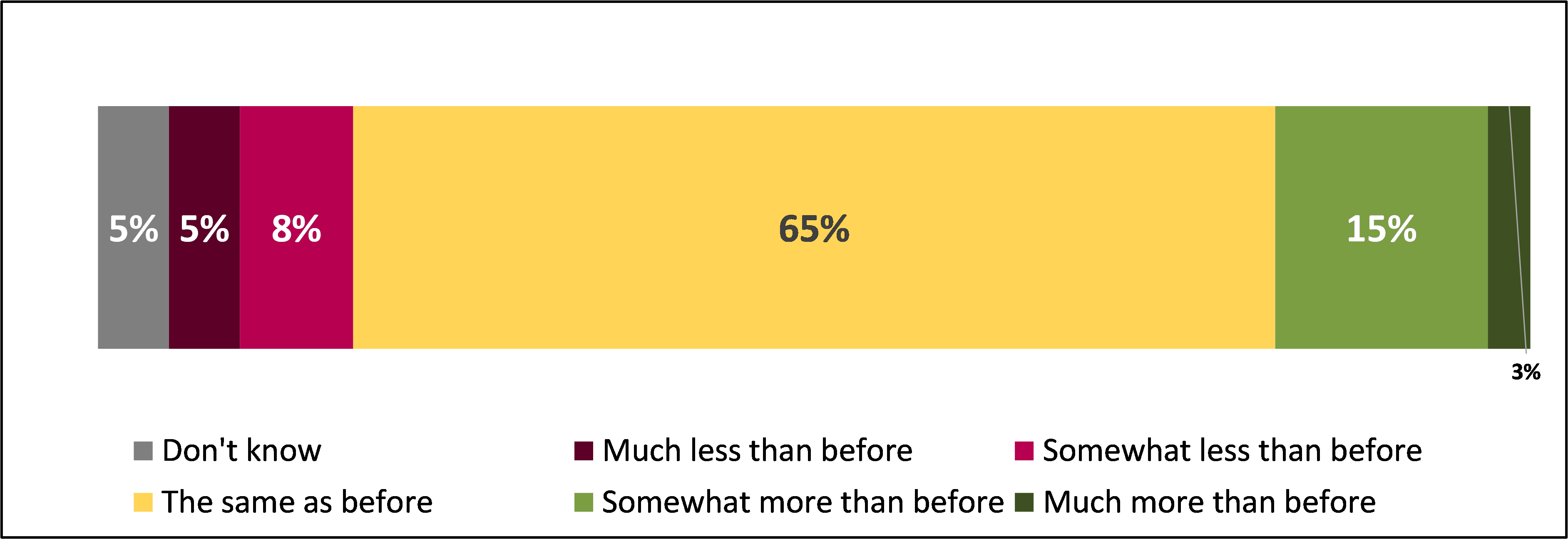
F3. And since the introduction of PPDS food label requirements, would you say you buy PPDS foods for yourself or your child…? Base: All consumers that buy PPDS foods (1639).
Consumers in England were more likely than those in Northern Ireland to purchase the same amount as before (66% vs 55%), while consumers with a mild or moderate allergy were more likely than those with a severe allergy to purchase the same amount of PPDS foods as before (77% and 69% respectively vs 61%). Older consumers aged between 35 and 64 as well as those aged 65 and over were more likely than those 18 to 34 to buy the same amount of PPDS foods as before (65% and 69% respectively vs 56%). It is worth noting that there were no differences by whether consumers had Coeliac disease or not, whether the respondent or child had a food hypersensitivity and whether the food hypersensitivity was to a regulated or non-regulated allergen.
Six in ten (60%) consumers who considered there to have been an improvement in the availability of ingredients information on PPDS foods (footnote 1) claimed they were purchasing the same amount of PPDS foods as before, while just under a third (31%) reported they were purchasing more PPDS foods since October 2021.
Similarly, whilst around a third (35%) of consumers agreed that their confidence in buying PPDS foods had increased since the introduction of the PPDS labelling requirements (footnote 2) it was more common (58%) that they reported buying the same as before, rather than more than before.
The likelihood of purchasing PPDS foods more often varied by geography and age. Consumers in Northern Ireland were more likely (28%) than those in Wales (21%) and England (16%) to purchase PPDS foods more often since the introduction of PPDS labelling requirements. Younger consumers aged between 18 and 34 were also more likely than those aged between 35 and 64, and those aged 65 and over (26% vs 17% and 12% respectively) to purchase PPDS foods more often.
As illustrated by Figure 6.5, the nature and severity of food hypersensitivities had a bearing over the likelihood to buy PPDS foods more often since the introduction of labelling requirements. Specifically, consumers with severe allergies or intolerances, were more likely than those with mild or moderate allergies or intolerances (19% vs 15% and 14% respectively), and consumers whose child had a food hypersensitivity or both the respondent and their child had a FHS were more likely than those where just the respondent had a FHS (24% and 29% respectively vs 14%). In addition, those with an allergy or intolerance other than Coeliac disease were more likely than those with Coeliac disease (20% vs 15%) to purchase PPDS foods more often than before October 2021. Consumers with allergies/intolerance to regulated allergens were also more likely than those with a non-regulated allergen only (18% vs 9%) to purchase PPDS foods more often.
Figure 6.4 Consumers who purchase more PPDS foods since the introduction of PPDS labelling requirements by nature and severity of hypersensitivity
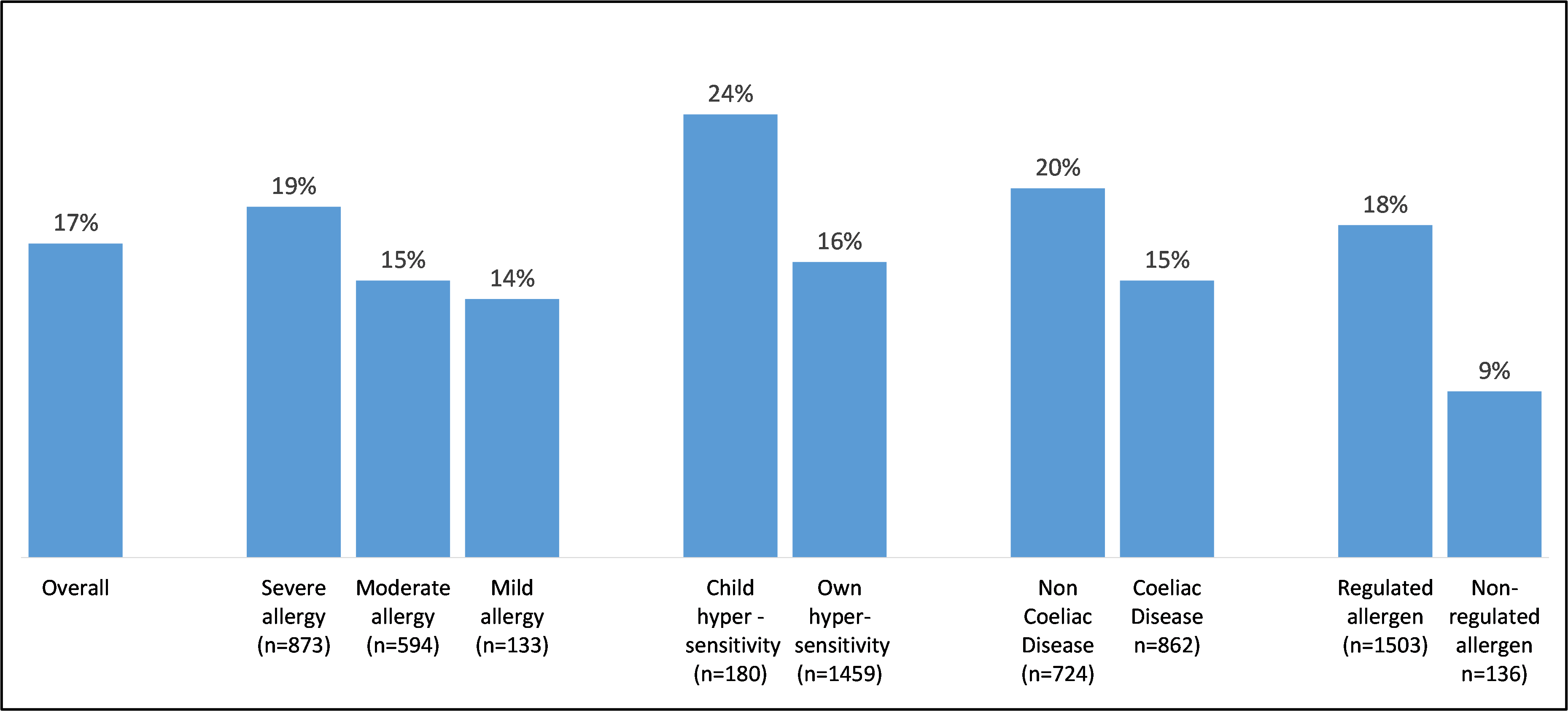
F3. And since the introduction of PPDS food label requirements, would you say you buy PPDS foods for yourself or your child…? Base: All consumers that buy PPDS foods (1639).
In addition to exploring any effect labelling requirements had on how often consumers purchased PPDS foods, the research also asked about changes to other behaviours (see Figure 6.6). For each of the behaviours asked about, the most common response was that their behaviour hadn’t changed. Six in ten (60%) FHS consumers indicated that they were just as likely to declare their/ their child’s allergy to a provider since the introduction of PPDS labelling. Similar proportions (59%) said that they were just as likely to ask the provider for written information as they were before, 55% to ask for verbal information and 53% were just as likely to rely solely on PPDS labelling as they were before.
However, a smaller group of consumers indicated that their behaviour had changed. A third (34%) said that they were now relying solely on PPDS labelling more than they were, with another third (33%) stating that they were now asking providers for verbal information more than before. Just under a third (31%) said they were now declaring their/their child’s FHS more than they were, and a fifth (20%) said they were now asking providers for written information more than they were.
Figure 6.5 Behaviour changes by consumers in response to the PPDS labelling
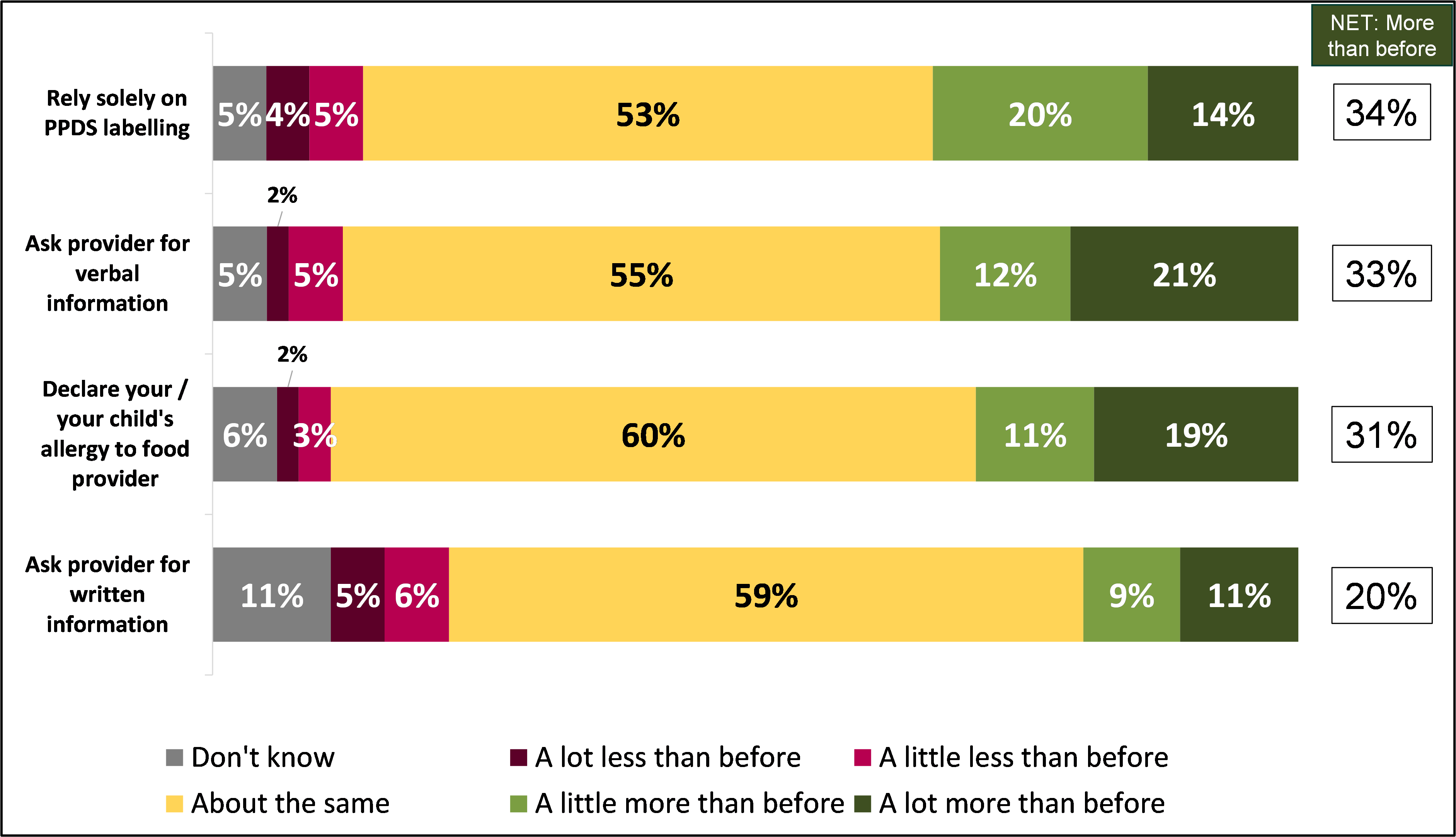
E3. Since the introduction of PPDS labelling requirements in October 2021, do you do any of the following more or less than before when purchasing PPDS foods? Base: Consumers that buy PPDS foods (1639).
There were some notable differences by subgroups of consumers, particularly in relation to:
- There were a few differences by country in terms of consumer behaviour changes. Consumers in Northern Ireland were more likely than those in England to declare their or their child’s allergy to food providers more frequently since the introduction of the PPDS labelling requirements (41% vs 30%), and to ask FBOs for verbal information on allergens (47% vs 32%).
- Consumers with severe allergies or intolerances were more likely than those with a mild or moderate allergies to declare their or their child’s allergy to food providers a lot more than before the introduction of the PPDS labelling requirements (23% vs 11% and 19% respectively ), and were more likely to ask FBOs for verbal information more frequently than consumers with mild allergies (36% vs 23%). Consumers with severe allergies were also more likely to ask FBOs for written information more frequently than consumers with mild or moderate allergies (24% vs 11% and 17% respectively).
- Consumers with Coeliac disease were more likely than consumers with a food hypersensitivity other than Coeliac disease to declare their or their child’s allergy more frequently (34% vs 26%), and to ask FBOs for verbal information more often (37% vs 28%).
- Consumers who purchased PPDS foods sometimes or often were more likely than those who purchased PPDS foods rarely or never to rely solely on PPDS labelling more frequently (39% vs 30%).
- There were no significant differences in consumer behaviour changes in terms of consumers with allergies / intolerances to regulated or non-regulated allergens.
Changes in quality of life
People most commonly reported that their quality of life has stayed the same since the introduction of PPDS labelling: half (51%) said that their quality of life had not changed. However, 40% reported an improvement in their quality of life. As shown in Figure 6.7, 6% of consumers reported their quality of life had worsened to some extent.
Figure 6.6 Change to quality of life due to PPDS labelling requirements
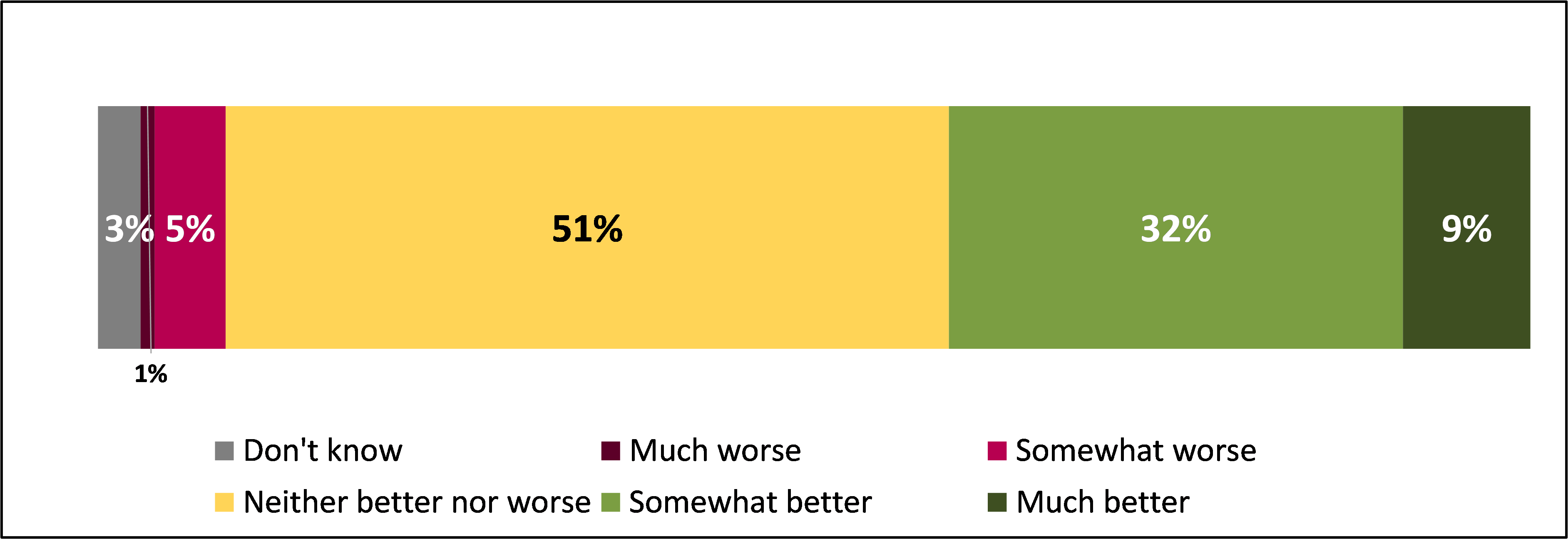
F1. Would you say that the introduction of PPDS food labelling requirements has made your or your child’s quality of life…? Base: All consumers who buy PPDS foods (1639).
There were no significant differences by country in terms of reported improvement in quality of life (England: 39%: Northern Ireland: 49%: Wales: 42%) while consumers in Northern Ireland were less likely than the average to report no change in their quality of life (40% vs 51%).
There were some subgroups of consumers who were more likely to have reported a change in quality of life. These included:
- Consumers with a child or children with a food hypersensitivity were more likely to have noted an improvement in their child’s quality of life than consumers who suffer from a FHS themselves (50% vs 39%), while those who suffer from a FHS themselves were more likely to have reported no change in their quality of life (52% vs 41%).
- Younger consumers aged between 18 and 34 were more likely to report an improvement in their quality of life than those aged 65 and over (47% vs 36%), while consumers aged 65 and over were more likely to report no change in their quality of life than both those aged between 18 and 34 and those aged between 35 and 64 (56% vs 46% and 50% respectively).
- Consumers with an allergy/ intolerance to a regulated allergen were more likely to report an improvement in their quality of life than those with an allergy/ intolerance to a non-regulated allergen only (41% vs 27%).
- Consumers who purchased PPDS foods sometimes or often (48% vs 35%) with consumers who purchased PPDS foods rarely or never being more likely to see no change in their quality of life than those that purchased PPDS foods sometimes or often (55% vs 46%).
Of those consumers who felt their quality of life had improved (footnote 3), around a third (34%) attributed this to food labelling improvements, just under a quarter (24%) attributed this to feeling safer and more confident in choosing foods that are safe to eat and a just over a fifth (19%) attributed this to it being quicker and easier to identify allergens. All reasons given for quality-of-life improvements are presented in Figure 6.8.
Figure 6.7 Reasons for improvements in quality of life in consumers with food hypersensitivities

F2. In what ways would you say the introduction of prepacked for direct sale (PPDS) food labels requirements made your / your child’s quality of life? Base: Consumers who have noticed an impact of PPDS labelling requirements on their quality of life (801). NB: responses under 6% have not been displayed.
Consumers who felt their quality of life had gotten worse (footnote 4) also gave reasons for this change, with the most common reason that they found their choices more limited (57%), that they required clarification on inconclusive or contradictory labelling (45%), and that staff still lacked knowledge on allergen information (28%).
Reflecting the survey findings, during qualitative interviews, many consumers spoke about how the labelling requirements have made a difference to their quality of life in terms of enhanced convenience and being able to make purchasing decisions more quickly.
"It makes such a difference to when I was first diagnosed (in 2000). Just giving up gluten, my first supermarket shop took 5 hours because there was no allergy labelling so you had to read every single ingredient and interpret that ingredient, because not everything was called wheat or gluten."
Consumer, England, Moderate hypersensitivity
“New labelling requirements have made it quicker to identify whether I can buy that product or not by checking the bold writing.”
Consumer, England, Severe hypersensitivity
Observed changes in FBO behaviour
Most consumers (60%) had not noticed any changes in FBO behaviour since the PPDS labelling requirements were introduced. Where changes had been observed, the most common were an increase in the availability of food made to order (20%) and a reduction in the availability of PPDS foods (18%). Some consumers had observed food that was previously sold as PPDS being packaged differently, 16% noting an increase in prepacked food and 14% noting an increase in non-prepacked food.
Figure 6.8 FBO behaviour changes noticed by consumers

E10. Since the introduction of PPDS food labelling requirements in October 2021, have you noticed any of the following changes? Base: Consumers that buy PPDS foods (1639).
There were differences among subgroups for consumers who have noticed business behaviour changes:
- Consumers in Wales were more likely to notice more food being available to order than those in England (26% vs 19%), as well as those with a non-regulated allergen only, who were more likely than those with a regulated allergen to notice this behaviour (29% vs 18%). Consumers with a FHS other than Coeliac disease were more likely than those with Coeliac disease to notice this behaviour (26% vs 15%), as well as those that buy PPDS foods often or sometimes, who were more likely than those that buy PPDS foods rarely or never (24% vs 17%). Finally, younger consumers aged between 18 and 34 were more likely than those aged between 35 and 64 and those aged 65 and over to report this behaviour change (26% vs 19% and 19% respectively).
- Consumers that buy PPDS food often or sometimes were again more likely to report noticing less PPDS foods available than those who buy PPDS foods rarely or never (20% vs 17%). Younger consumers aged between 18 and 34 were more likely than those aged between 35 and 64 to notice this change (22% vs 16%).
- Younger consumers aged between 18 and 34 were more likely than those aged between 35 and 64 and those aged 65 and over to report noticing more foods thought to have been put in packaging by another business (27% vs 15% and 12% respectively).
- Consumers in Wales were more likely to notice more food available without packaging than those in England (20% vs 13%), as well as those with a non-regulated allergen only, who were more likely than those with a regulated allergen (20% vs 12%). Consumers with a FHS other than Coeliac disease were more likely than those with Coeliac disease to notice this behaviour change (18% vs 10%).
Business behaviours experienced by consumers
One tenth (10%) of consumers who buy PPDS foods reported being asked to sign a waiver by an FBO when buying PPDS foods. Under one fifth of consumers who buy PPDS foods (18%) reported being asked whether they had a food hypersensitivity by FBOs, and under one fifth (16%) of consumers who purchase PPDS reported experiencing FBOs refusing to sell to them.
These behaviours were also reported by FBOs who sell PPDS foods and were aware of the PPDS requirements, with one tenth (9%) reporting asking consumers to sign a waiver when selling PPDS foods, just under two fifths (39%) reported asking consumers whether they had a FHS, and under one tenth (8%) have refused to sell PPDS foods to consumers with FHS.
However, for most consumers who had experienced these behaviours, they had done so more since the introduction of the new labelling requirements than before. As shown in Figure 6.9, over three-quarters (76%) of consumers who had been asked to sign a waiver had experienced that more than before the introduction of PPDS labelling requirements. (footnote 5) Just over two-thirds (69%) of those who had been refused service of PPDS foods had experienced that more, and just under a third (63%) of those who had been asked whether they had a food hypersensitivity when buying PPDS foods had experienced that more. (footnote 6)
Figure 6.9 Changes in frequencies of business behaviours by consumers who have experienced them since October 2021
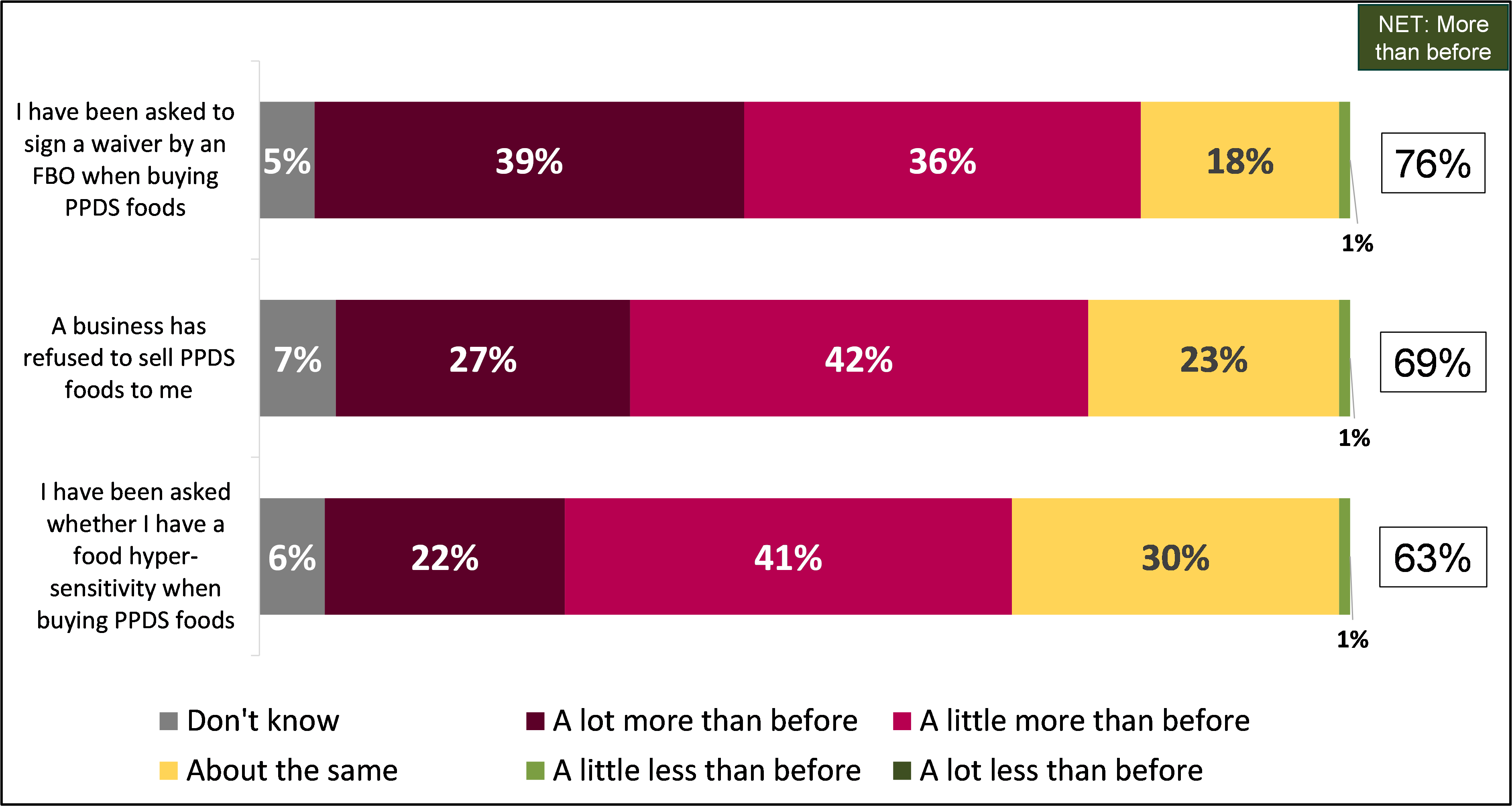
E12. And would you say you’ve experienced the following more, the same or less than before the introduction of PPDS labelling requirements in October 2021? Base: Consumers that experienced each behaviour in E11: being asked by a food business to sign a waiver relating to my or my child’s food hypersensitivity when buying PPDS foods (170), Being asked about whether I have or my child has a food hypersensitivity when buying PPDS foods (298), Being denied service or a business refusing to sell PPDS foods to me or for my child (257).
Younger consumers aged between 18 and 34 who had prior experience of FBOs asking whether they had a food hypersensitivity were more likely than those aged 65 and over (75% vs 51%) to report an increase in the frequency of this business behaviour since October 2021.
Consumers that had previously been refused service in FBOs in England were more likely than average (72% vs 69%) to have reported an increase in the frequency of this behaviour. Consumers with severe allergies were more likely to have reported that this behaviour had happened about the same as before than those with moderate allergies (27% vs 13%).
Food Business Operators
There was evidence of the PPDS labelling requirements having some negative effects on FBOs, particularly in terms of operating costs and administrative burden. However, for other FBOs the impact was more minimal, for example, for just under two fifths (37%) of FBOs there were no changes in terms of operating costs. There was also evidence that the implementation of PPDS labelling requirements had affected the types of food some FBOs sold and their approach to serving FHS consumers.
Impacts on FBO costs
Half (51%) of FBOs that sell PPDS foods and were aware of PPDS labelling requirements said their costs had increased because of the PPDS labelling requirements. For these FBOs, costs had tended to increase by ‘a little’ (38%) rather than ‘a lot’ (13%). Under two fifths (37%) of these FBOs reported their costs had stayed the same, while just 1% noted a decrease, as set out in Figure 6.10.
Figure 6.10 Extent to which costs increased due to the PPDS labelling

C3. To what extent, if at all, have the costs of the business changed because of any of the PPDS labelling requirements? Base: FBOs that sell PPDS and were aware of PPDS labelling requirements (766).
The proportion of FBOs that reported increased costs was broadly consistent across all four countries (England: 51%, Northern Ireland: 44%, Scotland: 52%, and Wales: 55%) and number of employees (1 to 5 employees: 54%, 6 to 10 employees: 48%, 11 or more employees: 48%). There was little variation by sector. However, catering FBOs (59%) and butchers (58%) were more likely than general retail businesses (45%) to report increased costs.
The most common reason given for increased costs was investment in equipment or materials (55%), followed by time spent preparing and applying labels to PPDS foods (36%), and time spent checking or updating labels (27%). Causes of increased costs are shown in Figure 6.11.
Figure 6.11 Reasons for increase in costs due to the PPDS labelling requirements

C4. What has caused costs to increase? Base: FBOs that have seen increased costs due to PPDS labelling requirements (394). NB: responses under 6% have not been displayed.
Investment in equipment or materials was the most common reason given for increased costs, more likely for mid-size FBOs, with those with between 6 and 10 employees more likely than FBOs with between 1 and 5 and 11 or more (67% vs 51% and 53% respectively). Furthermore, catering sites were more likely than retail sites to have incurred additional costs through time spent preparing and applying labels to PPDS foods (41% vs 31%) as well as FBOs with between 6 and 10 employees who were more likely than FBOs with 11 or more employees (41% vs 27%).
During qualitative interviews, most FBOs that had experienced an increase in costs explained that the most significant cost was the initial outlay on hardware and software. Many continued to face higher costs (e.g. the cost of materials and staff time to prepare and check labels of packaging) following this initial investment, but these were less significant that the set-up costs and did not pose an issue to the survival of the business.
“It cost nearly £2,000 for equipment … the time taken to label has reduced to nearly pre-PPDS levels, however the cost of labels is more expensive now as they're bigger. We have not increased prices charged to customers as a result.”
FBO, England, Caterer, 6 to 10 employees
“The cost implication has changed, because we now have to print two labels.”
FBO, England, Caterer, 1 to 5 employees
Changes to business practices
Most FBOs (79%) that sold PPDS foods and were aware of the PPDS labelling requirements had made some changes to their business practices since October 2021. (footnote 7) The most common change was starting to apply Precautionary Allergen Labelling (PAL) to PPDS foods (58%), followed by starting to ask customers if they had food allergies or intolerances at the point of sale (39%). More than a fifth (22%) of businesses changed the foods they sell, with 17% selling food that was previously PPDS as non-prepacked food, and 15% starting to sell more food packaged by other businesses. Changes in business practice are shown in Figure 6.12 below.
Figure 6.12 Self-reported changes in business practices since the introduction of PPDS labelling requirements

C5. Has the introduction of PPDS labelling requirements caused the business to do any of the following…? Base: FBOs that sell PPDS and were aware of PPDS labelling requirements (766).
There were only minor differences in changes made by country, sector and size.
- FBOs in England were more likely (59%) to have started to add PAL to their PPDS foods than FBOs in other countries (Northern Ireland 41%, Scotland 54%, and Wales 53%).
- General retail sites were more likely (24%) than bakers (8%), butchers (11%), and restaurants and cafés (11%) to have started to sell more foods packaged by other businesses.
- Restaurants and cafés were more likely than catering FBOs to ask customers to with food allergies or intolerances to sign an allergen waiver or disclaimer before agreeing to serve them (13% vs 5%).
- FBOs in England were more likely than those in Scotland to ask consumers if they had a food hypersensitivity at the point of sale (40% vs 31%). Catering FBOs were also more likely than retail FBOs to display this behaviour (51% vs 28%), underlined by catering businesses and restaurants and cafés (50% and 52% respectively). Smaller FBOs with between 1 and 5 employees were also more likely than those with between 6 and 10 and those with 11 or more to display this behaviour (47% vs 34% and 30% respectively).
During qualitative interviews, FBOs that had started to sell more prepacked and non-prepacked foods since the introduction of PPDS labelling requirements explained that the reason for this was to remove certain products from falling within the PPDS labelling requirements. The justification behind this was that the business would be unable to take on the additional administration and costs of packaging and labelling all PPDS products.
“We buy lower quality ones in from a supplier now. PPDS was the main reason because there is now much more labelling and packaging to do.”
FBO, England, Caterer, 11 or more employees
Of the FBOs that had started to sell more non-prepacked foods (48%, n=133), 17% reported that this change had little or no impact on the business, while of the FBOs that have started to sell more prepacked foods (15%, n=111), 22% reported that this change had little or no impact on the business. Where these changes did have reported impacts, the most common mentioned by those that had started to sell food that was previously PPDS as non-prepacked foods was higher pressure on the business (13%), and increased consumer confidence or satisfaction (10%).
Amongst those that started to sell more prepacked food, the most common impact was increased costs or decreased sales (21%).
Almost all Local Authorities (LAs) (97%) had observed FBOs making changes to their practices since the introduction of PPDS labelling requirements. As presented in Figure 6.13, the most common change LAs had observed was FBOs starting to sell food that was previously PPDS as non-prepacked food (79%), followed by FBOs starting to apply PAL warnings to PPDS food labels (61%) and FBOs starting to ask customers if they had food allergies or intolerances at the point of sale (57%).
Figure 6.13 Self-reported and LA observed changes in business practices since the introduction of PPDS labelling requirements

FBO survey, F1. Since the introduction of PPDS food labelling requirements in October 2021, have you observed businesses doing any of the following? Base: All LAs (126).
Compared with FBO self-reported changes to their business practices (see Figure 6.12), LAs were much more likely to have observed FBOs starting to sell food that was previously PPDS as non-prepacked food (79% LAs vs 17% FBOs), FBOs starting to sell more food packaged by other businesses instead of PPDS foods (51% LAs vs 15% FBOs) and FBOs stopping serving customers with food hypersensitivities (37% LAs vs 8% FBOs), shown in Figure 6.13. These differences may have been caused by a self-report bias amongst FBOs, as well as the fact that they are reporting on a larger sample and may be more likely to find incidence. However, the differences regarding the types of food products sold, may also stem from issues with FBO comprehension of the definition of different categories of food (e.g. PPDS, prepacked and non-prepacked).
Reasons FBOs have stopped selling PPDS foods
Amongst the FBOs that had stopped selling PPDS foods after October 2021, a fifth (21%) attributed this to the PPDS labelling requirements. (footnote 8) More common reasons were changes to consumer preferences or the food not selling well (32%) and resource pressures (e.g. time, money, or space; 26%). Amongst those that attributed stopping the sale of PPDS foods to the labelling requirements (n=12), three said this was due to time taken to introduce and update labelling for PPDS foods . Reasons for stopping selling PPDS foods mentioned are shown in Figure 6.14 below.
Figure 6.14 Factors which played a part in FBOs decision to stop selling PPDS

D2. What factors played a part in the decision to stop selling PPDS foods? Base: FBOs that previously sold PPDS foods but have stopped (62).
Local Authorities
Most LAs (92%) reported an increase in at least one aspect of their work because of the introduction of PPDS labelling requirements. The most common increase reported related to the time spent providing advice and support to businesses (86%). A majority of LAs also cited an increase in both the time to conduct the inspections themselves (82%), the associated administrative work relating to inspections (73%) and time spent resolving non-compliance and taking enforcement/follow-up actions (67%).
Figure 6.15 Extent to which certain areas of LA responsibility have increased as a result of the introduction of PPDS labelling requirements

E1. To what extent have the following increased or decreased as a result of the introduction of PPDS labelling requirements on 1 October 2021? Base: All LAs (126).
As presented in Table 6.1, amongst those that reported an increase in time spent conducting inspections, conducting administrative work associated with inspections and conducting enforcement/follow up action, LAs typically estimated that time had increased by less than 30 minutes per inspection.
Table 6.1 : Extra time spent by LAs on inspections and the associated administrative work
| Time increase | Extra time per inspection spent inspecting food businesses due to the introduction of PPDS labelling requirements | Extra time per inspection spent on administrative work | Extra time per inspection spent conducting enforcement/follow up action |
|---|---|---|---|
| Less than 15 minutes | 26% | 34% | 14% |
| Between 15 and 30 minutes | 53% | 43% | 25% |
| Between 30 and 45 minutes | 11% | 9% | 13% |
| Between 45 and 60 minutes | 4% | 4% | 0% |
E2. How much extra time per inspection has been spent inspecting food businesses due to the introduction of PPDS labelling requirements? Base: LAs who have spent more time on inspections due to PPDS labelling requirements (103). E3. How much extra time per inspection has been spent on administrative work (e.g. inputting on data systems, writing advice emails and letters) associated with inspections since the introduction of PPDS labelling requirements? Base: LAs who have spent more time on administrative work associated with inspections due to PPDS labelling requirements (92). E4. Roughly, how much extra time per inspection has been spent conducting enforcement/follow up action with food businesses found not to be compliant with PPDS labelling requirements? Base: LAs who have spent more time on enforcement (84).
During the qualitative interviews many LAs spoke about how the increase in time spent conducting inspections and administrative work associated with inspections was borne out of a lack of capacity to undertake the additional checks, paperwork and re-visits.
“There is more involvement with the businesses; more time spent so providing information, going over information and the follow up in writing after a visit … admin increased quite a bit with regards to follow ups and information provided … we have other duties but food takes priority so things like health and safety slides to the bottom a wee bit.”
Local Authority, Scotland
During the qualitative interviews, LAs explained that the additional time spent on enforcement/follow-up actions had typically been spent on signposting to and delivering advice and guidance. As detailed in Chapter 5, many LAs explained that their focus for the first year of the PPDS labelling requirements being in effect had been to educate FBOs and support them with compliance rather than pursue enforcement. Only a few LAs reported taking formal enforcement action. For example, in instances where FBOs did not need their advice or were found to still be non-compliant at the point of re-visit.
“I can’t see us rushing to prosecute on this. If I advise them to take it off sale, then that’s avoided me going through a whole lot of forms and bureaucracy just to get the same result.”
Local Authority, Wales
Figure 6.16 Case study: Effects of PPDS labelling requirements (accessible version)
An English Local Authority reported an increase in the amount of time spent conducting inspections, completing administrative work associated with inspections and resolving non-compliance since the PPDS labelling requirements were introduced.
The increased time spent on these tasks was attributed to a variety of factors, including more paperwork for officers to complete, an increase in the volume of samples collected during inspections and a high rate of non-compliance amongst FBOs in the area. It was estimated that there have been an additional 27 enforcement actions since 1 October 2021 compared the previous year.
“We've increased the amount of samples that we take, and I think it was unexpected that we would find such a high level of non- compliance.”
The Local Authority explained that many FBOs had taken steps to avoid the PPDS labelling requirements by packaging products differently. For example, selling sandwiches in an unsealed bag.
“Businesses are generally doing everything they can to avoid being caught, so they are making up to order and just sticking it loose in a paper bag.”
A farm shop, located in the same Local Authority with 11 or more employees.
The operating costs of this FBO have increased since the introduction of PPDS labelling requirements. This was attributed to the need to invest in new processes and dedicating labour to labelling and packaging. The FBO has responded by increasing their prices.
“It is manual labour so making sure we have processes in place, and physical labelling and packaging, it adds up very quickly … Generally we are passing it on to the consumer because we have higher prices.”
The FBO still sells PPDS food, but in an attempt to reduced administrative burden and increases costs they had also started to sell some foods that were previously PPDS as loose foods.
“The steps we took were to put products behind the counter and every counter or display where we have loose products, we have signage that says ask a member of the team for allergens … and baked products so biscuits, tarts and quiches.”
-
42% of consumers that buy PPDS foods feel the availability of the information needed to identify a food that may cause an unpleasant reaction (n=683).
-
40% of consumers that buy PPDS foods agreed that their confidence in purchasing PPDS foods had increased since the introduction of the PPDS labelling requirements (n=660)
-
40% of consumers who buy PPDS foods reported an improvement in their quality of life (n=659)
-
6% of consumers that buy PPDS foods reported their quality of life had gotten worse since the introduction of PPDS labelling requirements (n=102).
-
10% of consumers that buy PPDS food had been asked to sign a waiver relating to their food hypersensitivity when buying PPDS foods since October 2021 (n=170).
-
16% of consumers that buy PPDS food had been refused service of PPDS foods since October 2021 (n=257). 18% of consumers that buy PPDS food had been asked whether they had a food hypersensitivity when buying PPDS since October 2021 (n=298).
-
83% of all FBOs sold PPDS foods and were aware of the PPDS labelling requirements (n=766).
-
8% of FBOs reported that they stopped selling PPDS food since October 2021 (n=62).
The PPDS legislation was brought in following the death of Natasha Ednan-Laperouse to ensure that a similar tragedy could not happen again. It was intended to reduce the risk of consumers with food hypersensitivities (FHS) suffering an adverse reaction due to having consumed a food without knowing the allergens it contains. This research has looked into how the legislation has been implemented to date and its effects on FHS consumers as well as on those charged with enacting and enforcing the legislation; Food Business Operators (FBOs) and Local Authorities (LAs).
The legislation has led to positive change for some consumers, though there is room for further change. Two fifths (42%) of consumers saw an improvement in the availability of information they need to identify whether PPDS foods may cause an unpleasant (or dangerous) reaction for them. Some consumers (40%) feel more confident in buying PPDS foods, giving them an increased quality of life (39% of consumers). This was particularly the case among younger consumers (47% of 18-34 year olds) and those who purchased PPDS foods more often (48% who buy PPDS often/sometimes). In addition, around one in five consumers (18%) with a severe allergy or intolerance have started buying PPDS foods more often as a result of the legislation.
However, there is still some way to go in ensuring that the availability of necessary labelling information is consistent for FHS consumers. Almost a quarter (24%) of FBOs reported not being compliant with all aspects of the PPDS legislation, with smaller independent businesses and those in the catering sector, particularly takeaways, more likely to be struggling. These types of businesses tended to have lower awareness of the types of food covered by the labelling requirements. They also face shifting supply chains and, for takeaways especially, a mixture of direct and indirect sales channels and language barriers.
There have also been some unintended consequences of the legislation. Almost a fifth (17%) of FBOs have started to sell food that was previously PPDS as non-prepacked, meaning FHS consumers are missing out on the benefits of better labelling for these foods. And almost three-quarters (72%) of FBOs have started to apply Precautionary Allergen Labelling to their PPDS foods, which carries a risk of reducing the food available to FHS consumers, who are often very concerned about cross-contamination.
FBOs and LAs have invested time and money into supporting the legislation. LAs have focussed on providing support and advice to FBOs rather than enforcement action against non-compliant businesses while the legislation is still in its infancy, and FBOs have found this support useful. LAs feel that further action is still needed to improve compliance among FBOs however, including general training, guidance on compliant packaging and best practice in terms of labelling (respectively, 75%, 67%, and 65% of LAs who think FBOs didn’t find compliance easy). One in five LAs (22%) would also welcome being provided with greater clarity on what food products are covered by the PPDS legislation.
In terms of potential refinements to the legislation, two thirds of LAs (67%) felt that suppliers and wholesalers should be mandated to notify businesses about recipe changes. Around half (55%) of LAs also felt that the requirement to label PPDS foods with full ingredient lists should be removed, with the emphasis instead being put on allergens.
It will be important to monitor the implementation of the PPDS legislation over the long-term to see if any refinements to the legislation and support provided to FBOs and LAs result in improved understanding and compliance, with resulting benefits for the lives of FHS consumers.